- Home
- Collections
- GARNER V
- Books
- City of Napier New Zealand Year Book
City of Napier New Zealand Year Book
[Advertisements]
MONARCH MOTORS LTD.
SALES Ford SERVICE
British and Canadian Cars, Trucks and Tractors
Up-to-date Breakdown Service – Specialised Lubrication
GENUINE FORD PARTS MODERN PREMISES
HASTINGS STREET Phone 4937 NAPIER
SIGHT-SEEING TOURS
FROM NAPIER
“TE MATA’ TRIP (Half-day) Fare 7/6
A delightful 50-mile drive covering the Napier-Hastings district, and including the magnificent panorama from Te Mata Peak.
“CORNWALL PARK” TRIP (Half-day) 6/-
A three-hour drive through Napier, Hastings and environs including a short stop for refreshments at the delightful Cornwall Park in Hastings. Covers a different route and embraces places of interest not possible to include in the “Te Mata” trip.
For timetables or further particulars, see –
HAWKE’S BAY MOTOR CO. LTD
DICKENS STREET
(Near G.P.O.)
Phone 2111
THE HOME OF
DOMESTIC APPLIANCES
AGNEW’S
PHONE 5253
EMERSON ST. NAPIER
Kelvinator Refrigerators, Bendix Home Laundries, Goblin “Ace” Vacuum Cleaners, Whiteway Washing Machines Floor Polishers, Ironing Machines Remington Electric Shavers
For Practical and Acceptable
GIFTS
See Our Range of Electrical Appliances and Kitchen Plastic Ware .
Use our Lay-By or Easy Term Plan
AGNEW REFRIGERATION
BRANCHES AT
NAPIER – HASTINGS – PALMERSTON NORTH
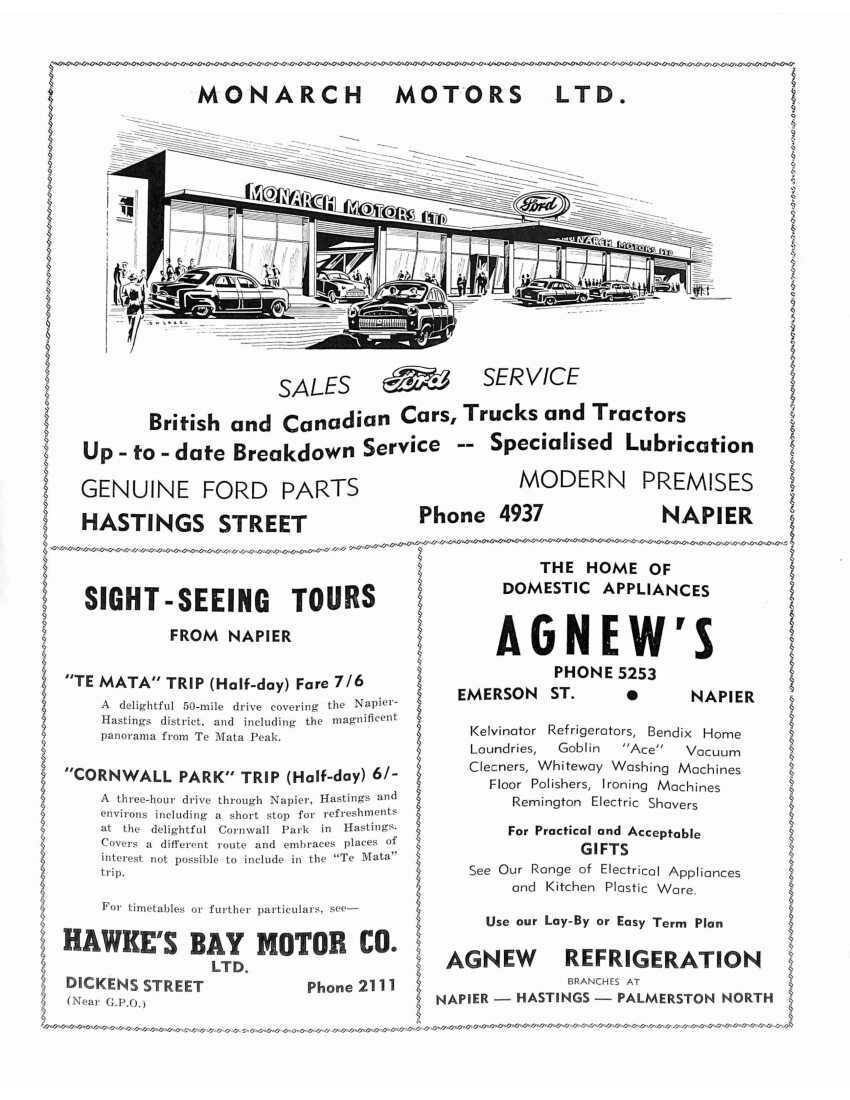
Page One
[Advertisements]
NAPIER MUNICIPAL ELECTRICITY DEPARTMENT
VISIT OUR SHOWROOMS AND INSPECT OUR DISPLAY OF
MODERN ELECTRIC RANGES
WE STOCK ALL ELECTRICAL HOUSEHOLD APPLIANCES
WE REPAIR ALL ELECTRICAL APPLIANCES PROMPTLY
PHONE 2843 SHOWROOMS KELVINATOR DISTRIBUTORS DAY OR NIGHT PHONE 2234
All Classes of Timber, including Totara, Rimu, Matai & White Pine
Radiata Framing, Weatherboarding & Flooring readily available, graded & dressed to N.Z. Standard Specifications
TUCK BROS (NAPIER) LTD
SAWMILLERS
Timber & Hardware Merchants – Joinery Manufacturers
HYDRABAD ROAD, NAPIER
Phone 5205 P.O. Box 330
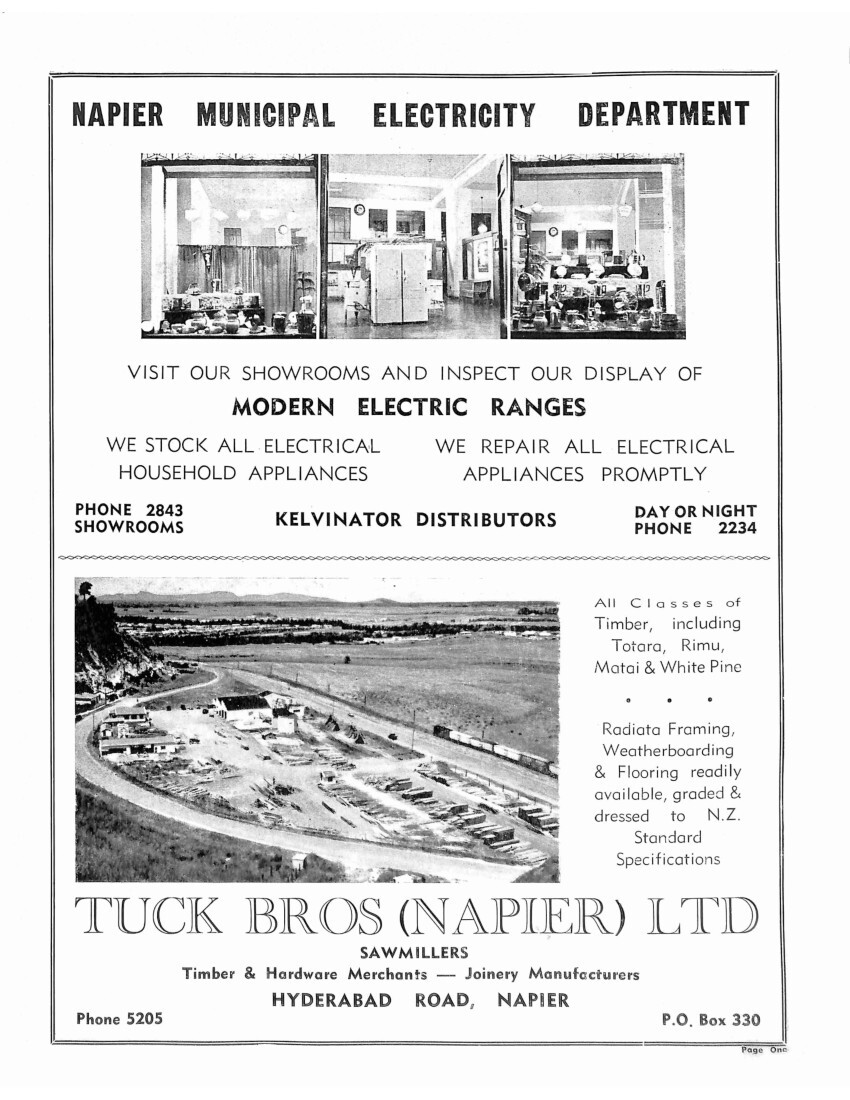
Page Two
[Advertisement]
THE NAPIER CITY COUNCIL
OFFERS UNIQUE HOLIDAY AMENITIES
FOR TOURISTS AND VISITORS
AERATED HOT SALT WATER BATHS
The wonderful curative and tonic properties of the waters of the Napier hot salt water baths are renowned throughout New Zealand. While proving beneficial – often effecting permanent cures – for rheumatic complaints, they are equally effective, too, as an invigorating tonic for the healthy.
NEW STAINLESS STEEL AND PORCELAIN BATHS HAVE RECENTLY BEEN INSTALLED AND THE BATHROOMS RE-MODELLED AND MODERNISED.
Visitors to Napier should telephone (Napier 2477) for appointments for a course of hot salt water baths.
TEPID SALT WATER SWIMMING POOL
Chemically purified and filtered with the latest equipment, the crystal clear waters of the Napier open air swimming pool are heated to provide summer and winter bathing at comfortable temperatures.
Spend Your Holidays at Napier
IN COOL SUMMER BREEZES … OR IN WINTER SUNSHINE

Page Three
FOREWORD
The glorious climate of Napier – both in summer and winter – together with its very attractive marine parade, its amenities for tourists and its modern business area have attracted industry, permanent residents and visitors to the city for very many years.
The third largest exporting port in New Zealand, and the “clearing house” for large quantities of the high quality produce of Hawke’s Bay, the City is one of the largest cross-bred wool centres in the world.
The demand for industrial and residential sites has been so great during recent years the City Council has been called upon to service large areas for expansion. This development work continues to be carried out as fast as labour and materials are available. It is certain, therefore, that sections for all purposes will be available in well-designed modern suburbs and industrial areas to meet all future needs.
On behalf of the citizens of Napier I extend a very cordial welcome to all those who have yet to visit our modern city. Our regular visitors well know, of course, that they are always welcome.
E.R. SPRIGGS,
Mayor.
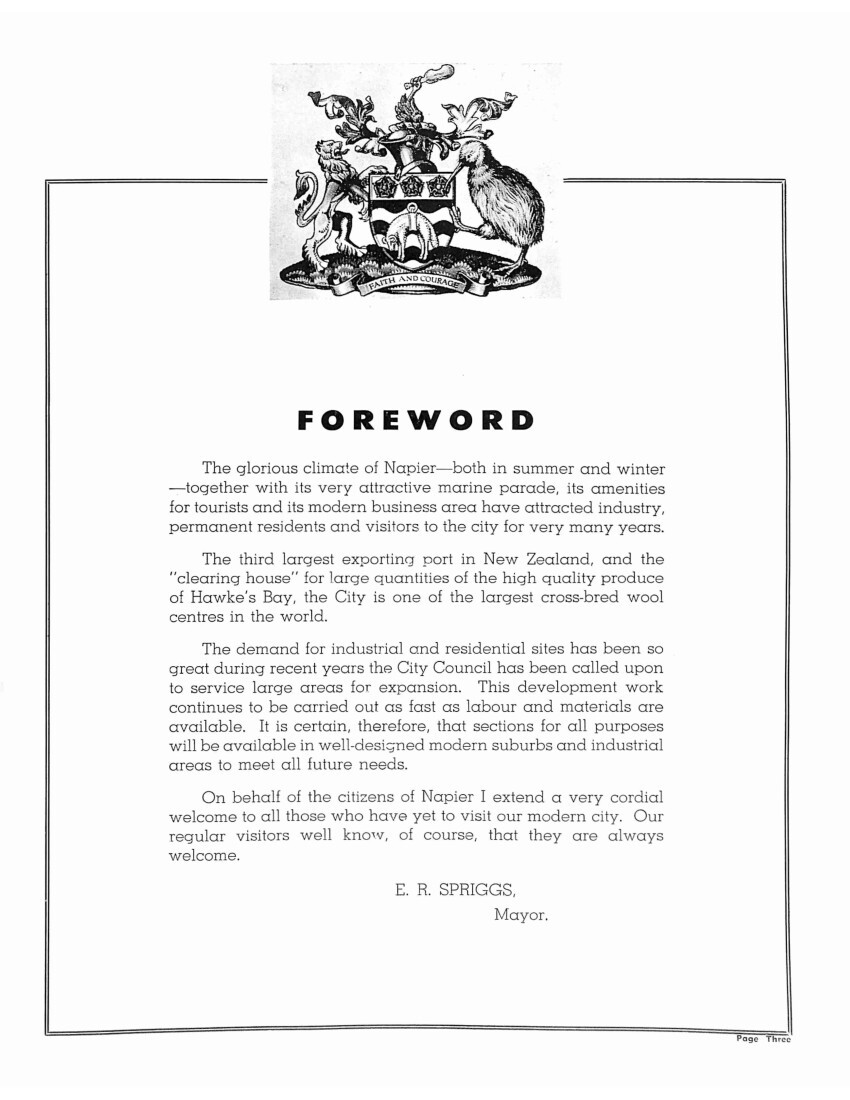
Page Four
[Advertisements]
Always With Something Different
The ROBYN Elizabeth
Art and Gift Shop
Dalton St., Napier
OPPOSITE
Hotel Central
Telephones
Business 3407
Private 2192
Principals: MR & MRS MILLAR SCOTT.
BURTS FURNISHERS LTD.
CARPETS
LINOLEUM
MATTRESSES,
FURNITURE
BLINDS
SOFT FURNISHINGS
OCCASIONAL FURNITURE
NURSERY FURNITURE
“Furnishers to the Discriminating”
PRESENTING – EACH AND EVERY DAY – A GALAXY OF FURNITURE AND FURNISHINGS
THE LARGEST FURNISHING STOCKS IN HAWKES BAY ALWAYS ON DISPLAY
BOX 45 HASTINGS STREET PHONE (All Depts.) 2969

Page Six
[Advertisements]
VISITORS! McGRUERS WELCOME YOU TO NAPIER
Be Sure To Visit Right In The Heart Of The Town
Nine Fully Stocked Departments to attend to all your needs, make shopping a real pleasure.
McGRUER’S – Napier’s Popular Drapers and Outfitters For Over Forty Years.
McGRUERS LTD Departmental STORE
Phone 3124 Box 6 NAPIER
NAPIER’S
MOST
MODERN
JEWELLERS
D. J. SILK
EMERSON STREET, NAPIER
WATCH SPECIALISTS PHONE 3429 DIAMOND MERCHANTS
WILLIAM HANNAH & CO. LTD.
FOOTWEAR SPECIALISTS
EMERSON STREET, NAPIER
PHONE 2047 P.O. BOX 48
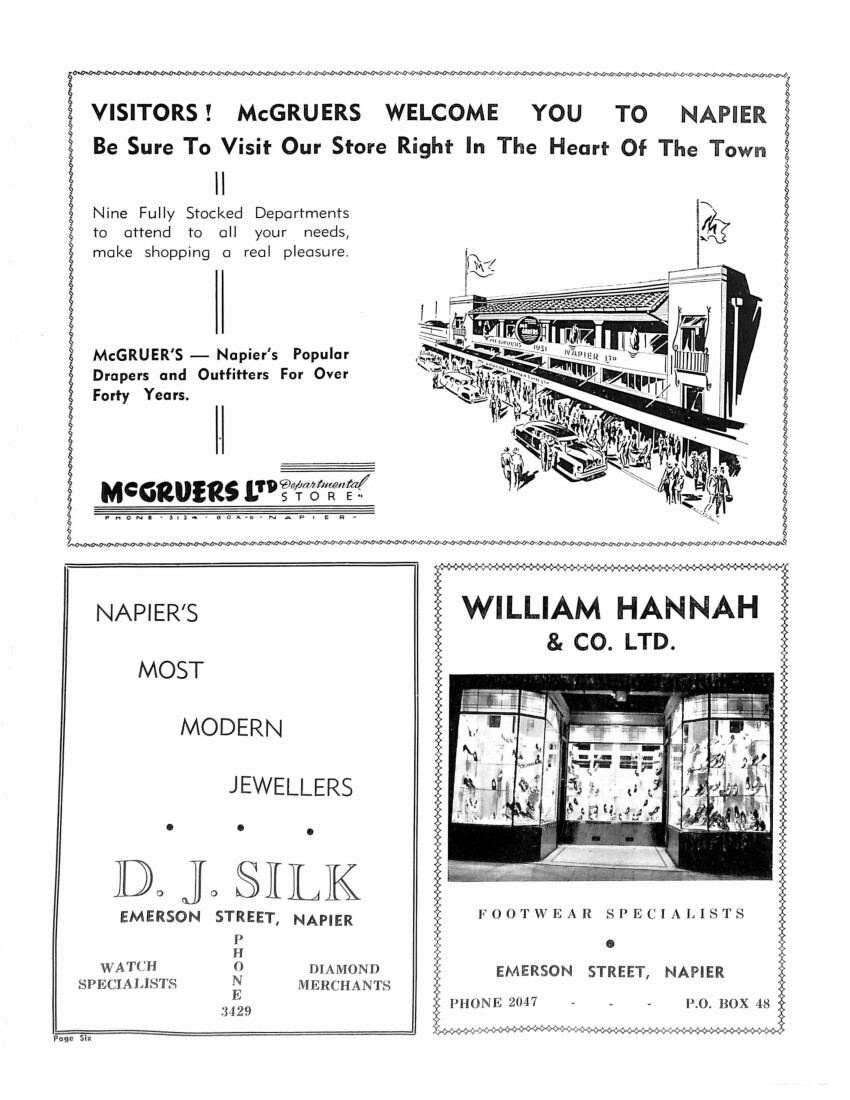
Page Seven
“Courage is the thing … All goes if courage goes”. What better words than these of J.M. Barrie could have been chosen for the inscription over the main archway in the colonnade on the Marine Parade, Napier? Was it not the striking courage of the people of the town which resulted in the creation of New Zealand’s newest city – mecca of the Dominion’s pleasure-seekers and tourists the world over? In February, 1931, Napier was ruined by earthquake and ravaged by fire which followed; yet, from the ashes, – little else was left – has risen a city more beautiful, more picturesque and more attractive to the visitor than any other in New Zealand. Napier can justly claim to be the Dominion’s newest city in two ways. City status was granted only recently and the buildings in its shopping and industrial area are little over 20 years old.
It would be neither wise nor opportune to discuss the great earthquake disaster at length here. To the people of Napier, and New Zealand, it has become a matter of history. The citizens, of course, still refer to matters as “before or after the ‘quake”, but now that the city has been completely rebuilt they are more concerned with the future of Napier than dwelling on its somewhat unfortunate past.
Photo caption – NAPIER’S MODERN CITY CENTRE.
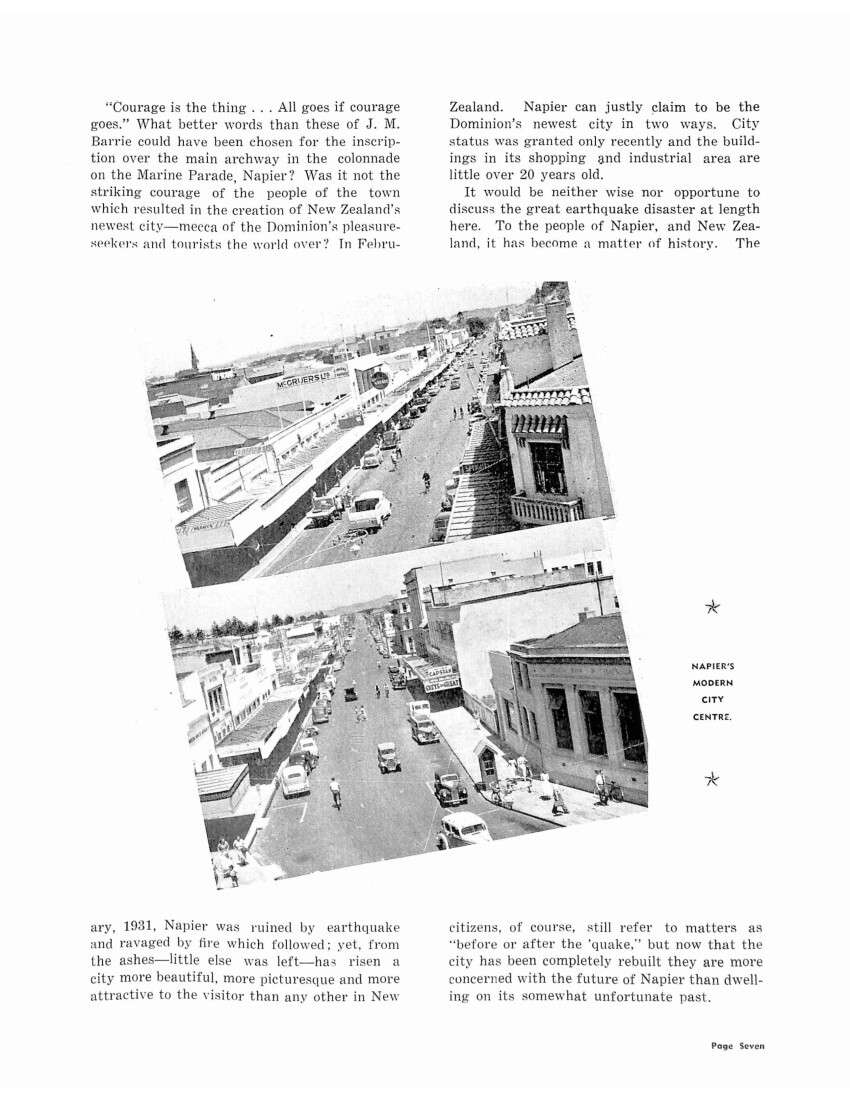
Page Eight
[Advertisements]
GOLDEN GATE FISH SUPPLIES (NAPIER) LTD.
FOR THE BEST FISH OF EVERY DESCRIPTION, FRESH DAILY FROM OUR OWN TRAWLERS.
FRESH RABBITS, POULTRY AND SMOKED FISH ALWAYS ON HAND
OYSTERS, WHITEBAIT, CRAYFISH IN SEASON
SEE HOW YOUR FISH SHOULD BE KEPT, DISPLAYED AND SOLD IN OUR
UP-TO-THE-MINUTE FISH EMPORIUMS
AND AT –
THE SQUARE,
PALMERSTON NORTH
PHONE 7049
GOLDEN GATE
FISH SUPPLIES
(NAPIER) LTD
EMERSON ST., NAPIER. PHONE 2287
NIGHT CAFE
NIGHT CAFE
(PIE CART)
NEXT TO EMERGENCY PETROL STATION
CLIVE SQUARE
OPEN FROM 5 P.M.
NIGHT – CAFE
NIGHT – CAFE
WE PACK AND POST WITH A GUARANTEE OF SAFE ARRIVAL
China
Crystal
Pottery
RANSON CHINA LTD.
EMERSON STREET
NAPIER
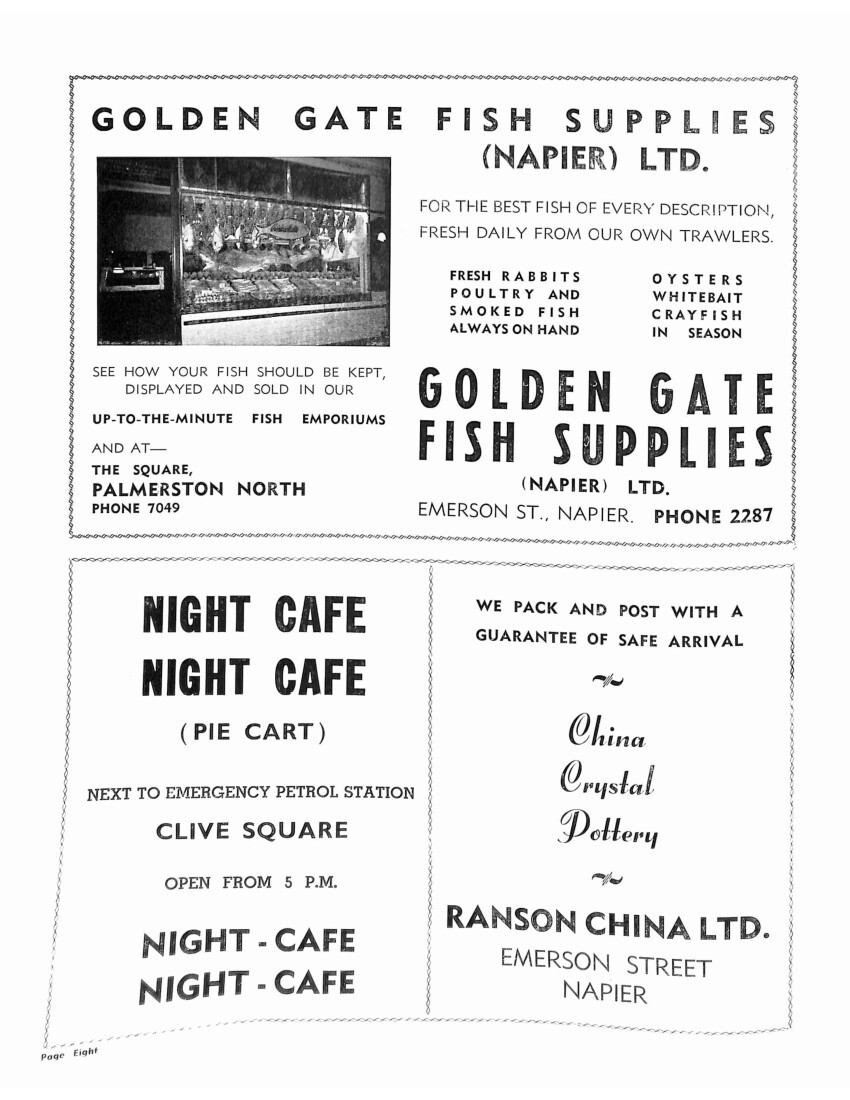
Page Nine
UNBOUNDED SUNSHINE
Napier is a seaside city blessed with unbounded sunshine and protected from the South and West by the Ruahine and Kaweka ranges. It has for its background the lower hills and fertile plains, the waters of the Pacific washing its shores, and is enclosed in the picturesque Hawke’s Bay with Cape Kidnappers as its southern boundary and Mahia Peninsula and Portland Island to the North. The course of the bay, from an artistic point of view, is altogether satisfying and well-nigh perfect. A distant view say from the top of the Havelock Hills (to the south-east of Hastings), gives you the picture of what seems to be an enchanted island. Napier, looking out as it does upon the great sweep of the Pacific, is not only beautiful for situation, but beautiful in itself as anyone may discover who takes the trouble to wander over the winding narrow hill roads, each turn presenting fresh glimpses of ever attractive views.
The climate is unsurpassed for its mildness and equableness, and can bear comparison with that of the Mediterranean or the Pacific Slope, or any other place in the world. It is well-night perfect.
It is just over 100 years since a tiny white settlement or trading station was established by “Barney” Rhodes at “Owready”, as Ahuriri was then and subsequently spelt and pronounced. The Rev. William Colenso, of the Church Missionary Society, arrived in 1844 and lived at Waitangi, but at that date there were no white people living in what we now know as Napier. The first resident was Mr. Alexander Alexander, who, in 1846, opened a trading store at Onepoto. Someone, in writing in the far-off days about Napier, described it as a “precipitous island of barren uninhabited ridges covered with fern and rough grass, dissected
Photo captions –
EMERSON STREET BEFORE THE TURN OF THE CENTURY.
OFF FOR A PICNIC IN GRANDMOTHER’S DAY!
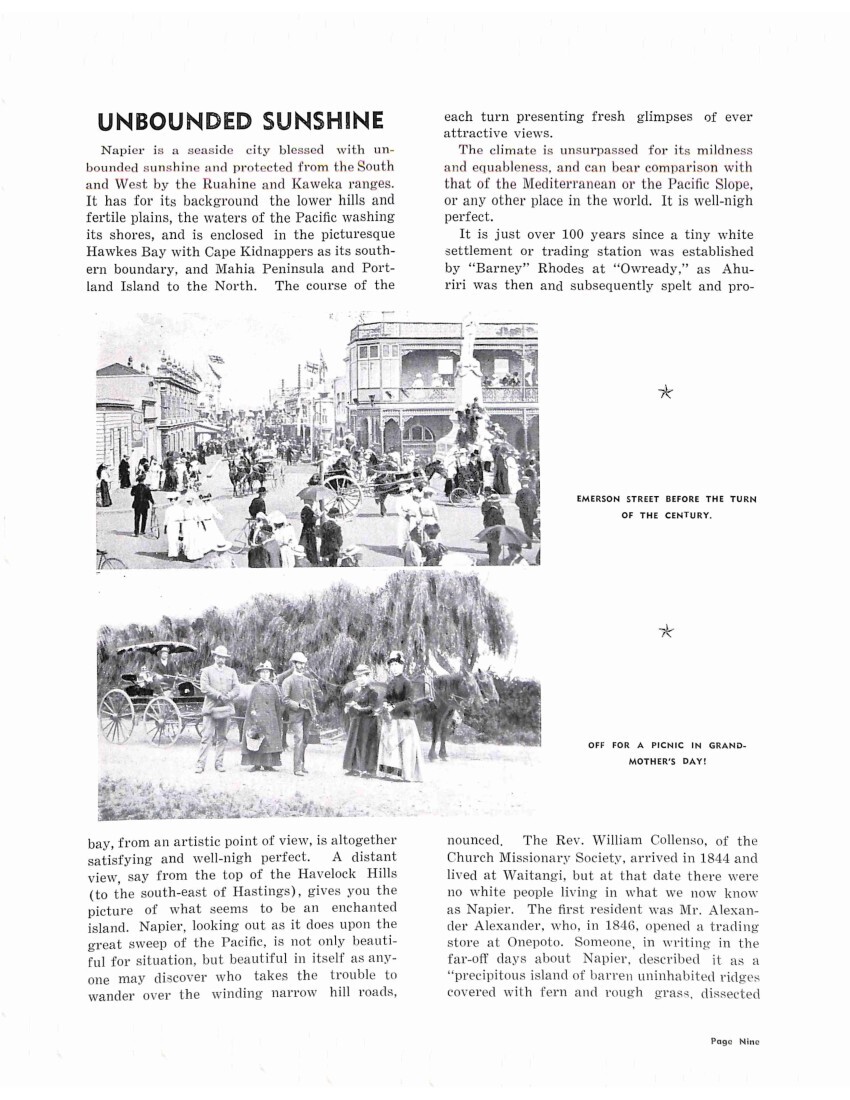
Page Ten
[Advertisements]
THE COUNTY HOTEL
Under Management:
MR & MRS DAVE ROSS
NAPIER’S LEADING PRIVATE HOTEL
FIRST CLASS ACCOMMODATION
EXCELLENT CUISINE
CENTRALLY SITUATED
Phone 3237 P.O. Box 191
Emerson St.
NAPIER
PAINTING
AND
DECORATING
WHETHER THE JOB IS AS LARGE AS THE ONE WE DID ON THE OUTSIDE OF THE T & G BUILDING (OPPOSITE)
OR
PROTECTING WITH PAINT THE OUTSIDE OR RENOVATING THE INTERIOR OF YOUR HOME.
OUR PAINTING DEPARTMENT IS AT YOUR SERVICE
ERIC WIIG & CO. LTD.
SUPPLIERS OF PAINT, WALLPAPER & GLASS
PAINTING CONTRACTOR & DECORATORS.
41 KENNEDY ROAD. NAPIER
PHONE 2945 P.O. BOX 404
LEADING SUPPLIERS OF
BEST QUALITY FRUIT
DIRECT
FROM ORCHARDS
All produce kept garden fresh in our modern refrigerated store
LOO KEE & CO.
EMERSON STREET,
NAPIER
PHONE 2763 P.O. BOX 121
FRESH, CRISP VEGETABLES
GROWN
AT OUR 15-ACRE
BAY VIEW GARDEN
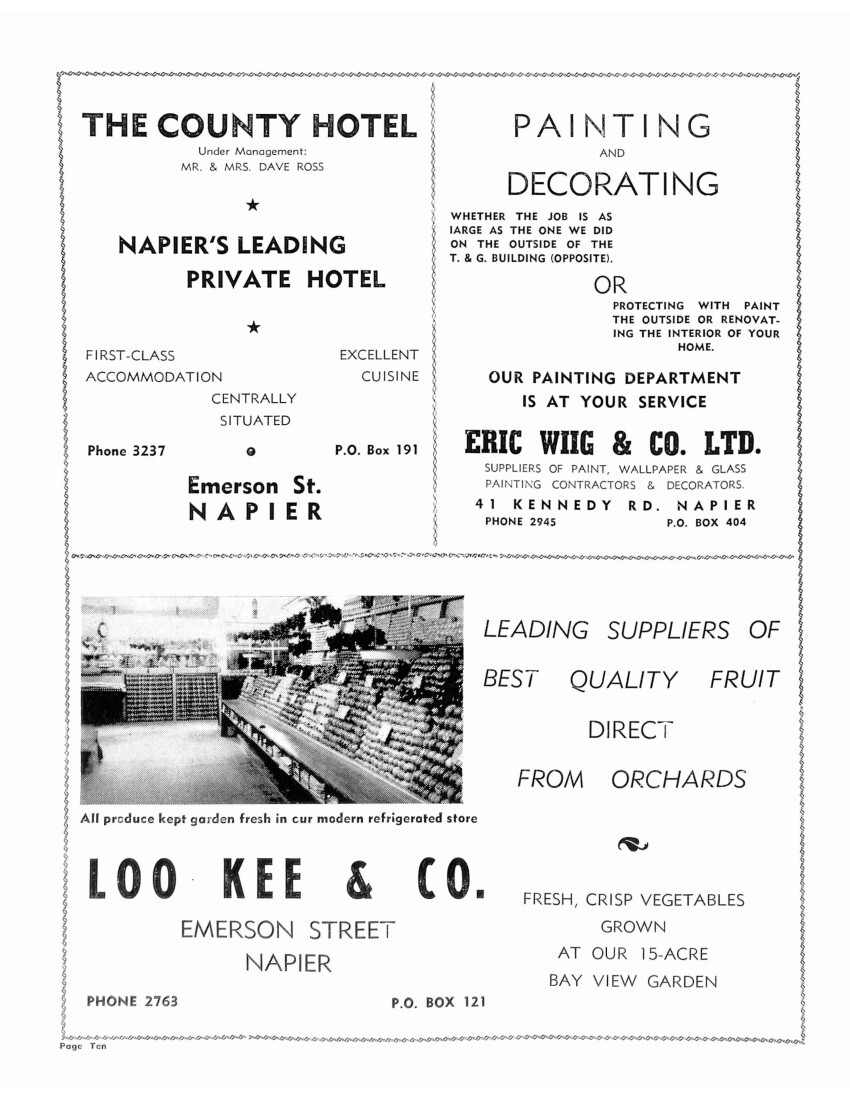
Page Eleven
by gorges, and ravines, with a narrow strip of shingle skirting the cliffs, and joined to the mainland by a five-mile shingle bank.” The main track along the shingle bank to the South was surfaced with limestone and became known as “White Road.”
The first road or track made, however, was up the hill from Onepoto Gully and then down through what is now known as Chaucer Road. With the sea on two sides, what lay beyond Scinde Island to the south and west were “everlasting swamps and ponds”, and to
Photo captions –
NAPIER’S WELL-KNOWN T. & G. BUILDING ON THE MARINE PARADE.
THE T. & G. CLOCK BELLS.
THE NAPIER CITIZENS’ BAND PLAYING IN THE SOUND SHELL.
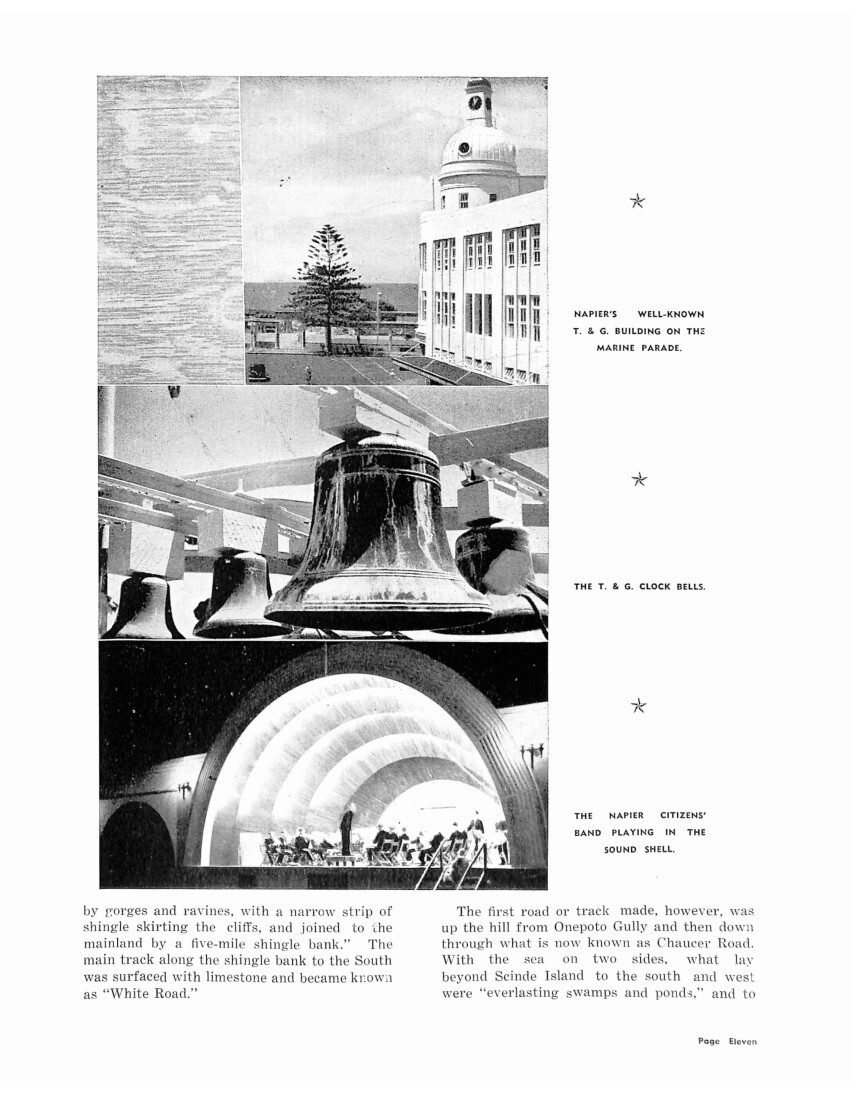
Page Twelve
[Advertisements]
MURRAY ROBERTS & CO. LTD.
PASSENGER & FREIGHT SHIPPING AGENTS
Agencies:
SHAW, SAVILL & ALBION LINE Via Panama
Also via Australia & South Africa
ABERDEEN & COMMONWEALTH LINE Via Australia and Suez
PENINSULA & ORIENTAL STEAM NAVIGATION CO. LTD (Tourist Class only) Via Australia and Suez
BLUE FUNNEL LINE Via Australia and South Africa
MATSON LINE To United States of America
AUSTRALIAN – ORIENTAL LINE & CHINA NAVIGATION CO. (Joint Services) To Far East
FARES AND FREIGHT RATES ON APPLICATION
Tennyson St., Napier Telephone 2511
Telegraphic Address “Hammerless”
PORTER’S
QUALITY MEAT
STORE
For
HIGHEST QUALITY MEATS
Telephone 2768
CNR. COOTE & FRANCE ROADS
NAPIER
When in Napier
You are assured of
FIRST-CLASS SERVICE
At
GEE MOTORS
LTD.
PETROL CAR WASHING OILS
TYRES LUBRICATION REPAIRS
PHONE 3249
AGENTS: Lanchester and Daimler Cars.
SHAKESPEARE RD., NAPIER

Page Thirteen
tell the story of the district would be to relate how the enterprise and determination of the earlier settlers drained the swamps and filled in the ponds and slowly but triumphantly extended the borders of Napier.
Mataroahou, the Native name of what became known as Scinde Island, was purchased from the Maoris in 1885 for the sum of £50. Mr Alfred Domett arrived at Ahuriri in 1854 as Commissioner of Crown Lands and had a large hand in the planning of the Napier that was to be. Being a man of letters, he called many of its streets after the names of British poets and writers so that to-day such well-known names as Shakespeare, Byron, Browning, Chaucer and a host of others are constantly in the minds and before the eyes of Napier’s citizens. The first sale of town section took place in 1885. In connection with Maori troubles, a detachment of the 65th Regiment was camped in Onepoto Gully in 1858. Subsequently, it shifted up the hill to the site of the present Public Hospital on which barracks had been erected and the hill was long known as Barrack Hill. Just over the way from the barracks a little street was named after the regiment – 65th St. It was the advent of Sir Charles Napier’s 65th Regiment which resulted in the town receiving its present name. It was also responsible for the Indian flavour which permeates through so many of the place names in Napier itself and in the surrounding district. Clive, Meanee [Meeanee], Hyderabad, Scinde – and many others appear on the map – all reminders of the British conquest of India in which the 65th Regiment had previously taken part.
Through the engineering skill of a company of men, the large area of swamp and ponds previously referred to was made fit for occupation and habitation. The swamp-land was gradually reclaimed, and what is now known as Napier South came into being. This gave the growing town a chance to expand, but the expansion was so great and so rapid that not many years had passed before building sections were once again at a premium. The nearest area of dry land suitable for building purposes appeared to be the Greenmeadows – Taradale area, and citizens began to turn their eyes in this direction. The narrow shingle spit of Westshore slowly commenced to grow as a seaside resort, and the wide expanse of water between the spit and the Poraite foothills – known as the inner harbour – proved an ideal home for the Sailing Club. The beach on the seaward side of the shingle spit, however, was uninviting. The water was deep immediately off-shore and the beach was completely lacking in sand.
At this time, Napier was a cribbed, cabined and confined town with no prospect of expansion. The town itself was a maze of old buildings, set along narrow dingy streets through which trams made their noisy way. Looking back to those days one can realise that the
Photo caption – NEW ZEALAND’S NATIONAL BIRD, THE KIWI, MAY BE SEEN AT THE GAME FARM AT TARADALE.

Page Fourteen
[Advertisements]
Alsop’s Grocery
PHONE 2057 PHONE 20576
FOR
DELIVERY QUALITY SERVICE
ALSOP’S GROCERY
HASTINGS STREET, NAPIER
C. C. WILLIS
F.R.E.I.(N.Z.)
PROPERTY EXCHANGES THROUGHOUT NEW ZEALAND
Mortgages Arranged on Properties
Agent – General Accident, Fire & Life Assurance Corpn. Ltd.
PHONES: OFFICE 2412 RES. 2108
GLADSTONE BLDGS., TENNYSON ST.
NAPIER
NAPIER’S MODERN TAXI SERVICE
PHONES
2733 – 3767
TWENTY-SEVEN MODERN RADIO EQUIPPED CARS AT YOUR 24 HOURS’ CONTINUOUS SERVICE.
WEDDINGS, FUNERALS, LONG TRIPS, SIGHT-SEEING TOURS A SPECIALTY.
NAPIER TAXIS
LIMITED
TAIT’S SHOE STORES
CENTRAL HOTEL BUILDINGS
EMERSON STREET
Leaders in Fashion Footwear!
SPECIALISTS IN
SPORTS FOOTWEAR
SHOES FOR THE FAMILY
STYLE DURABILITY COMFORT
OUR PERSONAL GUARANTEE WITH EVERY PAIR
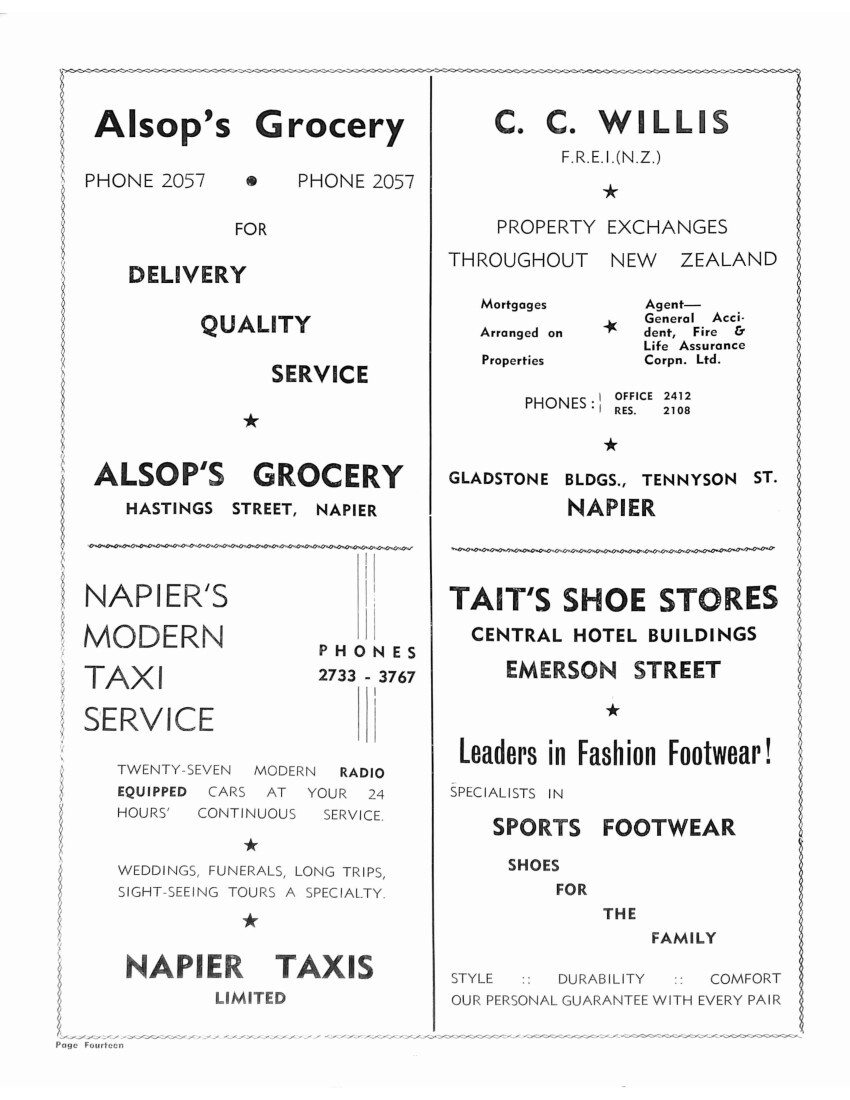
Page Sixteen
[Advertisements]
SHEARER’S LTD.
EST. 1922
HIGH-CLASS GROCERS
AND PROVISION
MERCHANTS
HOUSEHOLD
HARDWARE
CROCKERY AND
BRUSHWARE
FAMILIES WAITED ON FOR ORDERS WEEKLY
ALL GOODS CAREFULLY PACKED & DELIVERED FREE. PHONE ORDERS RECEIVE PROMPT ATTENTION
SHEARER’S LTD
“The Firm That Delivers The Goods”
Kennedy Rd., Napier
PHONE 3636 PHONE 3636
ZORN’S
GENERAL DRAPERS
KEEN
VALUES
in
Manchester Goods Dress Materials Ladies’ Lingerie
Hosiery Frocks Coats
General Drapery
A. B. DAVIS & SONS LTD.
BUILDERS & CONTRACTORS
P.O. BOX 251, NAPIER
PHONE 2049
DESIGNERS AND BUILDERS OF
PREMISES
AT MAREWA SHOPPING AREA
We cater for the following Sub-Trades:
JOINERY MANUFACTURE
PLUMBING
BRICKLAYING
DRAINLAYING
Hawke’s Bay’s Most Modern Pharmacy
(1 minute from Motor Camp)
OFFERS
A COMPLETE PHARMACEUTICAL SERVICE
Prescriptions – Medical and Surgical Sundries
Cosmetics
MAREWA DISPENSARIES Ltd
(L. J. DONNELLY, M.P.S.)
Kennedy Rd. Phone 5301 Napier
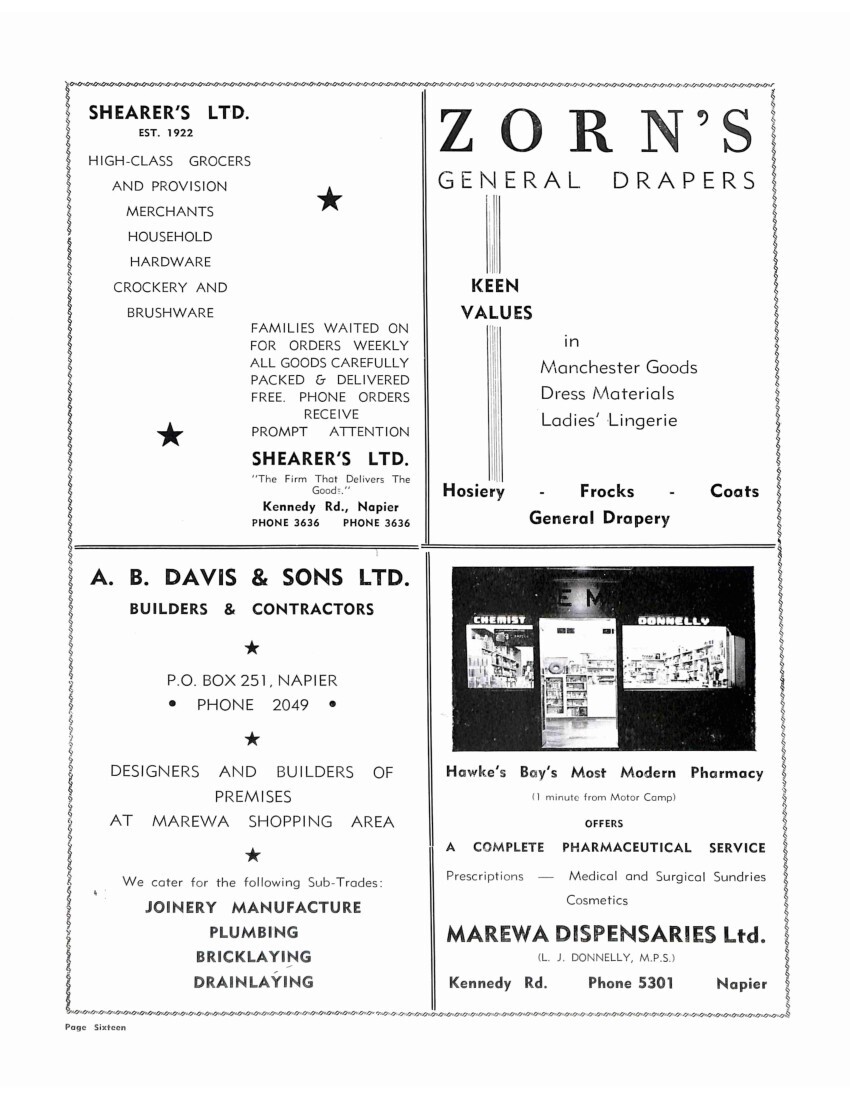
Page Seventeen
town was anything but attractive. There was nothing to boast about. Beauty spots were few and the citizens lived their humdrum existence in rather dismal surroundings.
Local authorities were wrangling about whether efforts shouldn’t be made to reclaim more land from the inner harbour. There were those who advocated that the inner harbour should be developed as a harbour instead of being reclaimed for building. Cost of either project would have been prohibitive and the authorities were stumped.
Shortly after [before] 11 o’clock on the morning of Tuesday, February 3, 1931, Nature took the whole matter in hand and settled the argument.
To present a full picture of Napier, further mention must be made here of the earthquake. For three minutes Napier rocked and rumbled violently in the grip of an earthquake which seismographs all over the world recorded as “intensity 10”, which is quite an earthquake in anybody’s language. In that short three minutes the whole of the town area crumbled and crashed to be followed by an all-engulfing fire, which swept through the town unchecked. The devastation was complete, utter and final. At least, so it seemed at the time. It was not until the smoke and fire had cleared away and the earth had eased in its restless heaving that citizens were able to take stock of what was left of the town. Whole blocks of buildings had simply disappeared into heaps of burnt-out rubble. Men in authority were agreed: “We’ll just simply have to start all over again”. It was fortunate for Napier that those placed in authority were men of great vision. They could see that here was the opportunity to not only start again, but to rectify the mistakes of the past – to build a model city, a greater Napier, bigger, brighter and better than ever before.
Then was discovered the real miracle. It seemed that Nature, which appeared bent on utterly destroying Napier and everyone in it, was merely carrying out major public works which the local authorities had been discussing for years. The earthquake had lifted Napier and its surrounds some seven feet higher, with
Photo caption – A LOVELY APPROACH, KENNEDY ROAD, TO A MODERN SHOPPING CENTRE – MAREWA BLOCK.
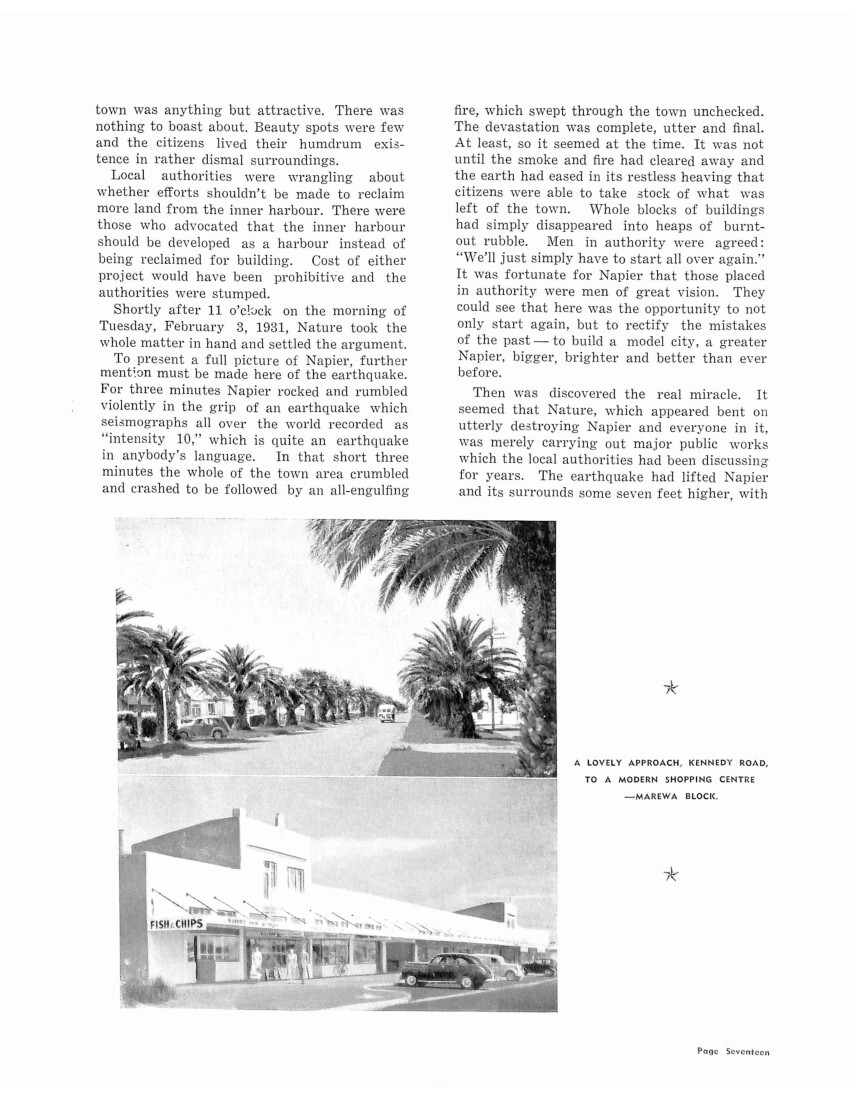
Page Eighteen
[Advertisements]
THE PRIVATE Regent Hotel
(Proprietors: Mr and Mrs A.E. DUNSTALL)
CUISINE COMFORT CIVILITY – THAT YOU WILL REMEMBER WITH PLEASURE!
H. & C. Water in all rooms Private Car Park
PHONE 4054
170 HASTINGS ST. NAPIER
FOR LOVELY &
FASCINATING
DRESS FABRICS
CALL AT
C. Sanderson’s Ltd.
FABRIC SPECIALISTS
EMERSON ST. NAPIER
For All
RADIO ELECTRICAL
AUTOMOTIVE
REPAIRS
BROWN & FAIRBROTHER Ltd.
EMERSON STREET NAPIER
SPECIALISTS IN
Motor and Armature Rewinding
When Visiting Napier …
We invite you to inspect our Range of High-Class Mercery and Clothing
T. PARKER & CO. LTD.
TAILORS AND OUTFITTERS
Hastings St. Phone 4055
Napier P.O. Box 91

Page Twenty
[Advertisements]
HAWKE’S BAY
STEAM LAUNDRY LTD.
PHONE 2430
LAUNDRY AND DRY CLEANING SPECIALISTS
ESTABLISHED
1905
Thackeray Street
NAPIER
BE SURE TO SEE …
BUCHANAN’S
WINDOW DISPLAY
OF
WINES & SPIRITS
N.Z. AGENTS FOR: –
VAN DULKEN WEILAND DISTILLERY, HOLLAND
SEMPE DISTILLERY, FRANCE
LINDSAY’S DISTILLERY, SCOTLAND
L.H. BUCHANAN & SONS LTD.
DICKENS STREET, NAPIER
(Opp. Gaiety Theatre)
Security Service
INSURANCE AGENTS
GRAIN MERCHANTS
LAND SALESMEN
STOCK SALESMEN
WOOL PRODUCE BROKERS
SHIPPING PASSAGES AND TOURS
QUIBELL’S DIPS
MERCHANDISE SUPPLIES
OPALINE OILS
DALGETY’S
The Largest Wool Selling House in the World
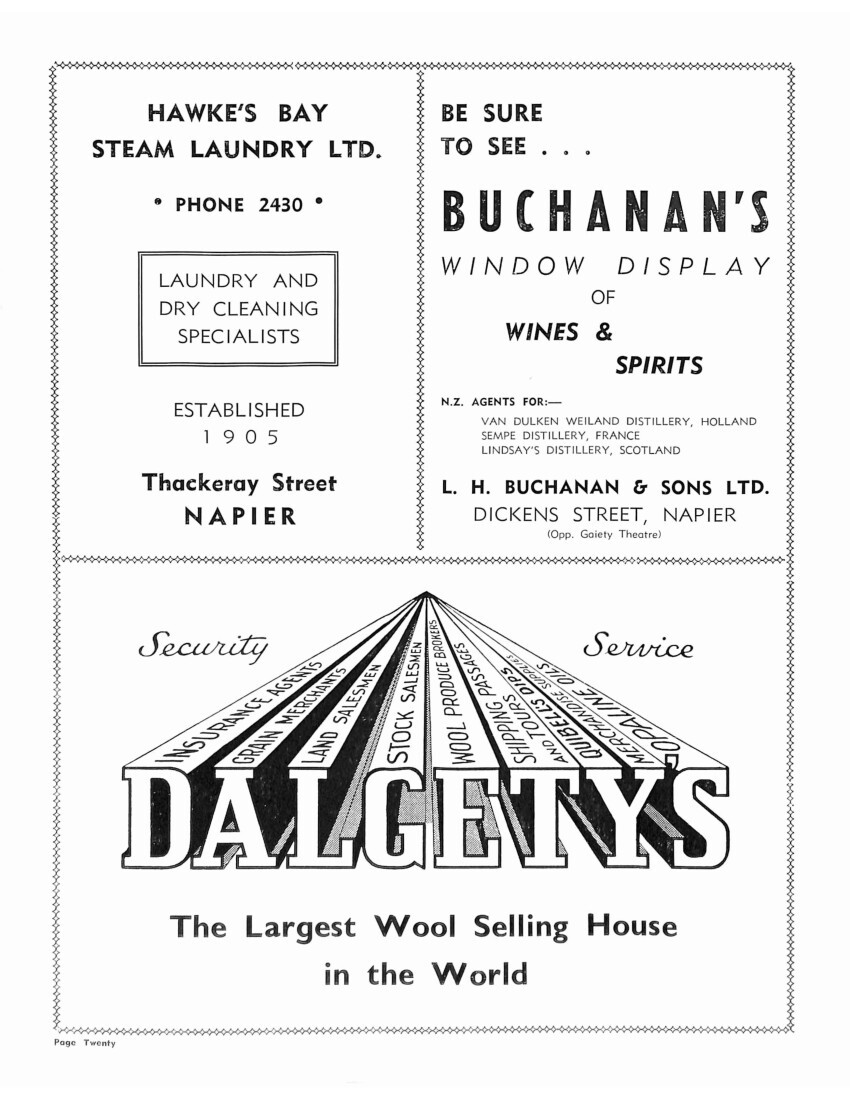
Page Twenty-one
the result that the water was drained from the swampy lands (still not reclaimed) and, even more striking than that, the whole of the inner harbour. This was the real miracle of the earthquake and Napier’s authorities were quick to grasp the significance. Here was the required for expansion. Certainly it would want major development. The new land – once the bed of the sea – had to be properly drained before it could be made fit for habitation. Napier, like the rest of the Dominion – in fact the whole world – was at that time in the grip of the depression. Labour was cheap. Hundreds of men were looking for work. Well, here was plenty of work and men were quickly employed digging drains and carrying out other development. The new land was, of course, the property of the Napier Harbour Board. Its finances being very low as the result of great expenditure on endeavours to make a harbour out of the old Ahuriri lagoon, which was constantly silting up from the Tutaekuri River which then flowed into it, the task of developing the new land was well beyond the means of the Board. So the land was leased to the Crown which was the only body capable of carrying out the work at that time. So the draining and development of the inner harbour, or Ahuriri Lagoon, was commenced.
As for Napier itself – still licking its wounds from the earthquake, the town was in a sorry plight. The remainder of the Dominion was
Photo captions –
DICKENS STREET, NAPIER.
MESSRS. DALGETY’S BUILDING, IN WHICH THE NAPIER RADIO STATION 2YZ, IS SITUATED.
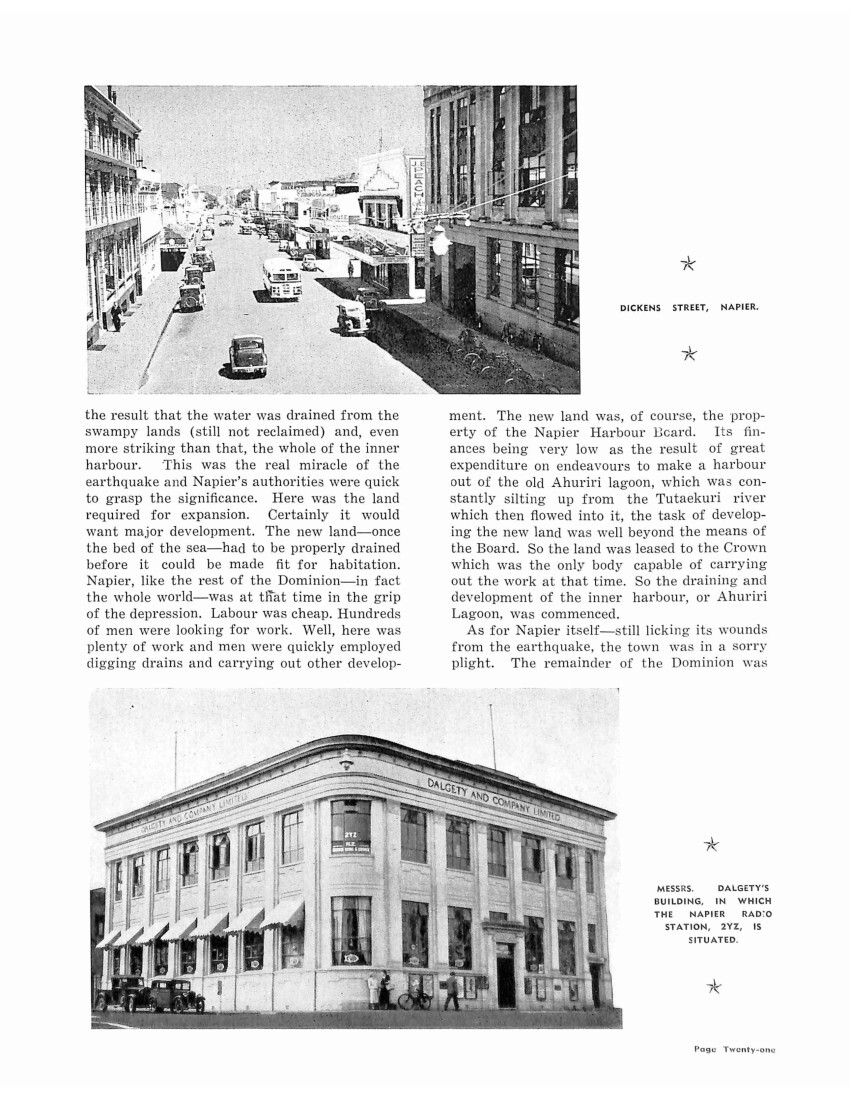
Page Twenty-two
[Advertisement]
P.O. BOX 55, NAPIER
PHONES: 2055, 4686
FOR
HOMES
BUSINESSES
FARMLETS
FARMS & HOTELS
(Hotel Valuations undertaken)
ALWAYS CONSULT VIVIAN COX
F.R.I.E.N.Z. & F.N.Z.I.V.
TENNYSON STREET, NAPIER
Valuer and Consultant to Napier City Council, Napier Harbour Board & Local Bodies.
Managing Director: NAPIER PROVEDORS LTD, Ships’ Providers and Chandlers.
Visitors who wish to visit the Gannet Sanctuary should enquire at Clifton regarding the state of the tide since the last six miles to the Cape along the beach can only be safely made if the tide allows.
Photo caption – THE GANNET SANCTUARY AT CAPE KIDNAPPERS.
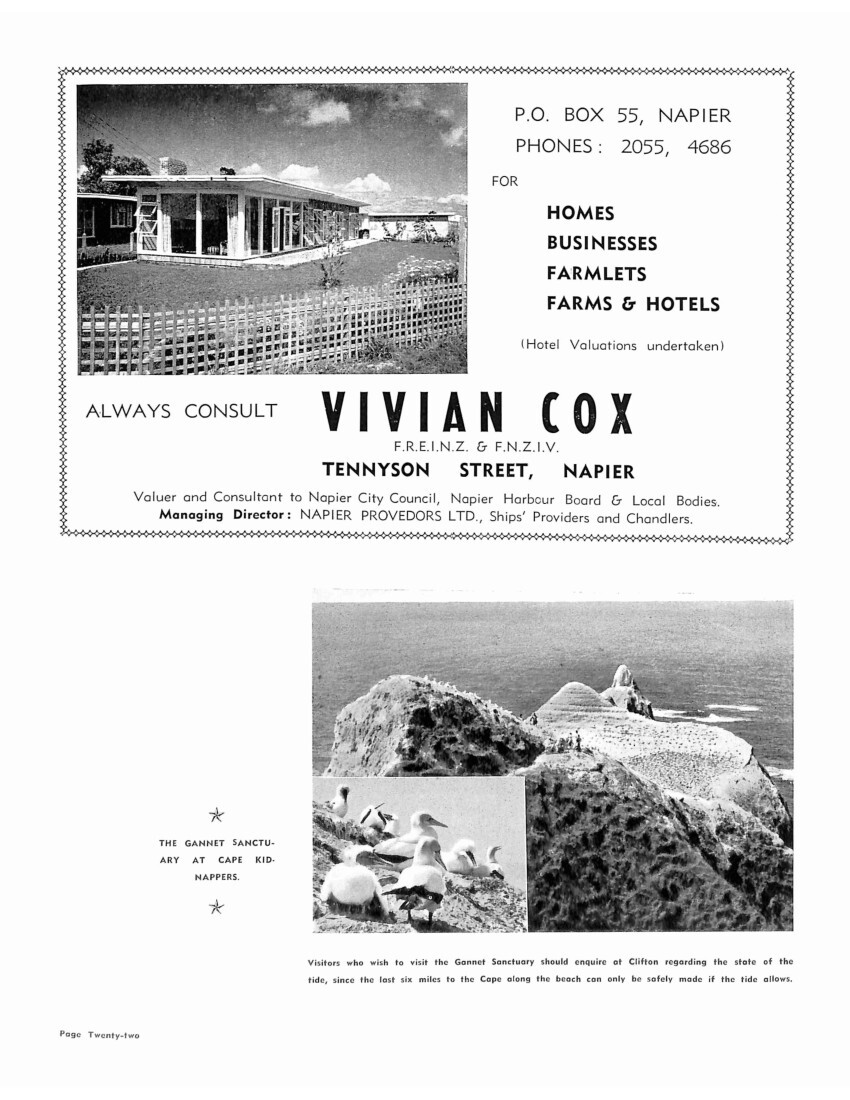
Page Twenty-three
quick to help and all the townsfolk who were not required for urgent works were evacuated. Then, with the worry of the people off their minds, the authorities got to work. Temporary shopping facilities were erected in Clive Square, and temporary canvas homes and other facilities were constructed on the open parks and gardens. Meanwhile demolition gangs were busy in the streets removing debris and pulling down crazy buildings, which tottered but remained standing with every little ‘quake. One of the major problems was what to do with all the debris.
It was at this point that Napier’s beautiful Marine Parade gardens and entertainment facilities were born. Much of the debris was dumped on to the shingle foreshore fronting the town area and this later was to be the foundation for the lawns and gardens which are now such a common delight. This was evidence of some of the foresight which permeated through the whole reconstruction programme for the town. Further evidence can be seen in many of the other improvements instituted at that time.
With the debris cleared away, here was the opportunity to start all over again. The authorities were determined that everything would be planned and done to see to it that Napier would be a better place in which to live. The Government, in its wisdom, could see that any local body would be hampered by endless wrangling in deliberating the reconstruction programme. To overcome this problem, the Government appointed two Commissioners, Messrs Barton and Campbell, to take over the full control of the reconstruction, assisted, of course, by local authority. These men, perhaps not expert town planners by progression, tackled the task of rebuilding Napier with a keen sense of improvement. For a start, they decided that the previously narrow streets would have to be widened. There was opposition from some of the shop property owners, but they were simply brushed aside with the remark that they would be compensated. They were – and Napier’s main thoroughfares are now almost half as wide again as they were before the earthquake. New buildings had to be constructed on a rigid standard of safety. Inspectors were everywhere
[Advertisement]
DIRECT IMPORTERS
AND
WHOLESALE STOCKISTS
OF
EARTHENWARE CHINA
GLASSWARE CRYSTAL
PRESSURE COOKERS CUTLERY
J.H. Mendelssohn Limited
TELEPHONE 5378
P.O. BOX 285 NAPIER WAREHOUSE AT AHURIRI

Page Twenty-four
[Advertisements]
OCEAN VIEW PRIVATE HOTEL
MARINE PARADE, NAPIER
EXCELLENT CUISINE
Glorious Views of Pacific Ocean
“A Home Away From Home”
Tariff: 21/- Daily Full Board
Phone 3071 Mr & Mrs E.B. Jenkins (Props.)
MEMBER OF
NEW ZEALAND MOTOR BODY BUILDERS’ INDUSTRIAL UNION OF EMPLOYERS
Local agents for:
Cavanagh & N.Z.M.B.
Hydraulic Hoists.
A. DYKES & SONS
MOTOR BODY BUILDERS
PANEL BEATERS & WELDERS
Phone 3219 HASTINGS ST., NAPIER
WE CORDIALLY INVITE YOU TO VISIT OUR NURSERIES
We Specialise In:
Decorative Pot Plants, Palms, Etc.
Also Trees, Shrubs and Seedlings
Phone 2016
J.N. ANDERSON & SON LTD.
NURSERYMEN, NAPIER
PACIFIC FRUIT CO.
EMERSON STREET
NAPIER
WHOLESALERS & RETAIL
FRUITERERS & GREENGROCERS
HOTELS, RESTAURANTS & PRIVATE HOUSES SUPPLIED
FREE DELIVERY
PHONE 2035
WE SELL BIRDS EYE FROZEN FOODS
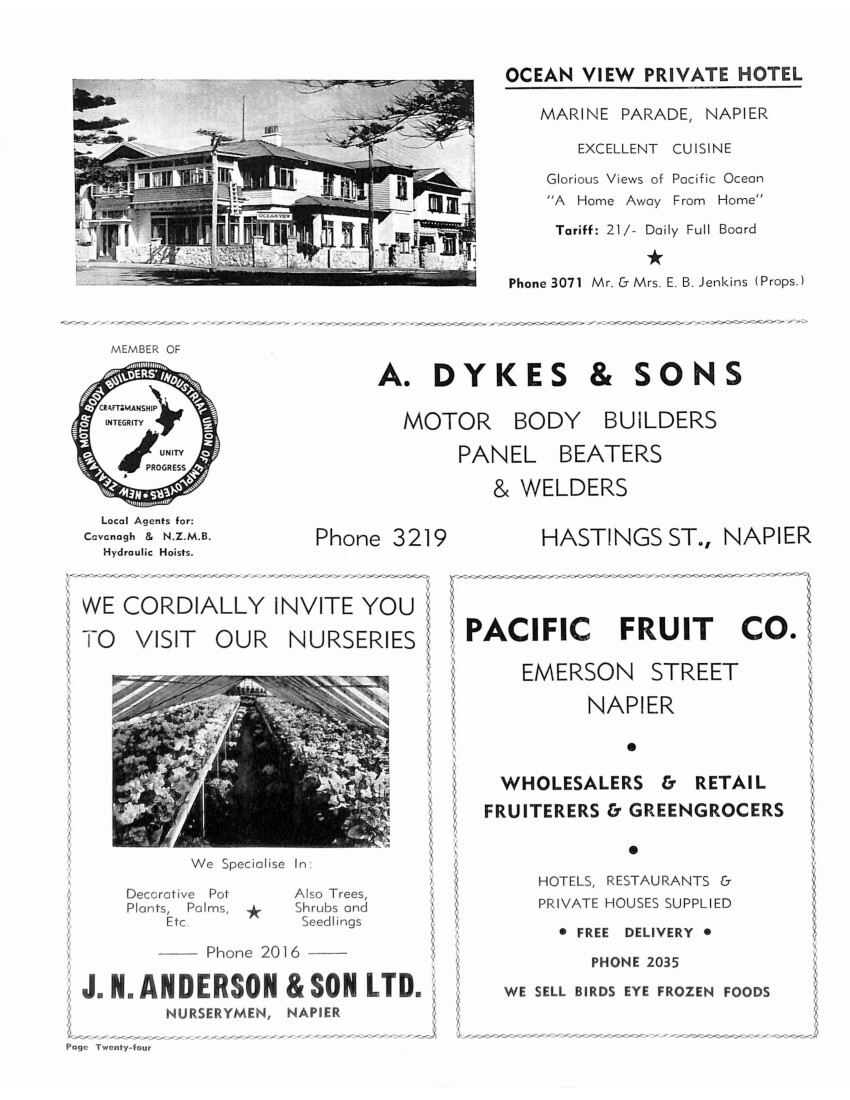
Page Twenty-five
Builders from all over the Dominion flocked to Napier and not many months had passed before the main streets presented a busy scene from one end to the other. Shops and office buildings appeared like mushrooms, and many of the contractors had several buildings under way at once.
To facilitate the loading and unloading of trade vehicles, service lanes were provided at the rear of the shops, the lanes running at the back of the lines of premises on both sides of Emerson Street. One by one the shops in “Tin Town” – the shopping premises erected in Clive and Memorial Squares – emptied and the shopkeepers moved into their new quarters in the old shopping area. Insurance companies, banks, and other commercial firms, who had been accommodated in sheds, houses and other temporary quarters, soon followed suit as Dickens and Tennyson Streets became habitable again with new buildings.
The new buildings in Napier had something in common. They were mostly of one-storey and two-storey design. In fact, to-day, one could probably count the three-storey buildings in the city on the fingers of one hand. Each building was of modern design, yet no two the same. Gradually the gaps were filled in, until to-day there are at least three full streets with no vacant lots. Attractive colour schemes were brought into effect in the construction of the new buildings, and although some of the colours have faded with the years, the whole set-up of Napier’s town area is the most attractive in the Dominion. As “Tin Town” became vacated, so it was removed, and as the buildings were taken down, the Napier Council’s Reserves staff moved in to bring Clive and Memorial Squares back to their former selves.
So the reconstruction of the town and the rehabilitation of its citizens went on. Each week saw further amenities restored. Water mains, torn and wrenched by the earthquake, were repaired or replaced, the drainage and sewerage systems underwent the same treatment, and it was not long before all the public utilities were functioning normally. Here, too, opportunity was taken to bring these systems up-to-date as far as was possible so that in this factor alone Napier had advanced.
Slowly, but surely, the swamp waters receded from the former marshes to the southern-west of the town area and the Napier South residential area, and, with the provision of a new mouth for the Tutaekuri River, which formerly flowed along the outskirts of the latter, vast new areas of land became available for building sites. Much preliminary work was carried out by the Napier Borough Council and the Government, and finally these areas of land were opened up for building. The southernmost portion of this land was first developed and settled as a small farm district to be known as Richmond Block. Then, nearer to the town, the Government Housing Department took over a large area and the erection of State houses commenced. To-day this area of State houses is probably one of the most attractive in New Zealand. Side by side with Government Housing block, sections were sold in the new suburb of Marewa for the private erection of homes. The growth here was mushroom-like and not many years had passed before here again building sites were sat a premium and newcomers to Napier could find no place on which to build a home. In the naming of the streets in the new suburbs, men who had rendered outstanding service to their town were remembered.
Photo caption – NAPIER’S ART GALLERY AND MUSEUM HAS A HOST OF INTERESTING FEATURES. VISITORS ARE VERY WELCOME.
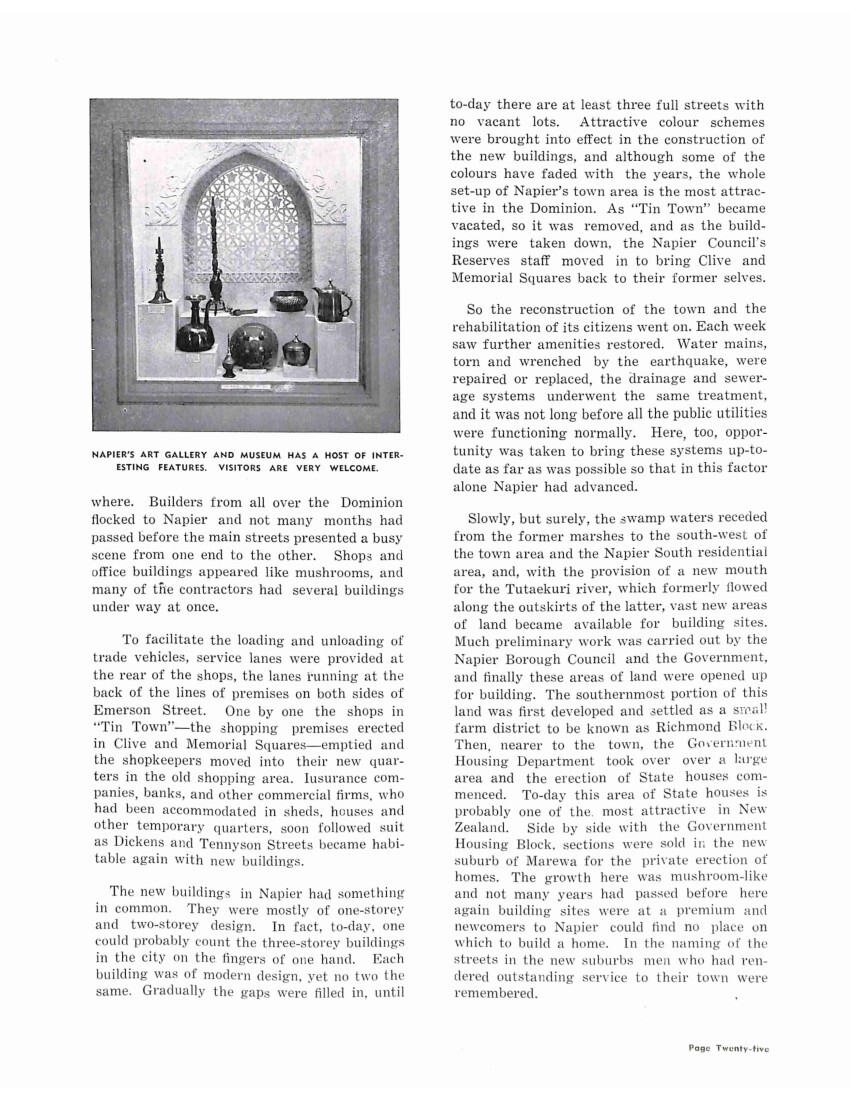
Page Twenty-six
[Advertisement]
GET A NEW ANGLE ON EATING!
VISIT NAPIER’S MOST UP-TO-DATE SELF-SERVICE CAFETERIA
OUR MOTTO –
FAST CLEAN COURTEOUS SERVICE
WEDDING BREAKFASTS
PARTIES, REUNION DINNERS
STAFF FUNCTIONS
A SPECIALITY
SUPERVISION IS IN THE CAPABLE HANDS OF MR. & MRS. ALEX. MACKAY
TELEPHONE
4200
NEW NAPIER CAFETERIA
LTD.
in HASTINGS ST
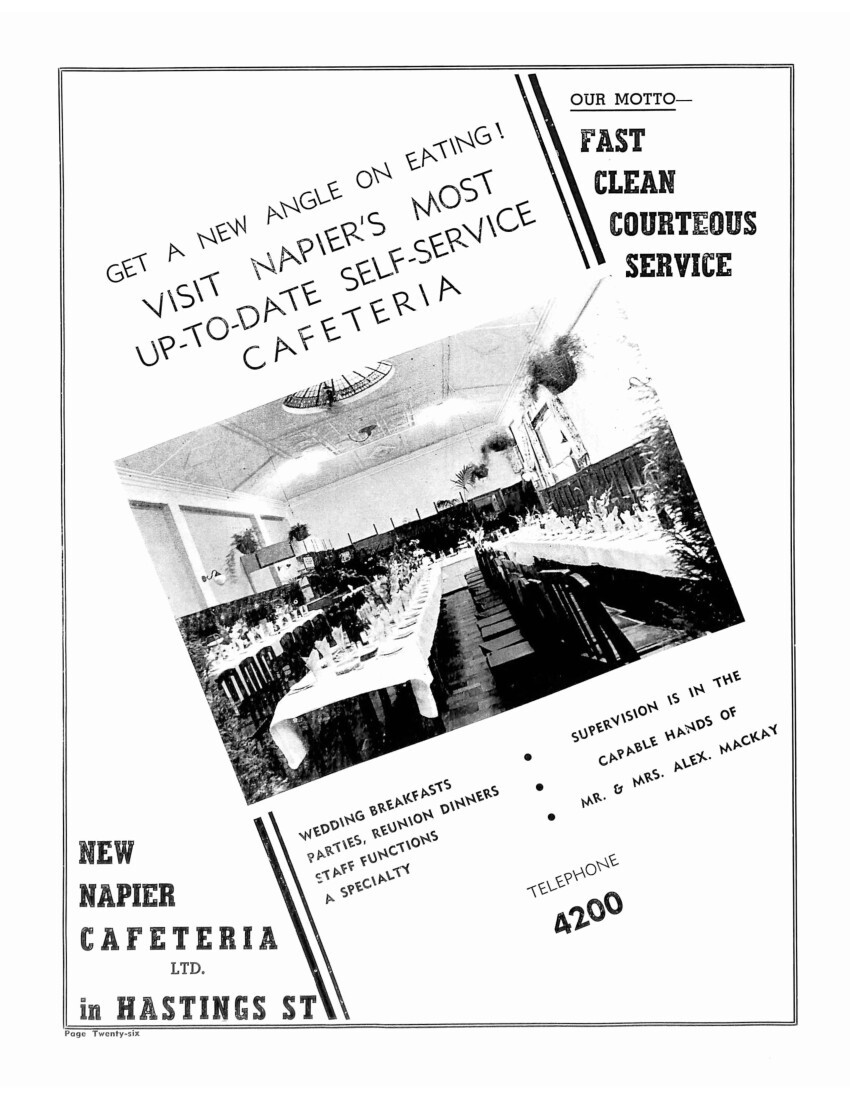
Page Twenty-seven
A HARBOUR GAINED
When the great earthquake transformed the old inner harbour from a lagoon into dry land, it wrote “Finis” to the wrangling which had gone on for years between two rival sections of the Harbour Board – one advocating for an inner harbour; the other for a breakwater harbour. As the result of this wrangling, Napier had no satisfactory harbour. Overseas ships were obliged to lie in the roadstead – some two miles out to sea – and be loaded and discharged by lighter from Port Ahuriri. Access and egress to the meagre wharves at Port Ahuriri was through a narrow channel, and with seven feet less depth after the ‘quake, this was written off except for use by the fishing fleet.
There was, of course, a breakwater harbour. With the “inner harbour” faction of the Harbour Board in power prior to the earthquake, the breakwater harbour had suffered in consequence, and little or nothing had been done to improve the facilities there. The concrete block mole was in existence, and the old Glasgow wharf – still standing – was the only berthage provided for shipping. The harbour badly required dredging and only ships of limited draught could tie up alongside.
With the inner harbour out of the question altogether, and a virile Harbour Board in power, it was realised that if Napier was to be a port of any consequence, then the breakwater harbour would have to be developed. It was a gigantic task; but it was a task which was handled magnificently, efficiently and with courage. The mole had to be extended, the Glasgow wharf was useless (it was now seven feet higher than before), new wharves had to be erected and a major dredging operation carried out.
Dredging was the main headache. The foot of the Bluff Hill extended out into the sea and a dredge had to be obtained which could cope with the rock which formed the undersea strata. Finally the board obtained the dredge Whakarere, which was found suitable and the dredging commenced. The obstacles which were met and surmounted were fantastic but triumphantly the work progressed and the construction of the first (No.3) wharf was commenced. Finally the boxing was stripped and there stood a modern concrete wharf capable of accommodating all but the largest overseas vessels. It was a great day for Napier when the first overseas ship, the tanker W.B. Walker, tied up snugly alongside the new structure.
Photo caption – HASTINGS STREET, NAPIER.
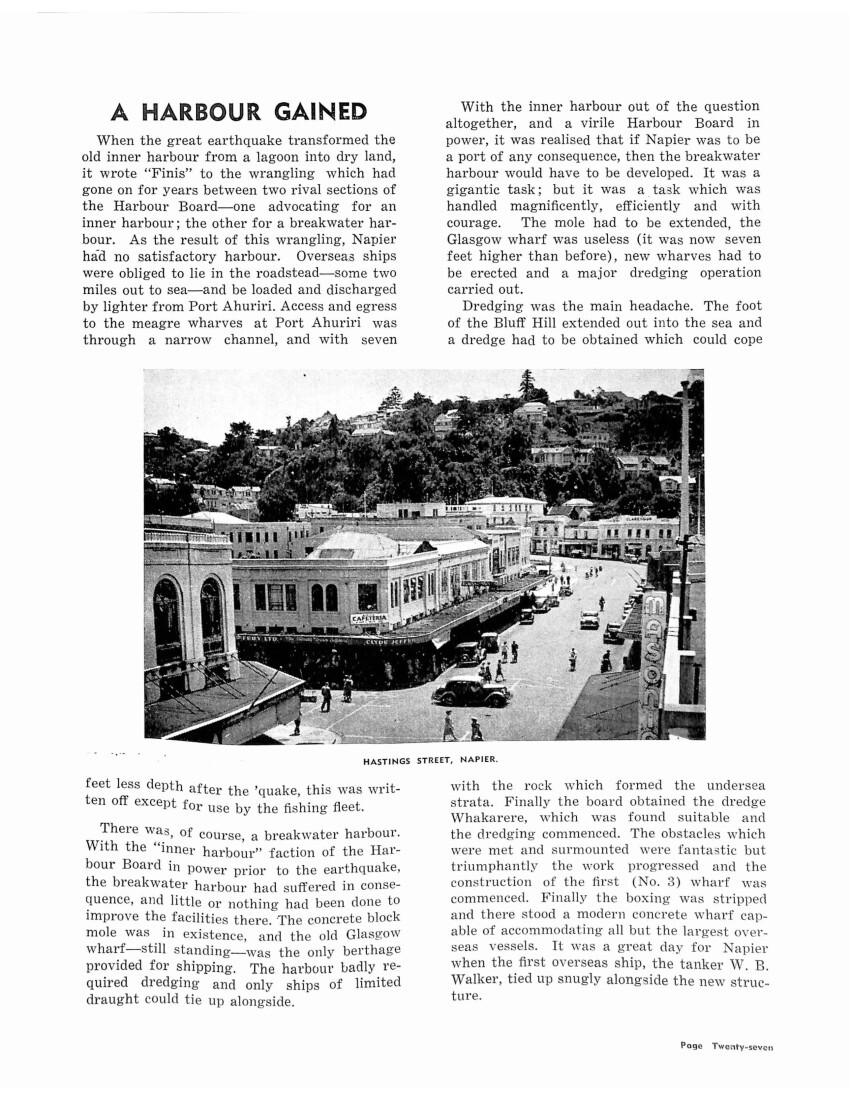
Page Twenty-eight
[Advertisements]
MARINE PARADE
SERVICE STATION
“The Little Station with the BIG Service”
PHONE 4713
SPECIALISING IN
PETROL OIL TYRES SUNDRIES GREASING
ALWAYS A GOOD SELECTION OF USED VEHICLES
MARINE PARADE NAPIER
Vulcan Foundry
NAPIER PHONE 2826
Manufacturing & Constructional
Engineers
Iron Brass and Aluminium
Founders
Electric and Oxy-Acetone
Welders
Stockists of all
Engineering Supplies
JOBBING & REPAIR WORK DONE AT SHORT NOTICE
Murton’s Limited
ESTABLISHED 1886
CORONATION ST.
PORT AHURIRI
Manufacturers of:
Sheep Dips, Disinfectants, Weedkillers
Footrot Fluid, Animal Medicines and Slugene
WHY PAY MORE?
SUPPORT LOCAL INDUSTRY
PAY LESS AND GET BETTER QUALITY
W. J. WALLACE
BUILDER & CONTRACTOR
Sound Construction, Moderate Charges, Best Workmanship
TELEPHONE 48-398
60 The Esplanade, Westshore, Napier
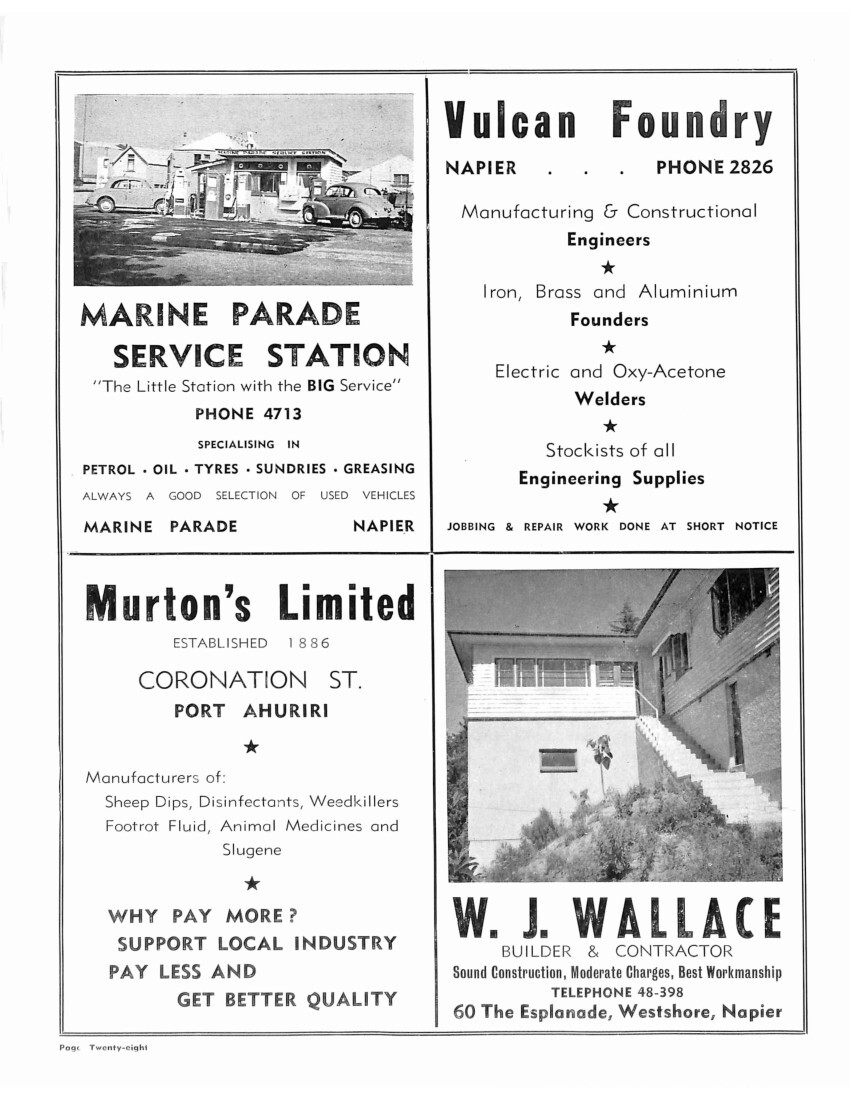
Page Twenty-nine
Spurred on by its success, the Napier Harbour Board, then constructed the second overseas wharf (No. 4) and with it a modern cargo shed on the shore. With the completion of these facilities the success of the Napier harbour venture was assured. Now it is a common sight to see at least three large overseas ships loading their cargoes of Hawke’s Bay produce from the wharves at Napier. Berthage is also available for coastal vessels which ply between coastal ports and Napier with transhipment cargoes. Now a further dredging programme has brought four overseas berths into operation and the Harbour Board is proceeding with the demolition of the old Glasgow wharf to be replaced with a modern wharf complete with the necessary sheds.
The success of the Napier Harbour is borne out by the fact that Napier is the third overseas export port of the Dominion. Vessels unable to be accommodated at the other main ports are often sent to Napier for discharge and loading. The port is growing rapidly and, when the programme of the Harbour Board is complete, all the facilities necessary for the loading and discharge of all vessels calling to the Dominion will be provided. This is the harbour the earthquake conceived.
“A THING OF BEAUTY”
What had become of the earthquake debris deposited along the foreshore on the Marine Parade? The Napier Thirty Thousand Club, which as its name indicates, had the objective of a 30,000 population for Napier, was a body of enthusiastic business men with the welfare of their town at heart. The Club had funds – it also had a plan. Once again the foresight which was so in evidence following the earthquake, came to bear and the Thirty Thousand Club could see the potentialities of the Marine Parade. Already famous throughout the Dominion for its wide panorama of the Pacific, and lined with the attractive Norfolk Island pines, the parade could be made more beautiful and more attractive. The Thirty Thousand Club could see just how, and set about the job of transfiguration. Backed by the Napier Borough Council – which also could see the vision – the club commenced the preparation of the gardens and lawns which to-day are the admiration of all visitors and the pride of all Napier citizens. Spoil for the foundations was available aplenty – from the huge slips which had roared down from the Bluff Hill. Black soil was brought in and the gardens and lawns planted. Under the guidance of the Superintendent of Reserves, only the plants which were likely to survive the salt spray were used and the value of this guidance is borne out by the thriving gardens of to-day.
One of the members of the Thirty Thousand Club had seen a sound shell overseas and decided that such an edifice would be ideal for the Marine Parade. The Shell was erected. The idea of the colonnade, the coloured concrete patio, the arches, the glassed-in shelter bay – all these were part of the plan, and gradually the plans became concrete.
New Zealand could now see that Napier “had something”. But still the vision was not complete. Another prominent Napier citizen, Mr Tom Parker, had been for a trip overseas. He
Photo caption – ONE OF THE SEVERAL WELL LAID OUT STATE HOUSING BLOCKS.
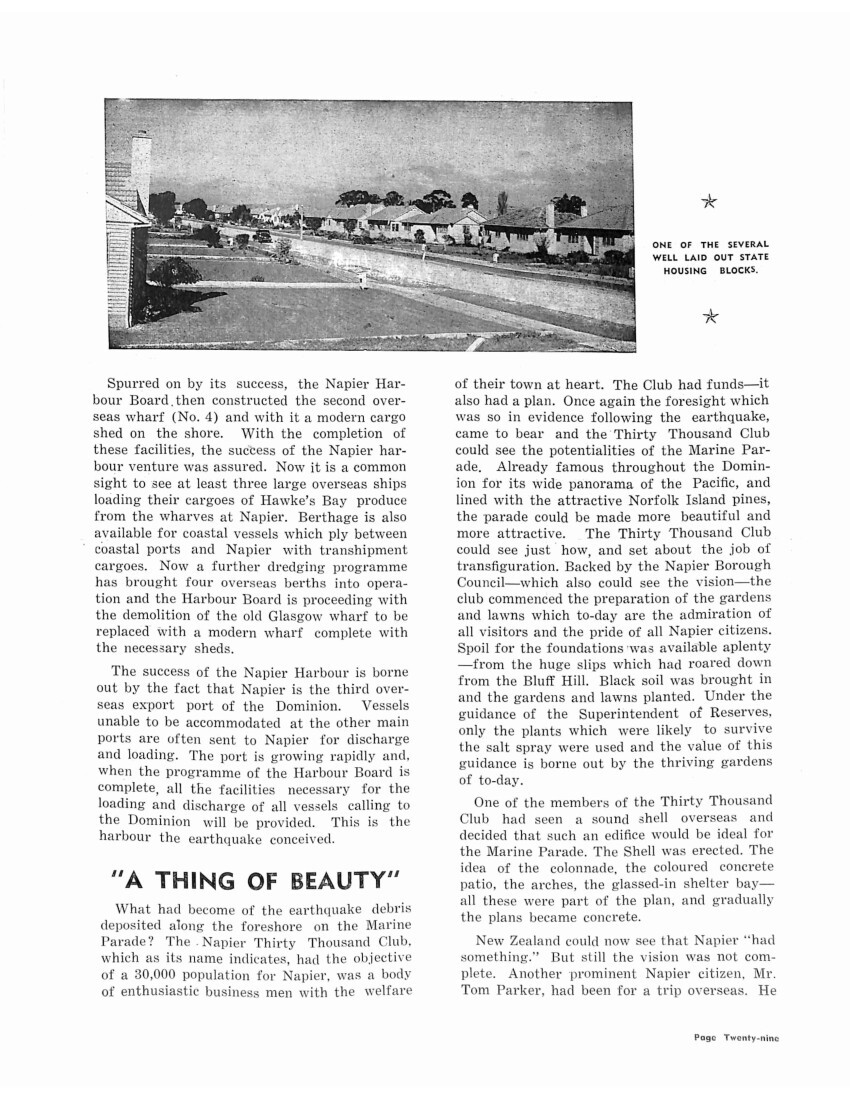
Page Thirty
had seen an electric fountain. Napier should have one – he ordered it – it would arrive shortly. So the Tom Parker Fountain came into being.
“Why not a gazing bowl?” asked Mr and Mrs W. T. Harvey when they came back from a trip. They had one installed in front of the shelter bay. So it went on – from beauty to beauty. The Borough Council conceived the idea of illuminating the Norfolk Island pines with coloured lights. It was tried – it turned the Marine Parade intro a veritable fairyland at night. Apart from the Sound Shell entertainment, there was still nothing to occupy visitors to Napier during the holiday period. There followed a putting green, tennis courts and an area set aside for the side-show men.
When one day some children were seen roller skating on the coloured concrete patio enclosed in the colonnade an idea was born. It was an idea which reached fruition in the formation of the Napier Skating Club. No record of Napier would be complete without reference to this great organization which has provided delightful entertainment for citizens and visitors alike right throughout the summer months since its inception. The outdoor skating carnivals on the Marine Parade, Napier, are something which are talked about throughout New Zealand. They are colourful and highly entertaining. The actual skating floor has never been entirely satisfactory – it was never intended for a skating rink. Every effort has been made to bring it to an ideal surface, but every effort has failed. Now the Skating Club has plans of its own – a new rink with full seating accommodation at a point further along the parade. There are also plans for a winter garden and civic centre a little further South along the foreshore – and so the beautification of the Marine Parade continues. Already one of the show places of New Zealand, Napier’s Marine Parade may well become one of the show places of the world. The room for extension is unlimited and it is the will of the people themselves that this should be brought about. The will of this people is known – it has been tried – why should it fail now?
Napier’s other main waterfront, the Westshore beach, some three or four miles north of
[Advertisement]
MASONIC
Hotel
NAPIER’S LUXURY HOTEL CENTRALLY SITUATED IN THE HEART OF THE CITY
ON THE ESPLANADE
FIVE STAR COMFORT – EXCELLENT CUISINE AND SERVICE. STAY WITH US IF YOU WISH TO ENJOY THE BEST OF NAPIER HOSPITALITY.
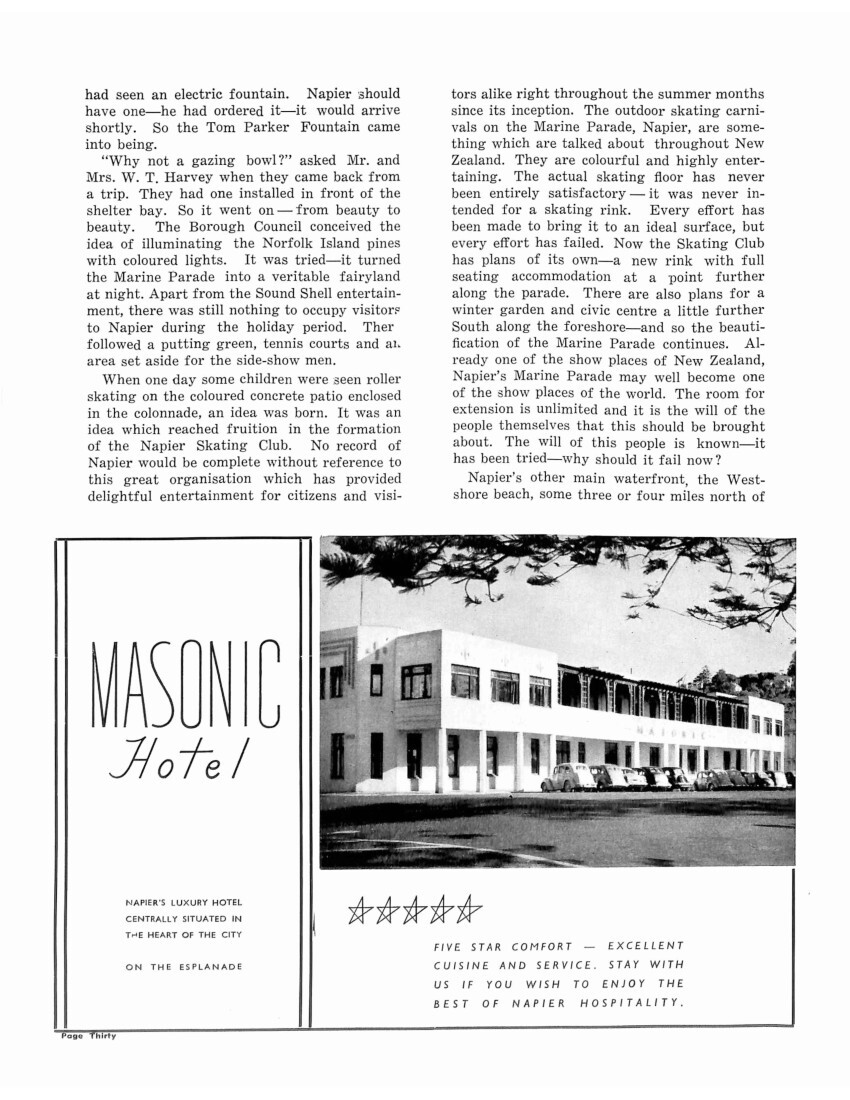
Page Thirty-one
CAR-SERVICE UP-TO-DATE
Modern, Efficient Layout of Tourist Motors
Important developments have taken place in the design and layout of buildings planned for the servicing of motor-vehicles. This calls for liberal well-lighted space, with the many available facilities disposed conveniently and correctly related one to another.
It is obvious that these points were uppermost in the planning of Tourist Motors’ new layout in Napier. The first impression is one of broad and attractive spaciousness, and this is borne out by closer study. Clever planning gives ample space for petrol-filling, while casual callers for air, oil, etc., can be accommodated in the roomy front court without impeding the wide entry to the garage proper.
The building is set well back from the street-level on a generously wide frontage so that the car-owner seeking prompt service is attracted by the ease of entrance and exit, and the freedom from congestion. All-glass double doors at the rear cover a wide exit giving on to a spacious area devoted to car-parking and car-washing. This area adjoins a rear thoroughfare serving further to eliminate congestion and bottle-necking at the front of the premises.
The overall design with its low sweeping lines is pleasing in the extreme.
UP-TO-DATE PLANT
As one would expect in this modern layout, plant and fittings are of the very latest. Every facility is available for quick and efficient work, the general atmosphere of gleaming cleanliness being reminiscent of a modern operating theatre.
FOR MOTORISTS’ COMFORT
The building shows a progressive trend, too, in its provision of comfort and convenience for motorists and their wives. The first floor provides a specious lounge with facilities for writing, reading and telephone together with Ladies’ and Men’s Rooms. This welcome attention to the needs of the country motorists visiting the city is a progressive move which will be much-appreciated. Tourist Motors are indeed to be congratulated upon their enterprise and foresight.
NAPIER’S NEWEST SERVICE STATION AND GARAGE – A FINE EXAMPLE OF MODERN PLANNING.
the town, had also undergone a remarkable change as the result of the ‘quake. What had previously been an ugly beach of shingle was found now to be a lovely beach of golden sand. The lift of seven feet had exposed a wide strip of sandy beach which previously had been for ever below the low water mark. With the beaches of the inner harbour (on the western side of the Westshore spit) gone, residents of Napier were quick to see the advantages of Westshore as a bathing beach. Like magic beach cottages and baches began to spring up on the seaward side of the spit, which hitherto had been regarded as dangerous and uninviting. The surf itself took on a different aspect. In place of the deep dip a few feet off shore, there had been substituted a long sloping beach of sand, safe for bathing and ideal for surfing, for whereas before the ‘quake the waves reached the shoreline before pounding on to the shingle beach, they now broke well out to sea on the shallow beach and rolled in to make Westshore a surfers’ paradise. It is doubtful if a surf board had previously been seen in Napier, let alone used, and so popular did the sport become that it was even sampled by the Duke of Gloucester during his short stay in Napier, the Duke pronouncing the surfing as “excellent”. Westshore soon becomes the mecca of Hawke’s Bay sun-worshippers and bathers, and, particularly at week-ends and holidays, the beach took on the appearance of some of Sydney’s famous surf resorts. A cabaret was established right on the beach front and flourished for many years. It was unfortunately burned down shortly after the commencement of the war, and was never reconstructed. Property values at Westshore soared, and within a few years building sites along the foreshore were few and far between. Unable to extend southward, the building at Westshore proceeded
Continued on page 35
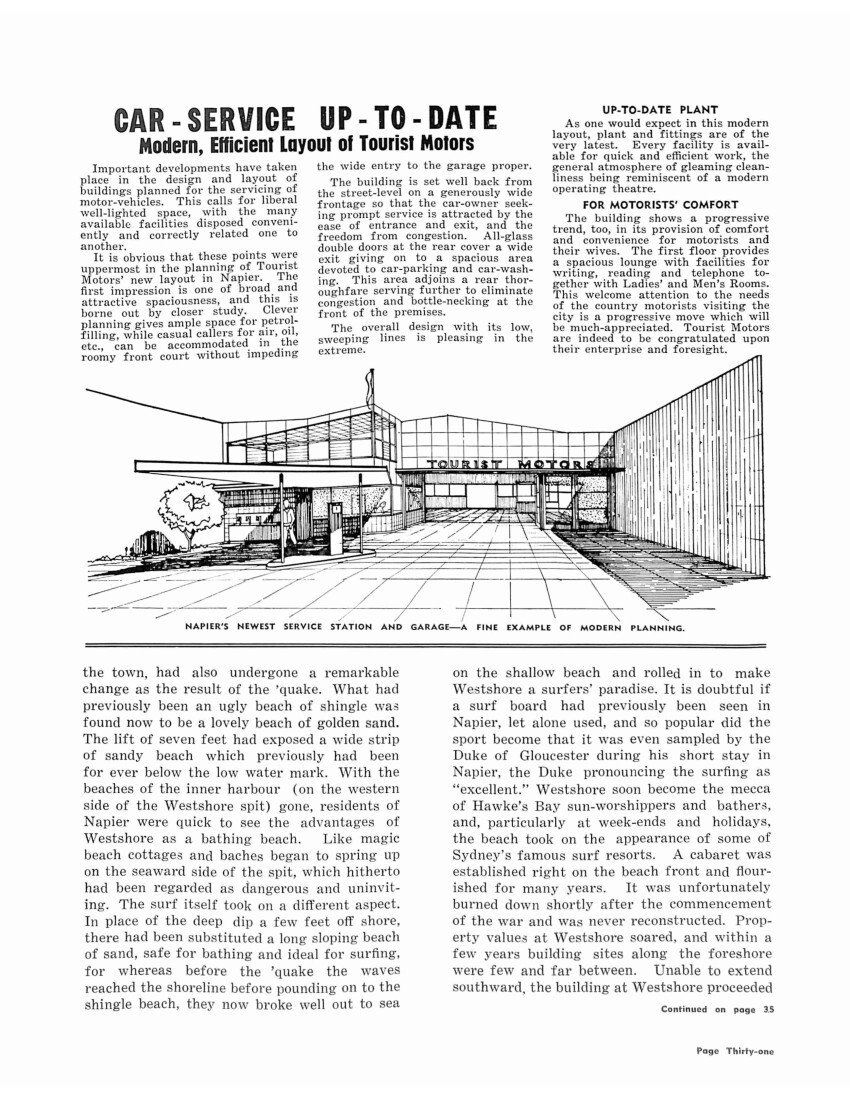
Page Thirty-two
[Advertisements]
HARVEY, FULTON & HILL
Real Estate Agents and Auctioneers
TENNYSON ST, NAPIER PHONE 4915
RUSSELL ST. HASTINGS PHONE 3713 & 3752
WE INVITE YOU TO INSPECT OUR SHOWROOM IN DICKENS STREET
I.E.L. Power CHAIN SAWS
Our Agencies include:
“Desoutter” Electric and Pneumatic Tools.
“Tanner” Machine Tools & Caravan Equipment.
“J.A.P.” Petrol Engines
“Elsan” Chemical Closets
“Logan” Word-Working [Wood-Working] Machinery.
PHONE, WRITE or CALL for leaflets and prices on any of the lines you are interested in.
E. L. DOBSON LTD.
Phones 4759 Private 4346 51 DICKENS ST. NAPIER P.O. Box 203
PHONE
4000
FOR A MODERN RENTAL CAR
24 CARS AT YOUR SERVICE
24 HOURS A DAY
OLIVER MOTORS LTD
DICKENS STREET (OPP. GAIETY THEATRE) NAPIER

Page Thirty-four
[Advertisements]
PORT GARAGE LTD.
(E.F. NATTRASS)
WAGHORNE ST. PORT AHURIRI
AUTOMOTIVE ENGINEERS
Specialised Lubrication
PETROL – OIL – TYRES
Comprehensive Stocks of Accessories
Breakdown Specialists
Authorised “A.A.” Breakdown Service
Hawkes Bay & East Coast Distributors
Pelta Hillside
BLOWER TOPDRESSER
Specially designed for topdressing hill country.
PHONE 2552
FOR
EXACT TIME
Have your watch repaired by us.
G.A.A. HOLMES
M.N.Z.H.I.
WATCHMAKER
LOCKYERS BLDG., EMERSON ST., NAPIER
STIMPSON & MADSEN
YOUR DECORATORS
Town and Country work undertaken
SKILLED WORKMANSHIP YOUR GUARANTEE
2 PRIESTLEY RD. NAPIER
NORMAN McAUSLIN LTD
P.O. BOX 374, NAPIER
Structural Steel Fabrications
All Classes of Welding Undertaken
General Blacksmiths & Spring Specialists
Phones: 3693 Works 5269 Res.
Hastings St. Napier
ALLEN’S
FINE FABRICS
FOR
The Home Beautiful
Wonderful Selection of Cretonnes, Linens, Brocades & Tapestries.
See our Carpets – Wall-to-Wall and Squares, Latest Designs and Colours.
Measurements taken and Estimates gladly given.
ALLEN’S FURNISHING CO. LTD
HOME FURNISHING SPECIALISTS
Emerson St. Phone 4702 Napier
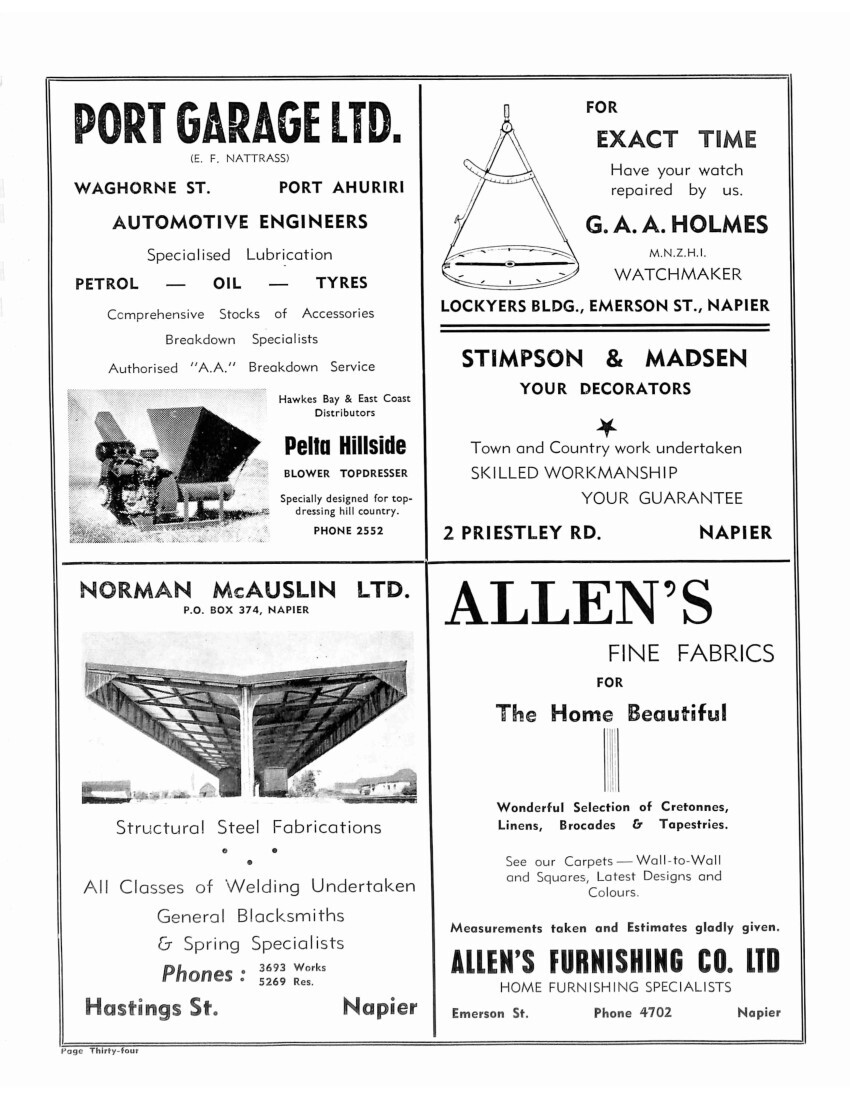
Page Thirty-five
in a northerly direction towards Bay View, and to-day the baches and houses extend from Port Ahuriri for two or three miles along the Westshore beach. Stores have sprung up along the beach and campers and visitors to the beach have every amenity desired. The shingle trap formed by the concrete mile at the breakwater harbour and its constant extension by the Harbour Board, is security that the Westshore beach will not again return to the beach of uninviting shingle that it was before the earthquake. An enthusiastic beach improvement society has been formed at Westshore and with a substantial tree-planting scheme and a programme for other improvements, Westshore beach may in the near future become one of New Zealand’s premier bathing resorts.
FROM SEABED TO FARM
We shall now see what happened to the great area of new land to north-west of Napier which previously bad been the inner harbour or Ahuriri Lagoon. As mentioned earlier, the new block, of about 8,000 acres, was leased by the Harbour Board – its owners – to the Crown for development. When the sea receded from this large area at the time of the ‘quake, it left in the middle a deep drain of several chains wide which previously had been the deepest part of the lagoon and over which the Westshore bridge spanned. It was into this wide channel that a complicated series of drains was cut to drain the whole of the 8,000-acre block. Many of the drains had to be pumped, but gradually the land dried out and native grasses and weeds commenced to grow. The large deposit of salt on the surface of this land presented a problem and any crops sown were stunted in their growth and entirely uneconomical. The task of bringing this land into production was no mean one, but at last it has been accomplished in some areas. Now, 21 years later, large paddocks are being sown down in permanent pasture and excellent crops of lucerne, barley and other grains are being taken off this former sea-bed. However, cropping is the least important of the farming activity now being carried out on the lagoon. Sheep and cattle are being grazed, approximately 20,000 of the former and 800 of the latter.
The future of the Ahuriri Lagoon has not yet been determined. At present the portion south of the main drainage channel is being farmed by the Harbour Board, while that portion to the North of the channel is being further
Photo caption – THE ART GALLERY, IN WHICH EXHIBITIONS ARE PERIODICALLY HELD.
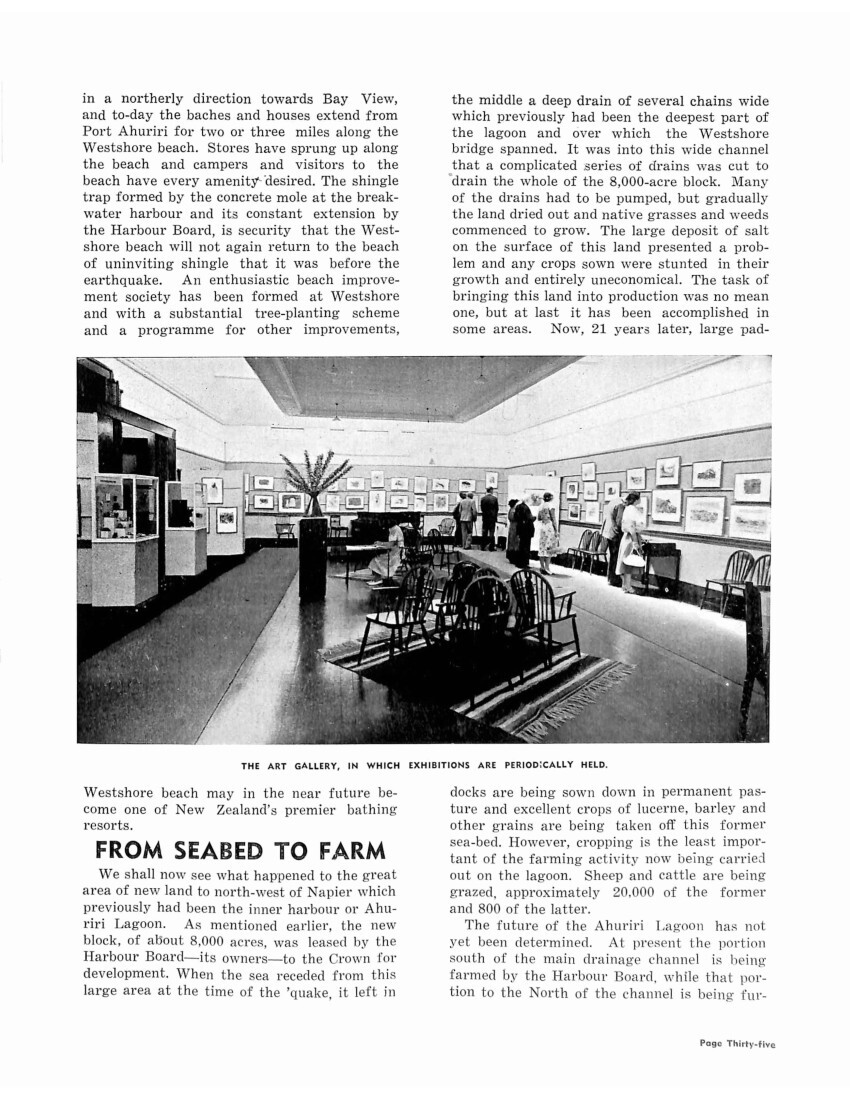
Page Thirty-six
[Advertisements]
BARCLAY MOTORS LTD
SPECIALISTS IN ALL CLASSES OF MOTOR REPAIRS
119 HASTINGS STREET,
NAPIER
TELEPHONE 2827
FERGUSON TRACTORS & IMPLEMENTS.
JOWETT JAVELIN CARS BRADFORD COMMERCIAL VEHICLES
ATCO MOTOR MOWERS MAYFIELD MOTOR SCYTHES
GRAVELY GARDEN TRACTORS SIMAR ROTOTILLERS DOBBINS SPRAYERS
SPECIALISED LUBRICATION PETROL OIL TYRES
Hawkes Bay Furs
TELEPHONE 2321
HASTINGS STREET, NAPIER
FOR
HOMES
FARMS
BUSINESSES
CONTACT
PAVIOUR-SMITH
LIMITED
REAL ESTATE AGENTS AND AUCTIONEERS
F.R. BURNLEY LAND DEPT. PHONES: 3823 Day 4789 Night
DICKENS STREET, NAPIER
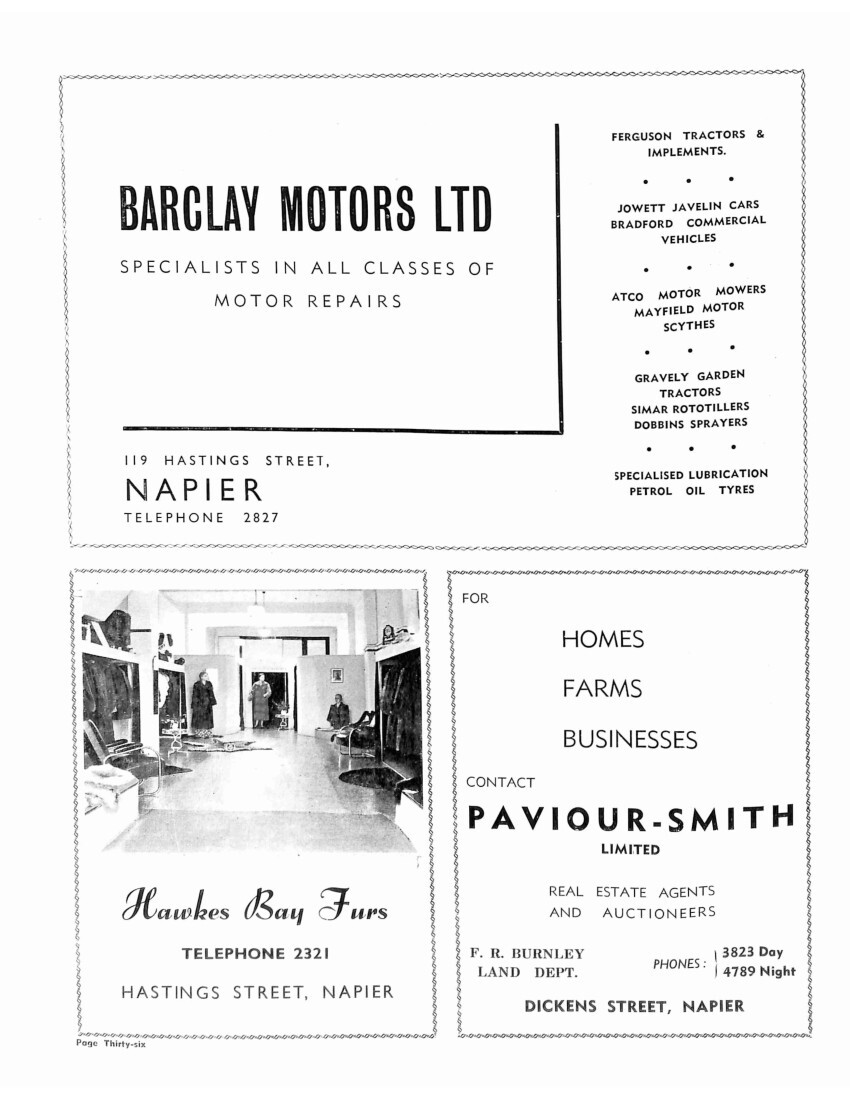
Page Thirty-seven
developed and farmed by the Crown. Of course, the initial drainage and development was carried out at the expense of the Crown and to the extent of this the Harbour Board was mortgaged.
Whether or not the lagoon will ultimately become small farms, building sites or a great industrial area is in the lap of the Gods, but one thing is certain, and that is, whatever is done with it, it is a great potential for the extension of Napier.
Other lands raised by the earthquake have
Photo caption – TOP: Napier’s modern airport. CENTRE: View of the City from Bluff Hill. BOTTOM: All set for a happy holiday!
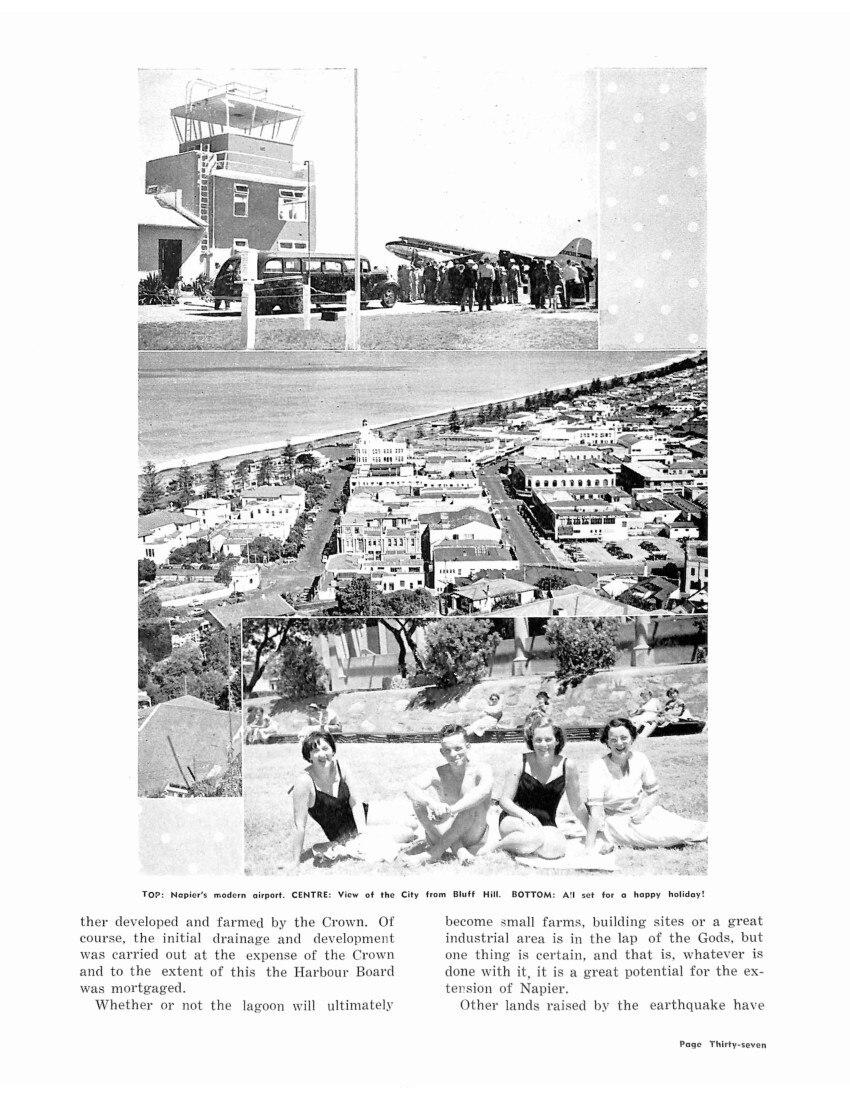
Page Thirty-eight
[Advertisements]
real home beauty!
FOR THE BEST QUALITY INTERIOR AND EXTERIOR PLASTERING
For all your requirements
Consult
A. DALLIMORE & SONS LTD.
231 HASTINGS STREET
PHONE 3234 NAPIER
75 years ago duck shooters set out from the inner beaches at the rear of the Gas Works in Wellesley Road to pursue this sport over what is now Napier South. In those days the reclamation of this area was never contemplated. With Napier’s expansion the demands increased for an efficient cooking and heating fuel. The Napier Gas Company met this demand with an up-to-date Works supplying the growing town with gas. This expansion has continued over the years and consumers today are able to purchase up-to-the-minute appliances for all cooking, water-heating and space-heating requirements.
VIEWS OF THE MODERN SHOWROOM ARE PICTURED ABOVE PHONE
NAPIER GAS CO. LTD (Opp. P.O.), Hastings St., Napier 3426
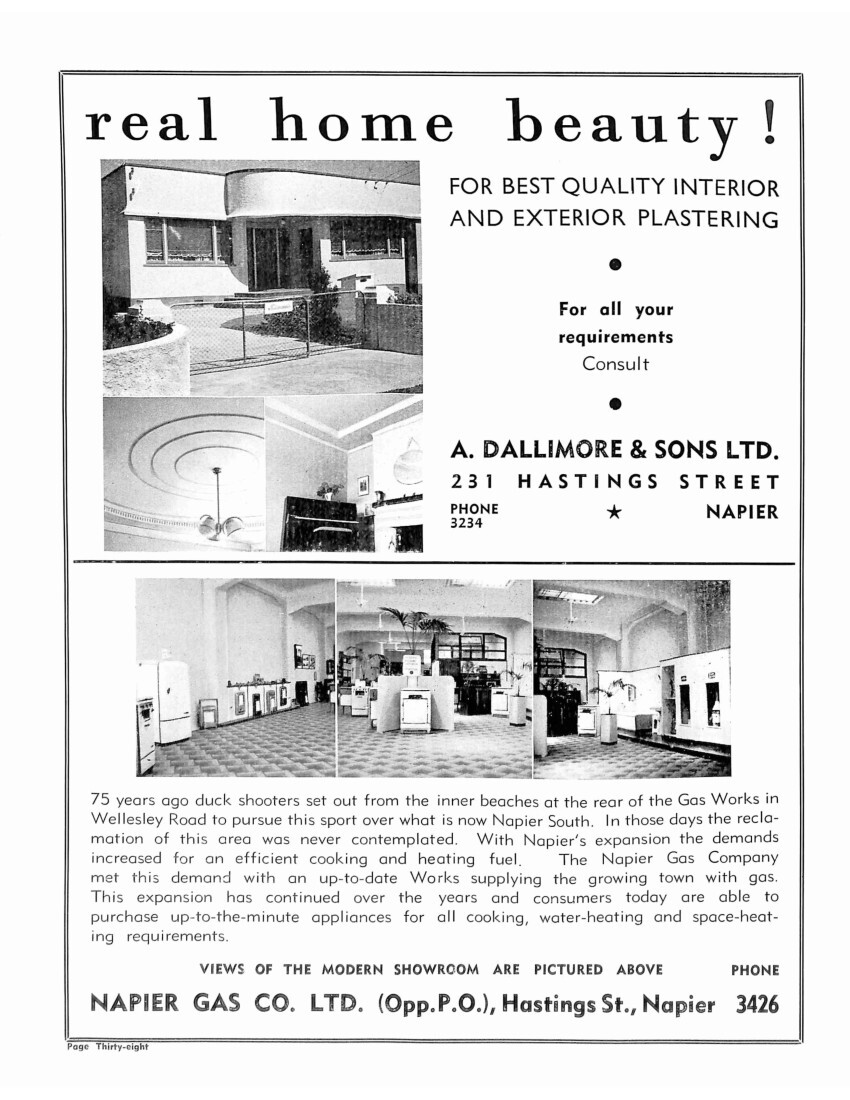
Page Thirty-nine
also been used to good effect. With Marewa and the Government housing block absorbed for residential purposes, and building sites on Scinde Island long since out of the question, the development of further land was essential. To the South of the main highway leading to the townships of Greenmeadows and Taradale, there lay a block of former swamp-land which had dried out with the years and required little additional drainage to bring it into a fit state for habitation. It was here that the Napier Borough Council decided that a new residential suburb to be named Onekawa should be established. With the final development of the land, the drainage and the roading completed, the sections were offered for sale to the public. Within a few days of the sale builders were on the job erecting the first house. Within weeks several more houses were under construction so that to-day Onekawa, formerly unsightly swamp, is now a flourishing suburb, still in its infancy, but growing rapidly.
To those who did not appreciate the hurly-burly of the town and wished to live even further afield, Greenmeadows and Taradale were inviting. As Napier grew, so did also these two townships. Building sites were available in profusion and, served by an excellent bus route, the five-mile trip to and from town was no hardship. It is now perfectly obvious that within comparatively few years these two townships will be rightful suburbs of Napier as houses dotted along both sides of the main highway linking the two areas are evidence of the final connection which will be made. Even now building sites in Taradale and Greenmeadows are becoming scarce and not many years will pass before these two townships will have overflowed into the low foothills and flat lands beyond.
For many years Napier was unable to offer anything attractive in the way of building sites to industry – both heavy and light. Cramped for space, the town was mostly concerned with housing its ever-increasing population. It was realised by the local authorities that some provision would have to be made for the industries clamouring for space in the areas adjacent to the town. The logical choice for such an area was the block of the Ahuriri Lagoon alongside the main road to Taradale on its northern side. This was developed rapidly and with the first subdivision it was obvious that these sites were ideal sites for light industries, sections were rapidly sold and timber merchants, joiners, builders and other such industries are now established on this area. An extension of the area is planned and already under way, and it is anticipated that several hundred light industrial concerns will eventually be housed in the block.
There is no doubt that Napier’s rapid advancement and the fact that the provision of a first-class port is well in sight heavier industries will be attracted to the district. Already the construction of a large fertilizer works is under way, and inquiries from many industrial concerns both within and without New Zealand indicate that interest in Napier from an industrial point of view is great. Twenty years ago, Napier had nothing to offer. To-day the reverse position presents itself. The
Photo caption – A VIEW SHOWING THE MODERN BUSINESS CENTRE OF THE CITY LARGELY RECONSTRUCTED AFTER 1931.
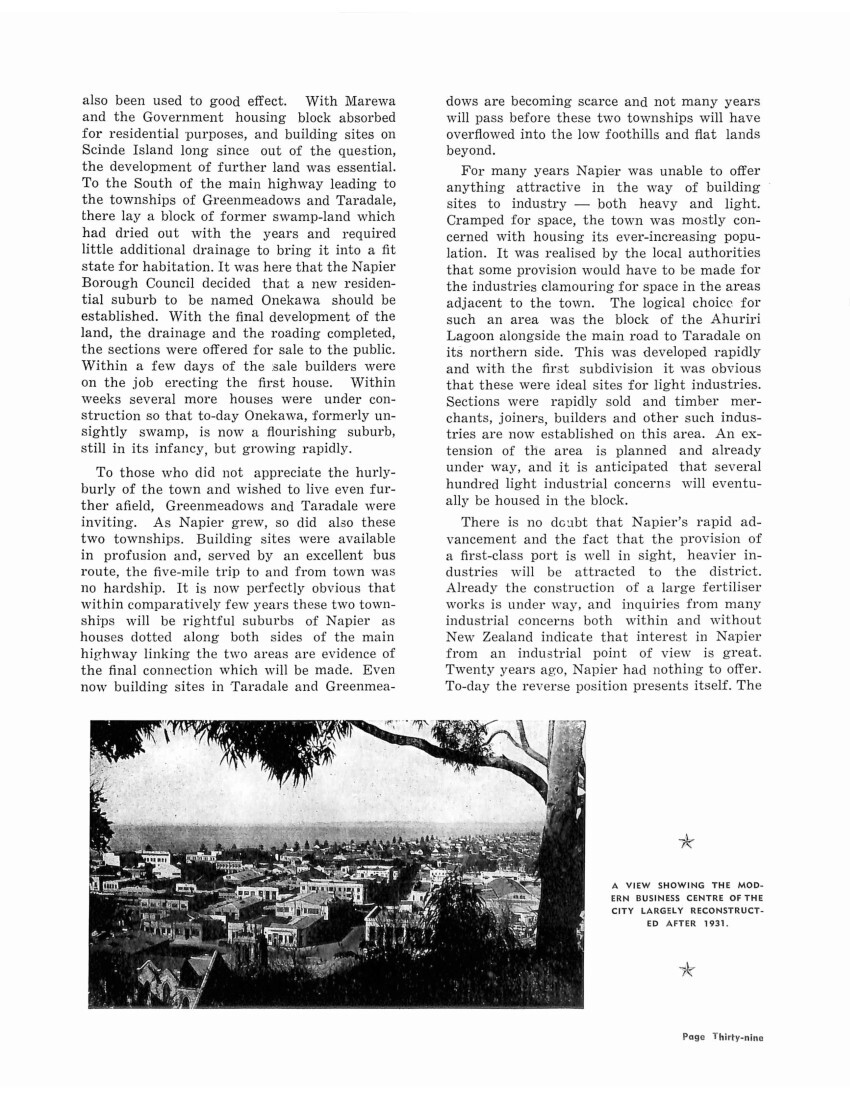
Page Forty
THE
HAWKES’ BAY FARMERS
CO-OPERATIVE ASSOCIATION LTD.
WOOLBROKERS, STOCK, STATION AND SHIPPING AGENTS, PRODUCE AND GENERAL MERCHANTS, LAND, ESTATE
AND INSURANCE AGENTS. GARAGE PROPRIETORS.
IMPORTERS – GENERAL MERCHANDISE AND SEEDS.
EXPORTERS – GRASS SEED.
SHIPPING
PORT LINE LTD.
CUNARD WHITE STAR LTD.
M.A.N.Z. LTD.
INSURANCE
ALLIANCE ASSURANCE CO. LTD.
ROYAL INSURANCE CO. LTD.
COMMERCIAL UNION ASSURANCE CO. LTD.
MERCHANDISE
YOUNG’S DIP
ELLIOT’S DRENCHES
LISTER SHEARING EQUIPMENT
WEEDONE HORMONE PRODUCTS
MOTOR VEHICLES
BUICK CARS
VAUXHALL CARS
CHEVROLET CARS AND TRUCKS
BEDFORD TRUCKS
Head Office: HASTINGS
Wool Stores: PORT AHURIRI
Telegraphic Address: “FARMERS.” Code: “BENTLEYS.”
BRANCHES THROUGHOUT HAWKES’ BAY
NAPIER WOOLLEN MILLS LTD.
MAIN STREET, ONEPOTO VALLEY
PHONE 2691
Manufacturers of “Lewisham” and “Monarch” Blankets, Rugs, Tweeds.
“Nae-Peer” Men’s and Boys’ Outerwear.
“Boy-Proof” School Shorts
Agents and Distributors
J. H. DALTON & CO. LTD.
AUCKLAND
P.O. BOX 1550
BARRY BROS.
LIMITED
Napier Port Ahuriri Hastings
CARTAGE CONTRACTORS
SHIPPING, CUSTOMS
FORWARDING AND DISTRIBUTING AGENTS
WOOD & COAL MERCHANTS
TAUPIRI COAL – CARBONETTES
COKE – FIREWOOD, ETC.
BARRY BROS.
LIMITED
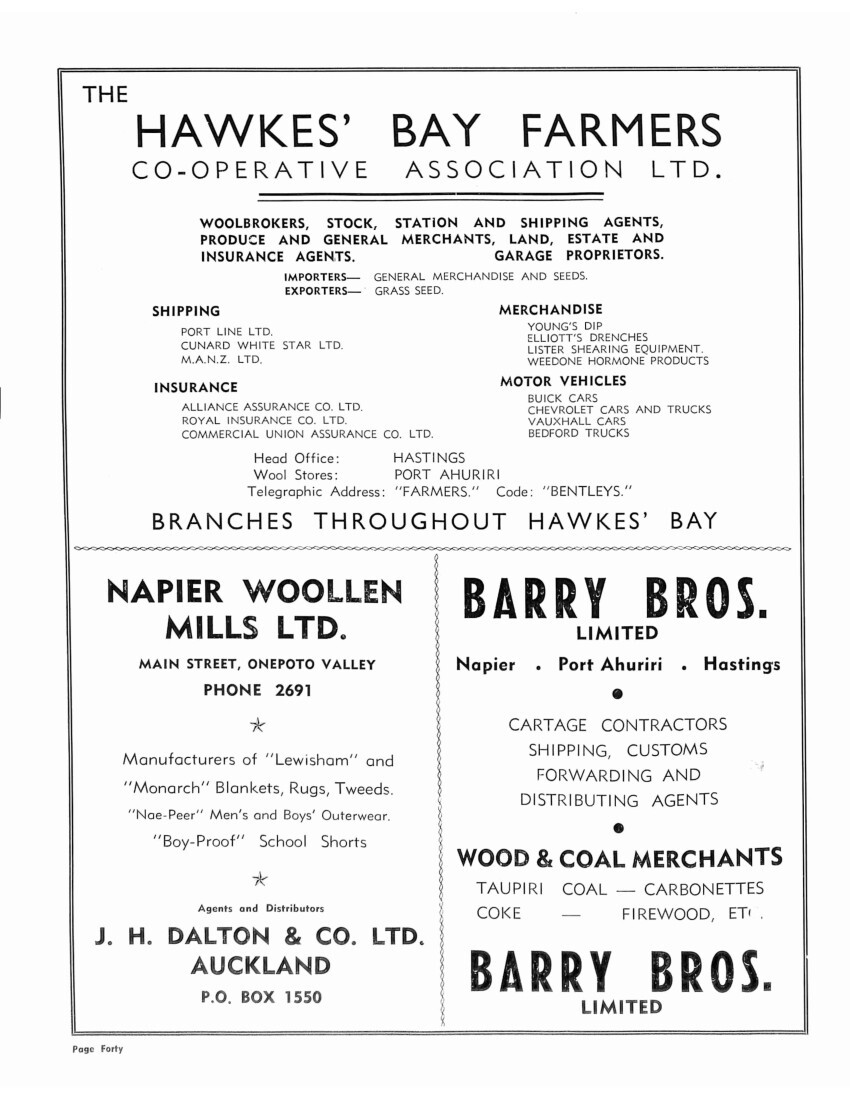
Page Forty-one
land is available, the railway service is good, highways are in good order and, above all, shipping facilities are right at hand.
The importance of Napier as an outlet for the produce from the rich Hawke’s Bay province has increased yearly. Fantastic quantities of wool, frozen meat and butter pass over the wharves annually. The linking by rail of Napier with Gisborne – a major engineering feat – has increased Napier’s importance manifestly. The importance of the Gisborne harbour has been negligible in the export of Poverty Bay’s produce, which has found its way to the Port of Napier for export overseas. During the wool and frozen meat season a succession of goods’ trains, trucks and coastal steamers brings huge quantities of produce from the North for shipping, while the road and rail service out of Napier take much needed produce to the cities. Hawke’s Bay – major fruit and vegetable producing province – plays a great part in the supply of these much needed commodities to the Wellington markets and as a great percentage of the market gardening industry is situated in the environs of Napier, all this produce passes through the town which acts as a receiving depot.
One of the great gifts of the earthquake to Napier was the airport. Situated on a portion of the Ahuriri Lagoon westward of Westshore, the airport of to-day is one of the finest in the Dominion. Completely unfettered by hill barriers, the ’drome is capable of unlimited extension. Practically fog-free the year round, it is an asset of inestimable value. The occasions since its formation on which aircraft have been unable to land at Napier are few and even on such occasions, the delay has never been for more than an hour or two. Prior to the earthquake, planes which did land at Napier – they were few and far between – used a paddock where the suburb of Onekawa now stands. Immediately after the ‘quake the Napier Aero Club obtained the use of land to the North-east of the Westshore embankment, but this was found to be too small with little chance of extension. Then land was obtained at the present site and the development of the great new airport proceeded apace. The Napier Aero Club is an enthusiastic body with a strong membership and has taken great pride in its facilities at the airport. Napier is now linked with every part of the Dominion by air and is a regular port of call for all the main services. Who knows what the future of the airways will be, but Napier citizens are content with the knowledge that, come what may, the Napier airport will be able to accommodate.
NAPIER – THE CITY
On March 18, 1950, Napier was 75 years old. Coincidence if you like, but on the same day, Napier became a City. A great achievement brought about by the courage of its citizens. Looking back over the years, it is doubtful whether any other city, town or place in New Zealand ever achieved so much in so few years. In the short space of 19 years, Napier rose from the dead to become an inspiration to the rest of the Dominion. City status was gained through hard work, forethought, planning and determination. How many places in New Zealand are in a similar position? How many have their whole life, their future before them?
Napier has been described as “a jewel of a
Photo caption – WOOL STORES AT PORT AHURIRI
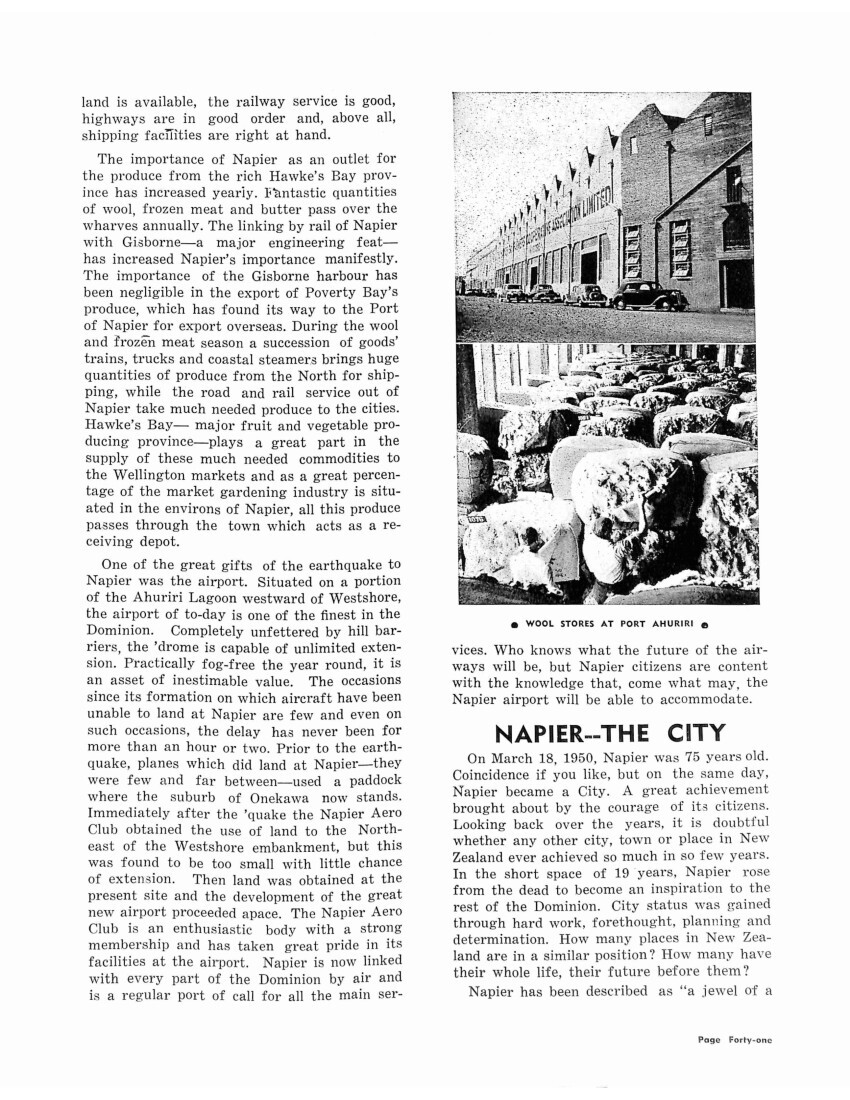
Page Forty-two
[Advertisement]
SHIPPING INSURANCE & TRAVEL AGENTS
BUILDERS’ MERCHANTS
Representing the following:-
GEO. H. SCALES LINE
BANK LINE LTD.
HUDDART PARKER LTD.
RUSSELL & SOMERS LTD.
(Australian Tours)
ANSETT INDUSTRIES LTD.
(Australian Travel)
C. H. CRANBY & CO. LTD
P.O. BOX 120
NAPIER 4173 TELEPHONES HASTINGS 4981
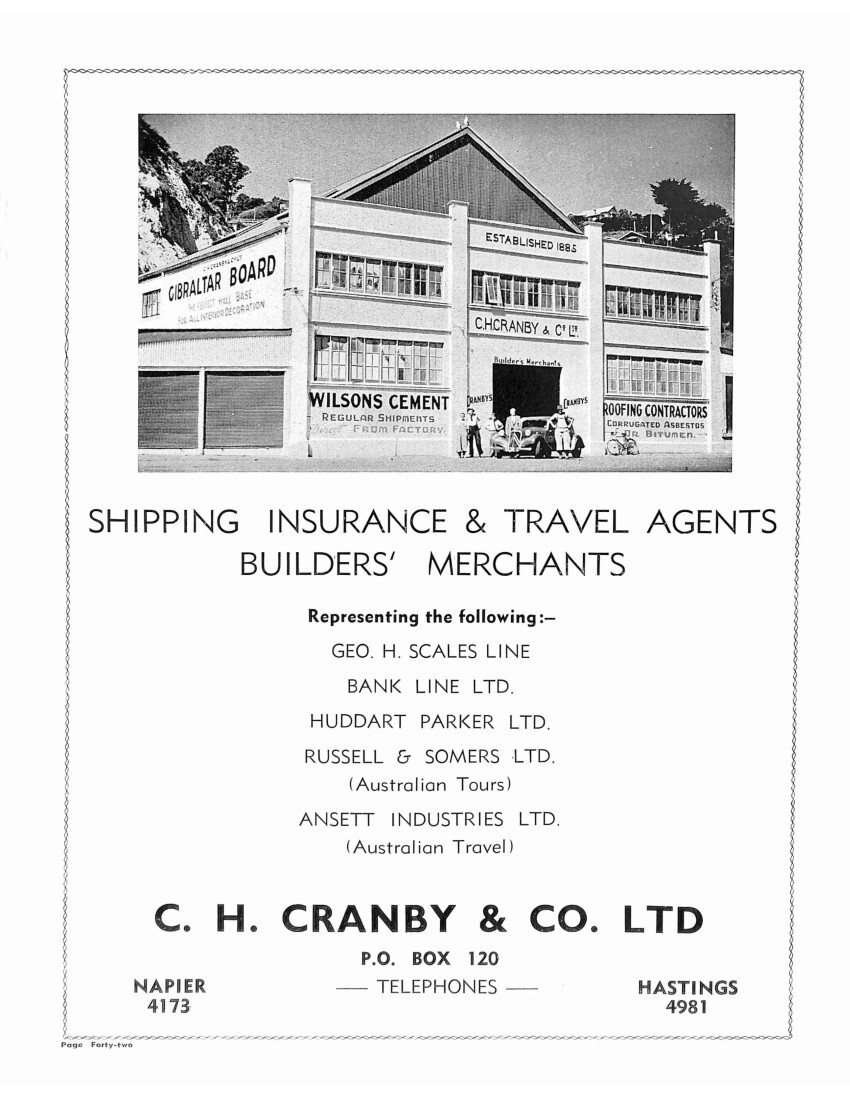
Page Forty-four
[Advertisements]
UNION HOTEL
ROY PILKINGTON (Prop.)
EXTENDS A WELCOME TO YOU!
Phone 2196
First-class Accommodation
Full Stocks Beers, Wines & Spirits
PORT AHURIRI
NAPIER AERO CLUB INC.
See Napier and District from the air!
Phone 5367 (2 lines)
SIGHT-SEEING CHARTER FLIGHTS INSTRUCTION
Box 30
I.L. PRIME Hon. Secretary
SPECIALISING IN
Shop and Office Fittings
JOINERY CONTRACTS PROMPTLY EXECUTED
JOINERY SUPPLIES LTD.
10A VIGOR BROWN ST.
Phone 3109 – Napier
STRUCTURAL WORK OF ALL CLASSES UNDERTAKEN
By CONTRACT
Or COST PLUS BASIS
FERGUSON CONSTRUCTION CO.
LIMITED
NAPIER
Phone 4052 Box 63
F. G. SMITH
& CO. LTD
GENERAL CARRIERS, SHIPPING, CUSTOMS & FORWARDING AGENTS
Bonded and Free Stores
Motor Lorries Daily to Hastings
TELEPHONE
4943 (2 lines)
Direct with Hastings
Telegraphic Address: “USABLE’
AGENTS: N.Z. EXPRESS CO. LTD.
PORT AHURIRI, NAPIER
MURRAY & MARPLE
MANUFACTURERS OF FIBROUS PLASTER
The Perfect Finish for a Well-Built House …
For Enduring Beauty it must be Fibrous Plaster
Hyderabad Rd. Phone 4593 Napier
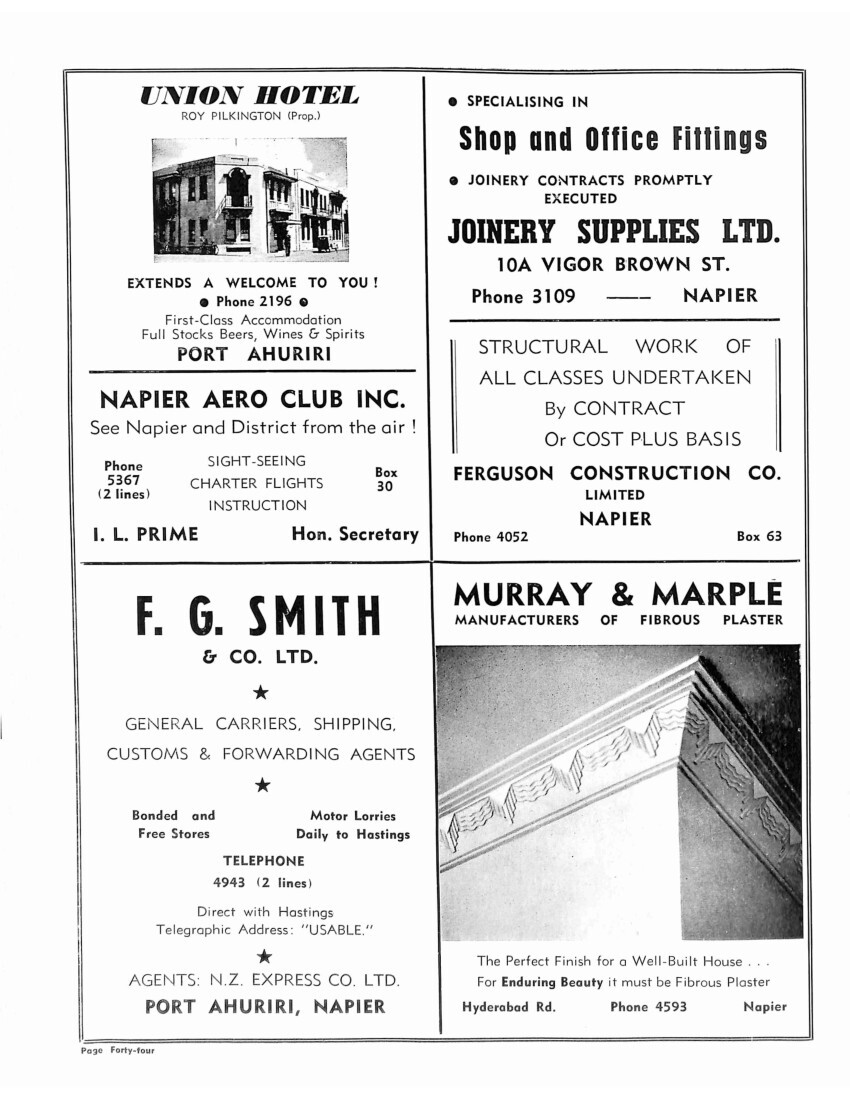
Page Forty-five
city”. Little wonder at this description, for, in fact, it is. There is something about it which fascinates. It is a hard place to leave. Many have tried it, only to return and settle. It may be said that it is the climate – perhaps so, but that is not all there is to it. It is a friendly city. Its people are friendly and keen to make the visitor welcome. The citizens are proud of the place in which they live and take pride in showing it to the others. They are not show-offs, but want the visitor to feel the same way about Napier as they do. It is a deep-rooted pride, born in adversity.
A trip through and around Napier is a constant delight. The shopping area is just one great display in an attractive setting. No unsightly telephone and power poles to mar the artistic lines of the main streets, coloured facades on the buildings, wide footpaths, wide streets, an air of cleanliness everywhere. Even on the hottest afternoon in Summer the cooling breeze off the sea – a few hundred yards away – makes conditions bearable and removes all the stuffiness and closeness associated with most other New Zealand cities. “Sunshine and Sea Breezes” was a motto used by the Napier Thirty Thousand Club 30 years ago. The same motto holds good to-day. That is Napier in the Summer – Sunshine and Sea Breezes.
A couple of minutes’ walk from the city in either direction and the visitor finds himself surrounded by gardens and flowers. At the southern end of Emerson Street – the main city thoroughfare – is situated Clive Square, a veritable oasis of natural beauty in the heart of the business area. Trim and well kept, these gardens are the admiration of all visitors. It is here that one can rest awhile in the shade of the huge trees and gaze at the panorama of colour spread before him. Clive Square is small – but it is nevertheless a real gem.
To the magnificent Marine Parade at the other end of Emerson Street is only a matter of minutes. Here the visitor can spend delightful hours in one of the most beautiful spots in New Zealand. It is a spot of man-made beauty carved from disaster. From the Napier Municipal Baths and children’s play area to the North, to the tennis courts at the southern end, stretches a mile of green lawns, gardens, skating rink, putting greens, sound shell, colonnade, sun bay and a host of other attractions – all beautiful in conception and kept in the extreme tidiness. Beyond lies the wide sweep of Hawke’s Bay with Cape Kidnappers jutting out like an encircling and protective arm.
Summer and Winter, the scene is almost the same. Napier’s sunshine is not an altogether Summer affair. It probably leads New Zealand in Winter sunshine as the storms which sweep over the North Island from the Tasman Sea during the Winter months spend themselves on the mountain barriers of the Ruahine and Kaweka ranges long before they reach Napier and the coast. To the aged and the infirm there is no better resting place than the Marine Parade. The baths offer hot salt water facilities
Photo caption – VIEW OF THE WOOL STORES AT THE OLD PORT, WITH WESTSHORE BEYOND.

Page Forty-six
[Advertisements]
“Cleanliness with Civility”
GRILLS OYSTERS & WHITEBAIT (IN SEASON)
NATIONAL CAFE
(Proprietor: N. PAXIE)
FISH & CHIPS
A SPECIALTY
PHONE 2619
EMERSON ST. (NEXT MAYFAIR THEATRE)
ARNOTT’S
1 HASTINGS STREET
HEADQUARTERS FOR SPORTS EQUIPMENT
Phone 2785
BADMINTON HOCKEY
TENNIS FOOTBALL
CRICKET SOFTBALL
GOLF SOCCER
BASKETBALL
RESTRINGING & REPAIRS
MODEL AIR KIT SETS MECCANO
PLANS AND BALSA HORNBY
SAVE MILES OF WALKING BY COMING TO
ARNOTT’S FIRST
WHY NOT VISIT THE –
DISABLED SERVICEMEN’S SHOP
We have a complete range of attractive Fancy Goods, Paua Jewellery, Toys, Travel Goods, Etc.
UPHOLSTERY
CAR TRIMMING
AND ALL TYPES OF BASKET WARE A SPECIALTY
PHONES:
3433 (Shop)
2247 (Office)
CNR OF EMERSON & DALTON STREETS NAPIER
THE
OPEN WAREHOUSE
EMERSON STREET
FOR SMART WEAR AT LOWER PRICES
THOMPSON ELECTRICAL CO. LTD.
SHAKESPEARE RD. PHONE 2153. Private 5058.
ELECTRICAL SALES INSTALLATIONS AND REPAIRS
PHONE 2153
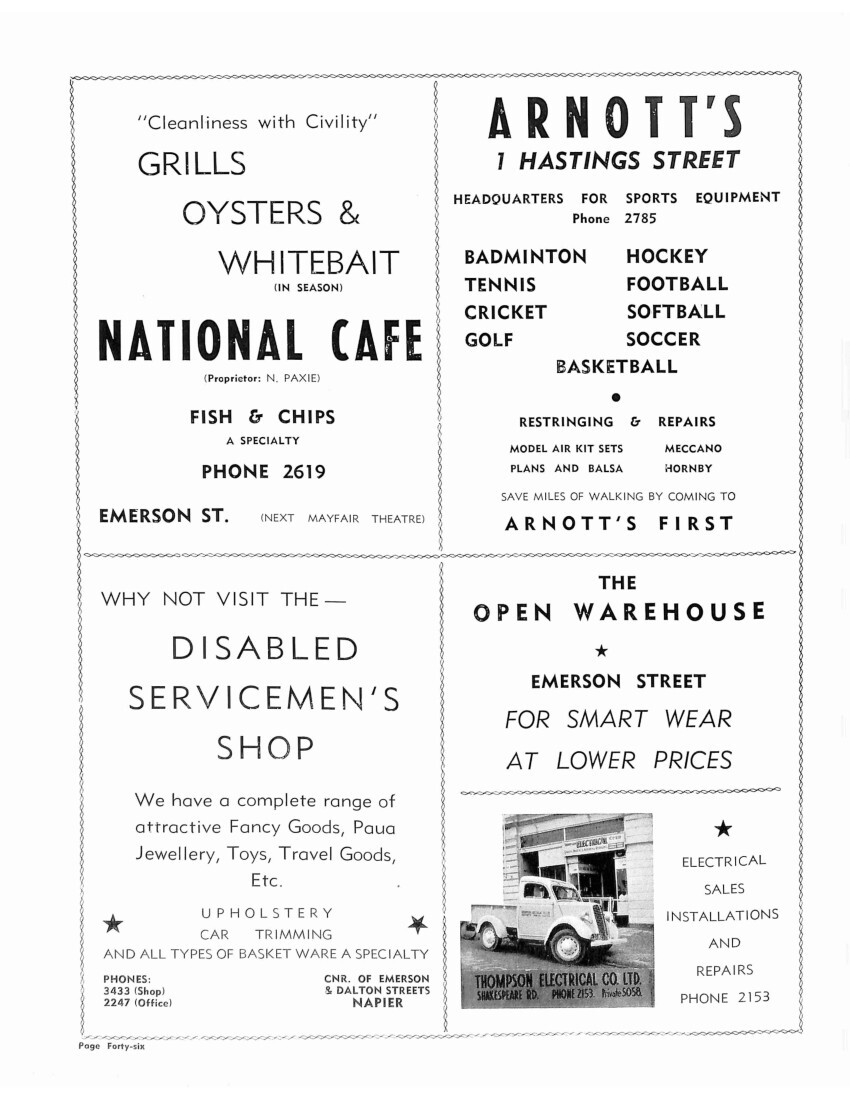
Page Forty-eight
[Advertisements]
BAXTRIDGES
THE FRIENDLY STORE FOR THE KIDDIES
TOYS FOR GOOD GIRLS AND BOYS
SPECIALISTS IN KIDDIES WEAR
IN DICKENS ST. OPP. STATE THEATRE PHONE 2576
FOR SECURITY STABILITY SERVICE
INSURE WITH
THE NATIONAL INSURANCE COMPANY
OF N.Z. LIMITED
Head Office: DUNEDIN.
FIRE
MARINE
ACCIDENT
MOTOR VEHICLE
THE NATIONAL INSURANCE COMPANY OF NEW ZEALAND LIMITED
INSURANCES ACCEPTED AT LOWEST CURRENT RATES
PHONES 54214, 2714
Chief Agents to Hawke’s Bay:
WILLIAMS & KETTLE LTD.
NAPIER OFFICE 7 BROWNING STREET

Page Forty-nine
which have a great record for curative properties as a long list of testimonials prove.
Scinde Island is interwoven with winding hill roads from each of which a commanding view of either the city of the harbour (or both) is obtained. With the climate which it enjoys, it is only natural that Napier should be a city of flowers – and such it is. Many species in horticulture which will not flourish in other parts of the Dominion, thrive in Napier, with the result that the city as well as the residential gardens are a constant picture of colour all the year round. A glorious panorama of Westshore and the old Port Ahuriri can be gained from the top of Barrack Hill, on which is sited the Public Hospital. Bathed in sunshine from the time the sun rises out of the sea until it sets behind the foothills of the Kawekas, the hospital is in an enviable position. Patients on the balconies and in the wards have a constant view of the wide sweep of the western portion of the bay with a foreground of flowers and trees.
The Napier hills are crammed full of vantage points for viewing the city. From the top of the Bluff Hill, the visitor can look down 300 feet on to the harbour, stretched out before him in all its rugged beauty. From a point further South he can look down the same 300 feet on to the city and gaze along the Marine Parade as far as his eyes will allow. Stretched before him he will see a perfect vision of sea, sky, pasture and City. He may also be able to trace the tortuous windings of the Tutaekuri and Ngarororo [Ngaruroro] Rivers, which have their egress to the sea only a few miles distant. From here he will also realise how Napier has broken the chains of her confines of swamp and water and now has an open sweep of country into which she can pour her buildings, homes and industries.
For the sportsman, Napier has everything to offer. McLean and Nelson Parks, situated in the heart of Napier South, have a reputation for their perfection. The former is the home of Hawke’s Bay Rugby and in days gone by has seen many New Zealand famous Rugby players wearing the Black and White jerseys of Hawke’s Bay. During the Summer months, McLean Park is the venue for the regular weekly meetings of the Napier Amateur Athletic and Cycling Club, and the visitor to the town is always assured of a fine evening’s sport. Nelson Park, on the other hand, is the home of Cricket. It is a perfect oval and its Cricket wickets have won renown among cricketers in New Zealand and those who have come outside countries. In Winter, Nelson Park is the home of Hockey, Soccer, and lower grade Rugby. Napier is well supplied with Bowling clubs, both on the flats and on the hills. Croquet clubs are attached generally to the bowling clubs and are
Photo caption – CLEARING THE DEBRIS – AFTER THE DISASTROUS EARTHQUAKE OF 1931.

Page Fifty
[Advertisements]
CABARET CABANA
(UNDER NEW MANAGEMENT)
PHONE 3025
AVAILABLE FOR CONFERENCES PRIVATE BALLS PARTIES WEDDINGS
BOX 293 NAPIER
CABARET OPEN EVERY SATURDAY NIGHT DURING SEASON
The Strength & Stability of “ALL WELDED STEEL” construction.
For Tubular Steel Framed – Buses
Ambulances
Station Waggons
Van & general commercial bodies – Panelled in Aluminium.
Body by –
NUTTALL
BODYWORK by
NUTTALL
F.J. NUTTALL & SON
Custom Motors
Body Builders
SALE STREET NAPIER
F.J. Nuttall & Son Ltd. Motor Body designers & builders
Sale St., Napier. Phone 3933
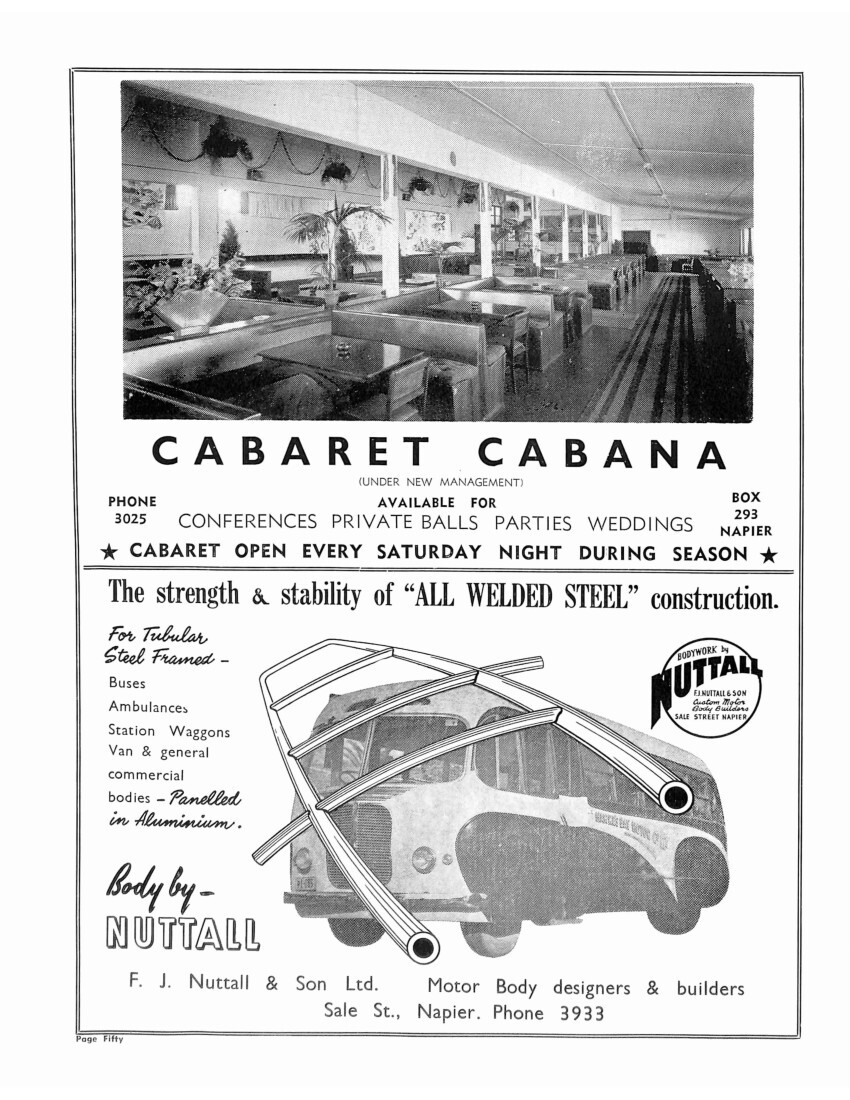
Page Fifty-two
[Advertisements]
We Specialise In
WEDDINGS
& All
FLORAL EMBLEMS
CUT FLOWERS
TE AWA NURSERIES
(T.C. HOWDEN)
103 NELSON CRESCENT
We Telegraph Flowers
Phone 4146 NAPIER
The Success of the Wedding or Social Function depends on the Catering.
Let us arrange the Catering for your Wedding, etc.
There is no possibility of any failure, when this is left in the hands of
ESTHER’S
“The Leading Caterers”
Order Your Wedding Cake & arrange your Reception and Breakfast with
ESTHER’S
Parties, Socials, Dances, etc. catered for.
EMERSON ST., NAPIER PHONE 3893
McDONALD’S WINES LIMITED
VIEW OF WINERY AND GREENMEADOWS VINEYARDS
Manufacturers of HIGH QUALITY DRY AND SWEET WINES – Price list on Application
CHURCH RD. GREENMEADOWS PHONE 23 TARADALE
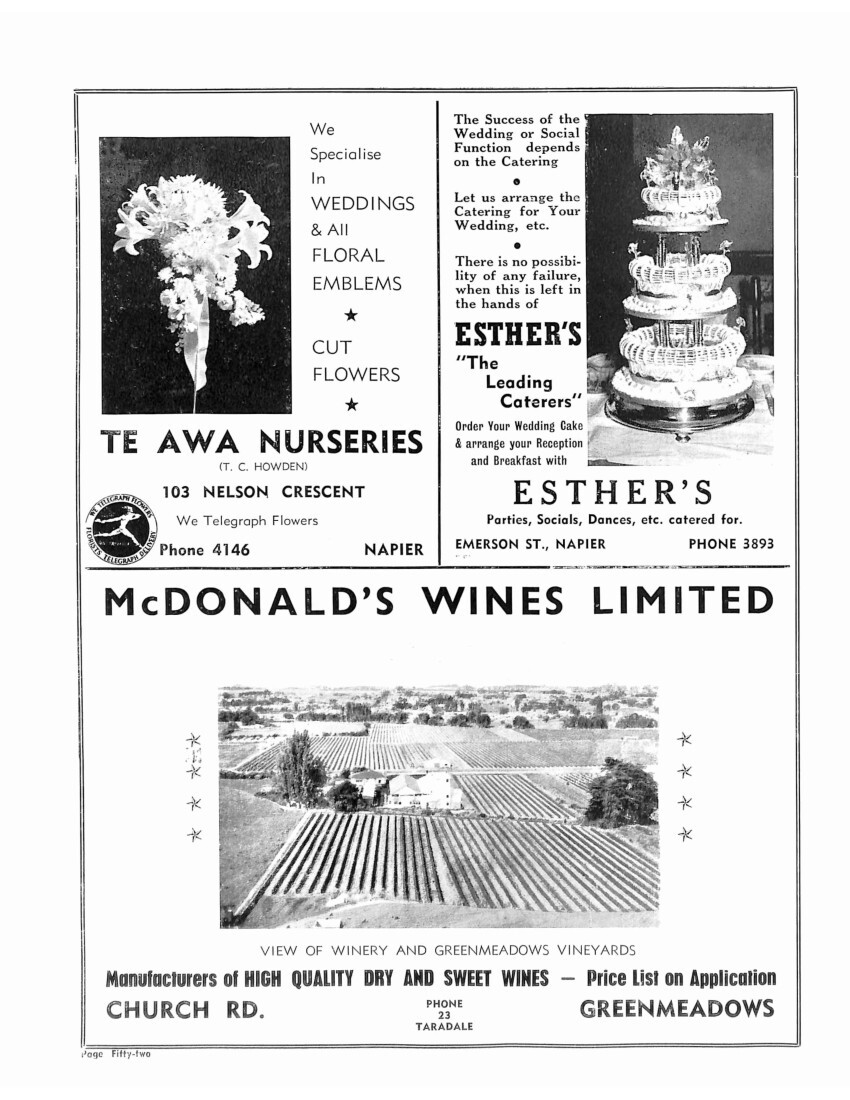
Page Fifty-three
popular. Two golf clubs, the Napier Club at Waiohiki (beyond Taradale) and the Maraenui Club (at Awatoto) meet the needs of golfers. Both are 18-hole courses and are set in fine picturesque surroundings. Tennis clubs thrive in Napier and both grass and hard courts of excellent standard are available. For general public use, four courts are available on the Marine Parade both day and night.
Swimming is more than a pastime, it is an institution with Napier citizens and visitors. The Napier Municipal Baths, recently made tepid, is among the top-ranking pools in the Dominion. Built in Napier’s early history, the pool has been recently modernized in all respects and is a popular draw during the Summer months. For the younger fry a large paddling pool surrounded by shelter bays meets the needs of Napier’s growing generation. The paddling pool is shallow and safe even for the tiny tots. The main Napier beach along the Marine Parade is safe – for good swimmers. There are times when the shingle is on the move and dips occur in the sea bed a short distance off-shore, which tend to make swimming for the learner a trifle dangerous. The water is deep off-shore and caution is required by those who cannot class themselves in the reasonably good swimmer class. However, when there is any danger red flags are flown as a warning signal from the top of the Municipal Baths and any person swimming when the red flags are flying has only himself to blame if an accident should occur. The beach is constantly patrolled by the Swimming and Life-Saving clubs as an added precaution.
For safe swimming and perfect surfing, Westshore is the ideal. It is only a few miles from the heart of the city and is served regularly by buses. Here one can swim with perfect safety. The water is reasonably shallow and the beach is not marred by the tidal sets, undertows and currents generally associated with long sloping sandy beaches of this kind. Of course, during particularly heavy seas, Westshore, like all other beaches, can be dangerous to the inexperienced swimmer, but it could not by any stretch of the imagination be put in the “dangerous beach” category.
For the sportsman with hook and line, Hawke’s Bay has plenty of fish. In calm weather good fishing is obtainable off the beaches themselves, both the main Napier beach and at Westshore. Launches can be hired by the day or hour for those who wish to venture further out on to the Pania reef (off the breakwater harbour) where cod, schnapper, groper and crayfish abound. Hawke’s Bay rivers are a challenge to the fly fisherman and in season good bags are obtainable when the rivers are clear. During the Summer months this is the rule rather than the exception, and trout in good condition abound. Deep sea fishing is a possibility in Hawke’s Bay. It has not yet been tried, but in recent years commercial fishermen have discovered swordfish of considerable size in their nets and it may not be far distant when Napier becomes a deep-sea fishing base.
WINE IN THE MAKING
Sun, soil and water combine to provide perfect elements for the growth of the grape and manufacture of wines. While some New Zealanders have not yet achieved a palate for dinner wines, the influx of many European new settlers in the recent years will, no doubt, have a definite influence in this direction. In preparation for this change in national habits, Hawke’s Bay has, for over sixty years, been preparing the basis for a large wine industry. Near Napier, at Greenmeadows, both commercial firms and members of a religious order have established vineyards and wineries which produce fine quality light wines which are most palatable, such wines, be it noted, having been successful in winning overseas merit awards against all comers! It is interesting to note that there are some 5,500 different classified varieties of grapes known to viniculturists, but most vineyards cultivate certain basic varieties best suited to local conditions, which have proved to make the best and most indefectible wines according to the district in which they are grown. Hawke’s Bay has shown consistently high quality as well as fortified sweet wines. Grapes for wine-making mature from late February until the end of April and are then picked by local labour. The grapes are then mechanically crushed and the juice and pulp are then pumped into fermenting vats of up to 2,000 gallons in size. As fermentation progresses the level of the crude wine therein rises from six to nine inches and in the early stages carbon dioxide gas is generated quite vigorously.
Fermentation is allowed to proceed several days, control being exercised over the rise in temperature, after which the vats are runoff into “holding vessels”. This new wine is left
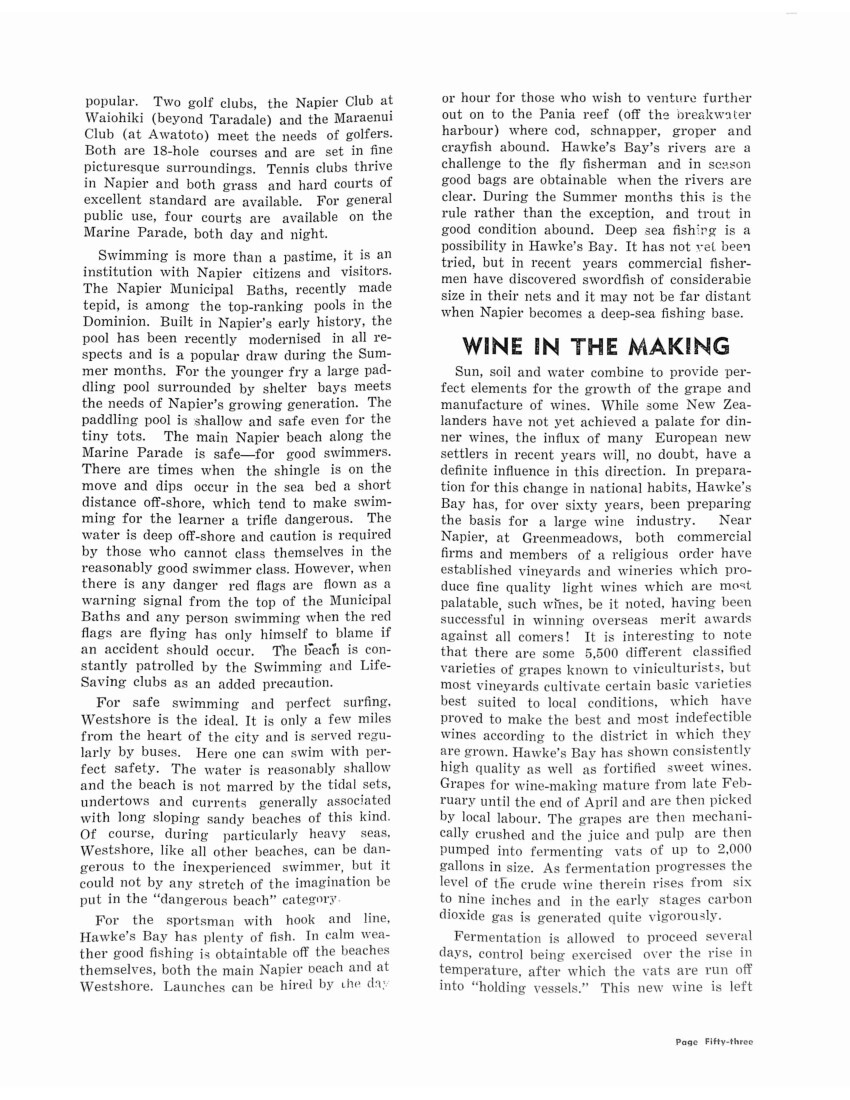
Page Fifty-four
[Advertisements]
READINGS
Pastrycooks and Food Purveyors
EMERSON STREET, NAPIER
BRUCE HAWKINS
NAPIER’S LEADING
SPORTS DEALER & BOOT REPAIRER
MARKET ST., NAPIER, AND MAREWA SHOPPING CENTRE
PHONE
3336
Football, Basketball, Hockey, Badminton, Golf, Darts, Boxing & Fencing Equipment
Table Tennis, all Sporting Accessories, including the famous Gilbert Rugby Balls
IT WILL PAY YOU TO VISIT OUR STORES FOR YOUR NEEDS
PHILCO
FAMOUS FOR QUALITY THE WORLD OVER
THE NEW PHILCO THE NEW PHILCO
PHILCO RADIOS
EASYWAY WASHING MACHINES
VACTRIC CLEANERS
MORPHY-RICHARDS IRONS & TOASTERS
ALL ELECTRICAL APPLIANCES
Repairs to all makes of radios
BONOCHORD HEARING AIDS
PHILCO HOUSE
10 MARKET STREET NAPIER
THE LITTLE SHOP WITH THE OUTSTANDING AGENCIES
PALM GROVE MILK BAR
AND CAFETERIA
THE MOST UP-TO-DATE & LARGEST MILK BAR IN HAWKE’S BAY
Efficient & Courteous Service Assured
Open – 9 a.m. – 11 p.m. MON-SAT 2 p.m. – 10 p.m. SUNDAY
Phone 2221 EMERSON ST.

Page Fifty-five
for about six months during which time fermentation finishes and the sediment separates out. Rotational racking is the method adopted to clear the wine thoroughly of all traces of sediment and when the wine is thus cleared, it is then run into storage vats to mature, which takes from one to three years, before being bottled for consumption.
Here, once more, Hawke’s Bay demonstrates that it is able to extract the maximum from its most notable element – the sun, as well as its natural soil fertility.
BEAUTIFUL ENVIRONS
A motor drive out to Greenmeadows, Taradale and Bay View are well worth while for the visitor. At the former township an item of interest is the Hawke’s Bay Acclimatisation Society’s game farm where several Kiwis are kept in captivity. Most visitors to New Zealand from overseas are interested in seeing a real live kiwi (New Zealand’s National Bird emblem) and this is the only place in the country where they can see one alive. It is here that a careful
Photo captions –
THE COLONNADE AND SKATING RINK.
VIEW OF THE MARINE PARADE FROM THE T. & G. BUILDING.

Page Fifty-six
[Advertisements]
LET US PAINT YOUR HOMES, FARMS & BUSINESS PREMISES, ETC.
W. LeROY LIMITED
Member of the Hawke’s Bay Master Painters’ Association.
45 TARADALE RD. NAPIER
PHONE: 2647 NAPIER
Fenwick Motors Ltd.
service
TO ALL MAKES OF CARS
MOTORISTS’ BREAKDOWN SERVICE AVAILABLE
PHONES GARAGE 2663 RES. 48-455
44 TENNYSON ST. NAPIER
THE NEW ZEALAND ELECTRICAL FEDERATION WELLINGTON DISTRICT ELECTRICAL CONTRACTORS ASSN. INC.
SHAW & ANSIN LIMITED
Electrical Contractors
DOMESTIC & COMMERCIAL INSTALLATIONS UNDERTAKEN
PHONES 2680; RES. 2444
3 VIGOR BROWN ST., NAPIER

Page Fifty-eight
study of the Kiwi and its habits has been made and much of the data concerning the birds which has become available in recent years has been the result of this experiment at Greenmeadows.
Taradale, a thriving township, is the scene of constant activity in the vineyards and market gardens. A small village 20 years ago, Taradale has grown rapidly and now is an important shopping centre for the large farmlands which lie beyond. It has grown step by step with Napier and some day may be drawn into the compass of the expanding city.
Beyond Taradale the traveller enters the orchard district of Pakowhai and Meanee [Meeanee], where fruit freshly picked from the trees can be purchased at the roadside. Neat lines of orchard trees, each plot protected by belts of Lombardy poplars, stretch along both sides of the highway and bear testimony to the district’s capacity as a fruit-growing area.
Through Meanee with its tidy little dairy farmlets and the visitor once again meets the sea at Awatoto. From here Napier takes on a different aspect. The flats are hidden in horizon, broken by houses and trees, but Scinde Island stands out in bold relief, the sun glinting on the silver water tower which breaks the skyline on the top of the Bluff Hill. A few miles of level concrete highway and the city limits are entered at the southern extremity of the Marine Parade. Access to Napier from this direction is gained by several routes and perhaps the most popular and direct is via the Marine Parade itself, but a route well worth taking is that along George’s Drive, now planted in trees, shrubs and spacious lawns. From George’s Drive the route turns right into Kennedy Road, an attractive highway lined on either side with huge Phoenix palms, behind which stand typical Napier residences with their colourful gardens.
A visit to Napier would not be complete without a motor trip to the North. Past Westshore, with the airport on the left, the visitor finds himself in the township of Bay View. Here is the real market gardening area of Hawke’s Bay. Frost-free the year round, vegetables of all varieties are grown by the acre. Here again the plots are tidy and well-kept, and during the harvesting season a constant flow of vehicles carrying produce to the market can be seen. At Bay View the highway turns to the left to Taupo and to the right to Gisborne
Photo caption – PETER PAN PRODUCTS MANUFACTURED BY T.C. DENNE & CO, LTD., WAIPUKURAU
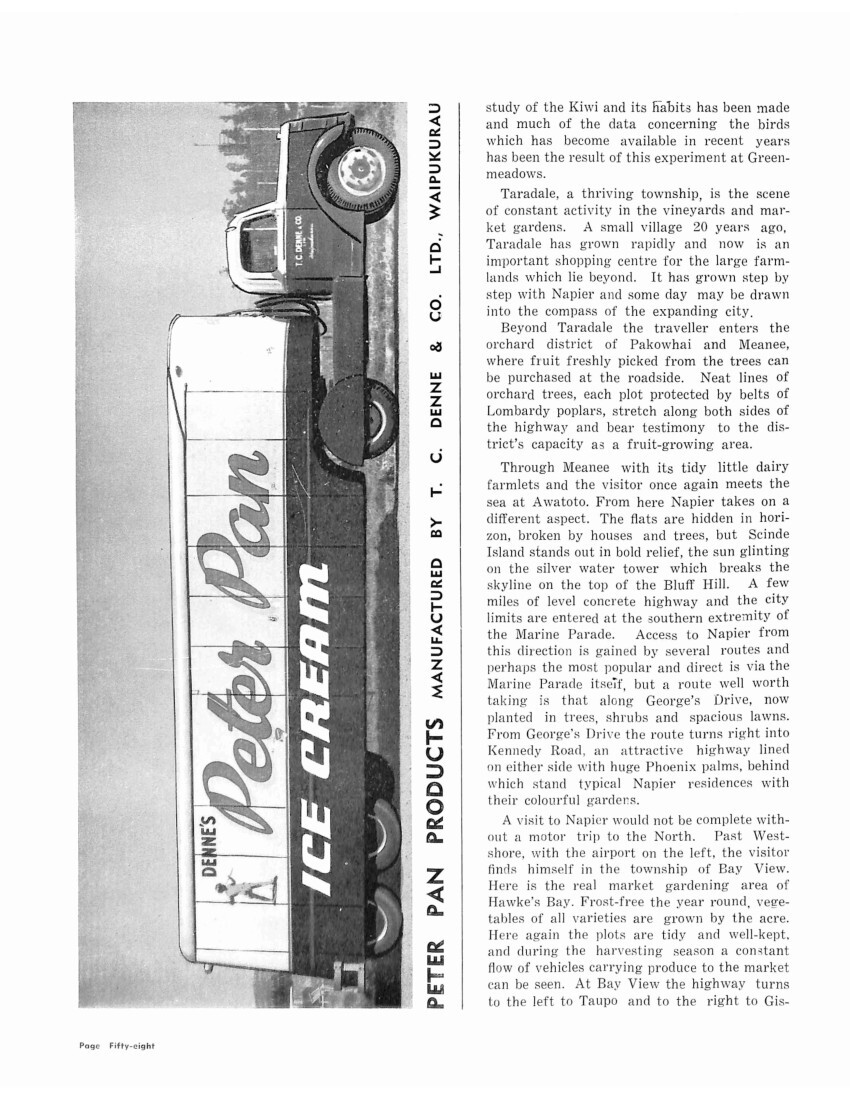
Page Fifty-nine
and Wairoa. The left turn takes the traveller over the Esk Hill and down into the Esk Valley. This beautiful little valley is something to gaze upon from the top of the hill. It is perfect in every detail. Flat green pastures dotted with sheep and cattle, a slow winding river, fringed with weeping willow trees, gaily painted farm houses, neat fences and tidy farms. The picture is entirely satisfying. Yet, Eskdale is synonomous [synonymous] with Napier in one detail. It met disaster. On the night of April 24, 1938, after three days’ steady rain, the little Esk river ran amok. Nobody really knows why, but it is surmised that a landslide in the upper reaches caused a dam, which finally burst releasing a vast volume of water, which roared down the valley sweeping all before it. In a few moments houses were swirling with water to their rooftops. Stock were swept against the fences and drowned. When the water subsided
Photo captions –
THIS AERIAL VIEW SHOWS THE FULL EXTENT OF THE MARINE PARADE.
EMERSON STREET, NAPIER.
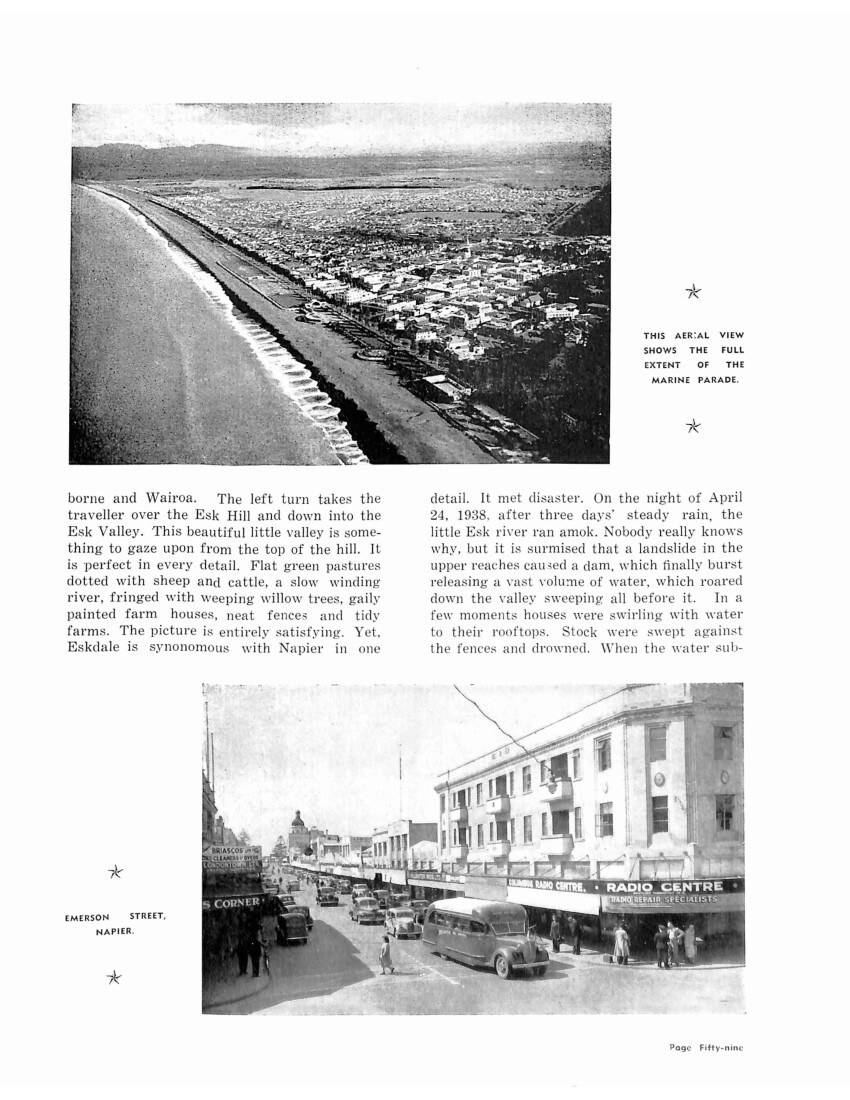
Page Sixty
[Advertisements]
GILBERD’S
ESTABLISHED 1865
SPECIALISTS IN –
“RUGBY” DRY GINGER ALE
FRUIT DRINKS
CORDIALS, Etc.
that have stood
“The Taste of Time”
GILBERD & CO. LTD.
KENNEDY RD. NAPIER
Excelsior Butchery
For
QUALITY CIVILITY
AND
Attention to Orders
Large or Small
Phone 3082
Emerson Street Napier
DEIGHTON STUDIOS
NAPIER
PERSONAL PORTRAITURE
AND
DAINTY MINIATURES
IN NATURAL COLOURS
Phone 2856
ROWE & YOUNG
PANEL BEATERS
61 TENNYSON STREET PHONE 2362
NAPIER ENGINEERING CO. LTD
SPECIALISING IN
WELDING, FITTING, TURNING, AND DIESEL MAINTENANCE
PHONES
Works 5339 Private 4337 & 48-709
10 THACKERAY STREET, NAPIER
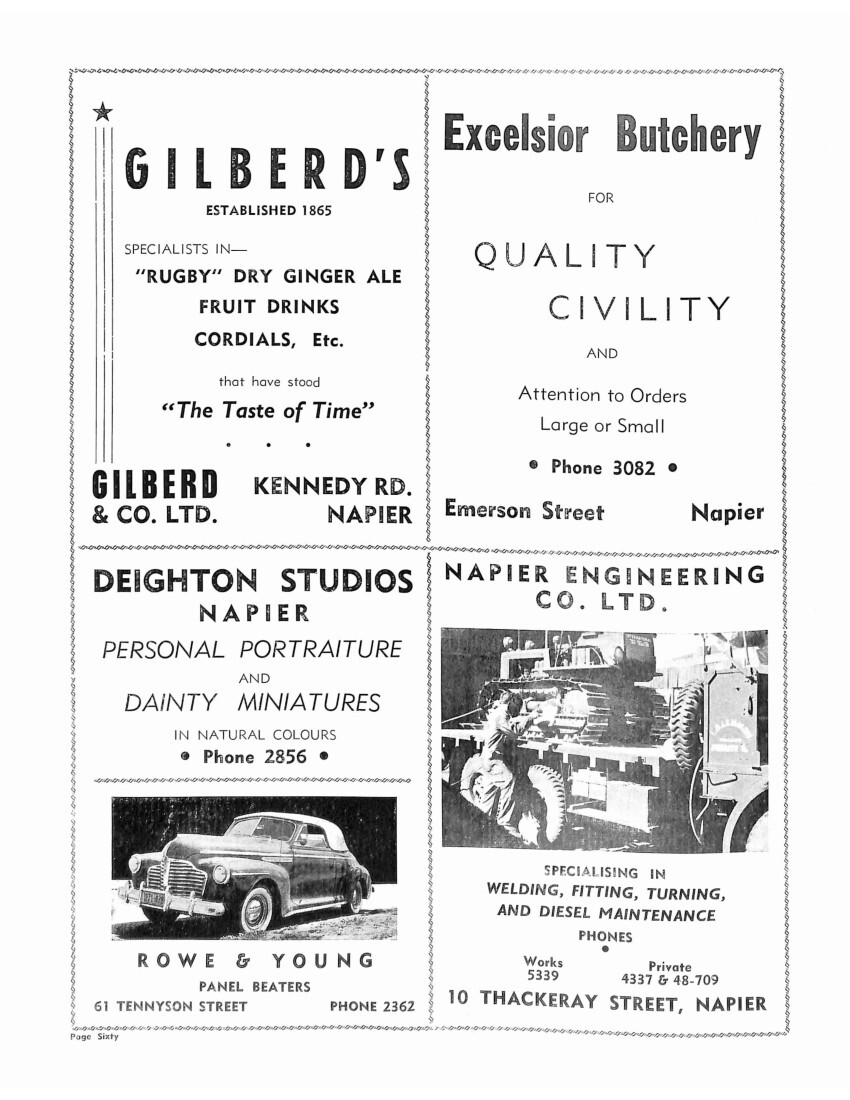
Page Sixty-one
a sorry picture was presented. Residents returned to find the wreckage of their homes buried in silt, 12, 13 and 14 feet deep. Like the residents of Napier in 1931, they were […section missing from book – HBKB]
Photo caption – THE MEMORIAL GARDENS AND CLIVE SQUARE SITUATED AT THE LOWER END OF EMERSON ST.
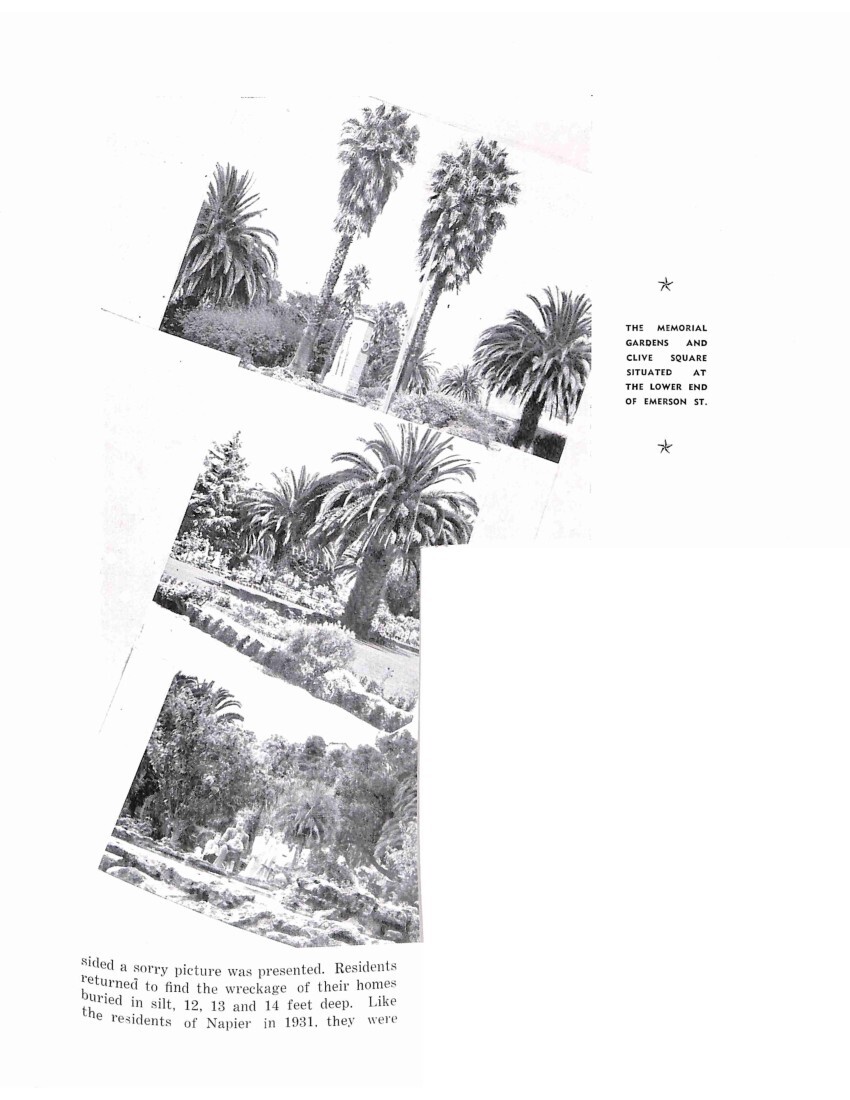
Page Sixty-two
[Advertisements]
TARADALE HOTEL
F.W. McTAGGET, Proprietor
CASCADE BEER A SPECIALITY!
ALWAYS FULL STOCKS OF POPULAR BEERS, WINES & SPIRITS
PHONE 72 TARADALE NAPIER
F. W. ULYATT
Builder and Contractor
All Classes of Private Building Undertaken
Specialising in State Advances and Rehabilitation Loans
ESTIMATES FURNISHED
PHONE
4443
TARADALE RD. NAPIER
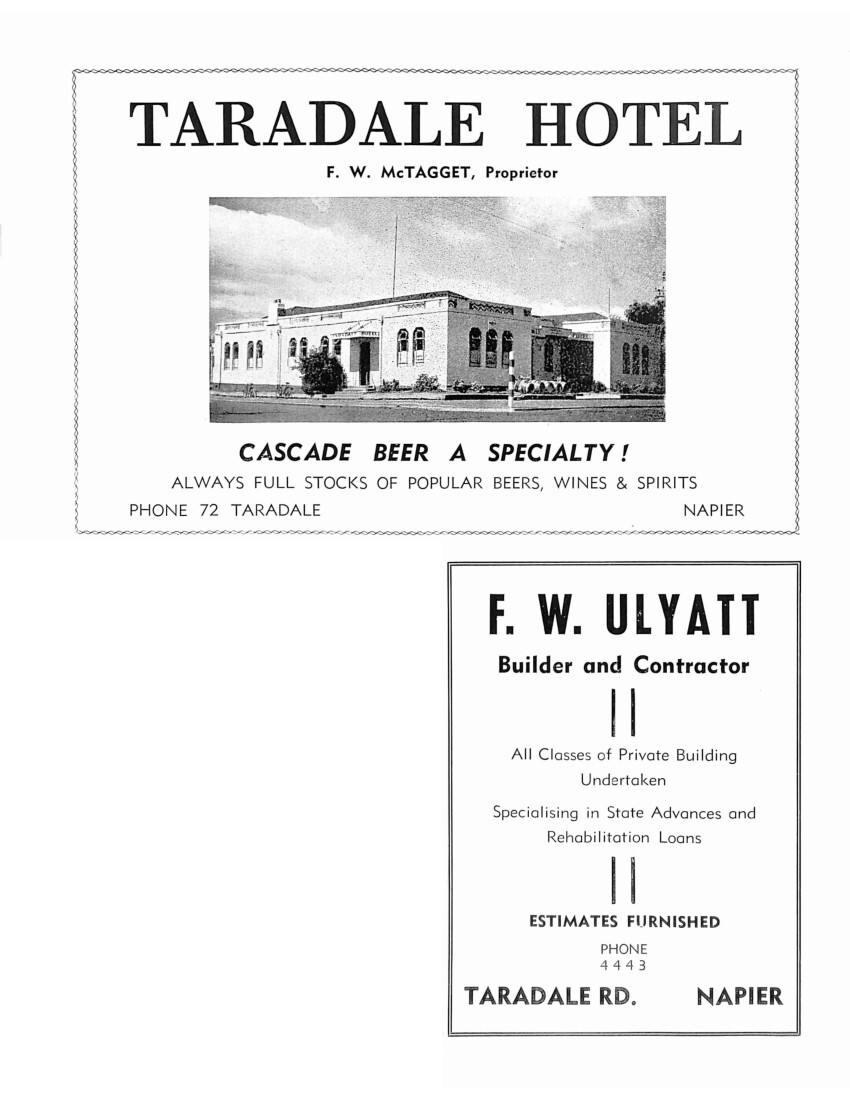
Page Sixty-three
GREEN MEADOWS AND TARADALE, FAST GROWING SUBURBS OF NAPIER.
BY NIGHT – A FAIRYLAND
Napier, at night, is a fairyland. With flowers and gardens to provide the city with colour by day, coloured lights make the picture by night. Balmy Summer nights – when it is certainly a crime to stay indoors – are a feature of the City. At night the City comes out to play on its natural playground of the Marine Parade. During the holiday period the City sets itself out to entertain the thousands of visitors which fill all its hotels, boarding houses and camping grounds. The fame of this entertainment has spread far and wide. It is one of the few places in New Zealand where outside nightly entertainment on a large scale could be attempted. It is a success because of the same foresight which prompted the Napier Thirty Thousand Club in those days following the earthquake to build a sound shell and provide the facilities for public entertainment. With the Norfolk Island pines brilliantly lit in a profusion of coloured lights, the shelter bay, the colonnade and the sound shell following suit, with the putting greens and tennis courts floodlit and the Tom Parker Fountain sending up a cascade of changing colour, the Marine parade at night is something which has to be seen to be believed. It is brimful of interest. It is a common sight to see young men and women, clad only in their bathing costumes, play a hard set of tennis at nine o’clock at night and then cool off with a plunge in the sea. Hundreds of skaters, clad in suitable colourful costumes glide and whirl to music on the skating rink. Perhaps a variety entertainment, free of all charge, is being presented from the Sound Shell, or, if you care for a little game of skill, the side-shows will greet you with open arms. The Municipal Bath is full of patrons and the beach is thronged by happy groups enjoying the Summer nights with song and barbeque. To those who do not wish to take part in the entertainment and do not wish to be entertained – there is still the finest walk in New Zealand awaiting their patronage. Such is the picture of the Marine Parade at night. For those who seek the entertainment of the silver screen or the dance hall, there is ample opportunity awaiting in the city itself, which is well supplied with both forms of entertainment. A fine modern seaside cabaret at Awatoto does thriving business. What more could the pleasure-seeker desire – by day or night. Napier has it all, wrapped up in one grand little parcel of a City. Napier enjoys itself – it wants its visitors to enjoy themselves, too. There is no place in New Zealand where there is a more genuine, bigger, or brighter welcome sign on the mat.
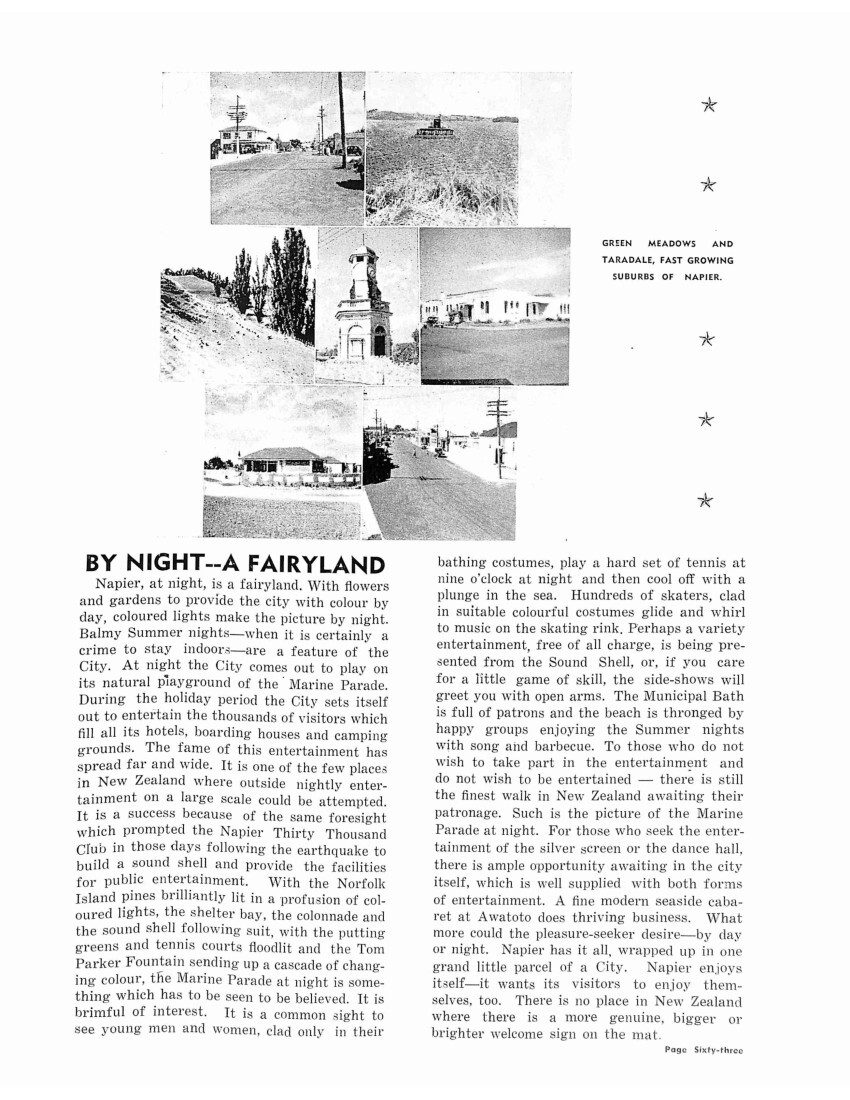
Page Sixty-four
[Advertisements]
BARRY’S BOTTLING CO. LTD.
WHOLESALE MERCHANTS
ALE STOUT WINE SPIRITS
HAWKES’S BAY AGENTS FOR:
DANIEL CRAWFORD & SON LTD., GLASGOW
“OLD MATURED SCOTCH”
ROUYER GUILLET FRENCH BRAND
SACCONE & SPEED DRY GIN
SACCONE & SPEED SPANISH SHERRY
COATES PLYMOUTH GIN
BOTTLERS OF NEW ZEALAND BREWERIES ALES & STOUT
PHONE 2828 WELLESLEY RD. NAPIER P.O. BOX 231
W. L. ATHERFOLD
LIMITED
BUILDING CONTRACTORS
CONSULT US FOR ALL COMMERCIAL & HOUSING CONSTRUCTION
WE SPECIALISE IN ALL TYPES OF JOINERY
Plans and Specifications Prepared. Estimates Given
PHONE 3826
138 WELLESLEY RD. NAPIER
Printed by the Western Printing Co., Ltd. Auckland and published by Astra Publicity, Auckland C.I.
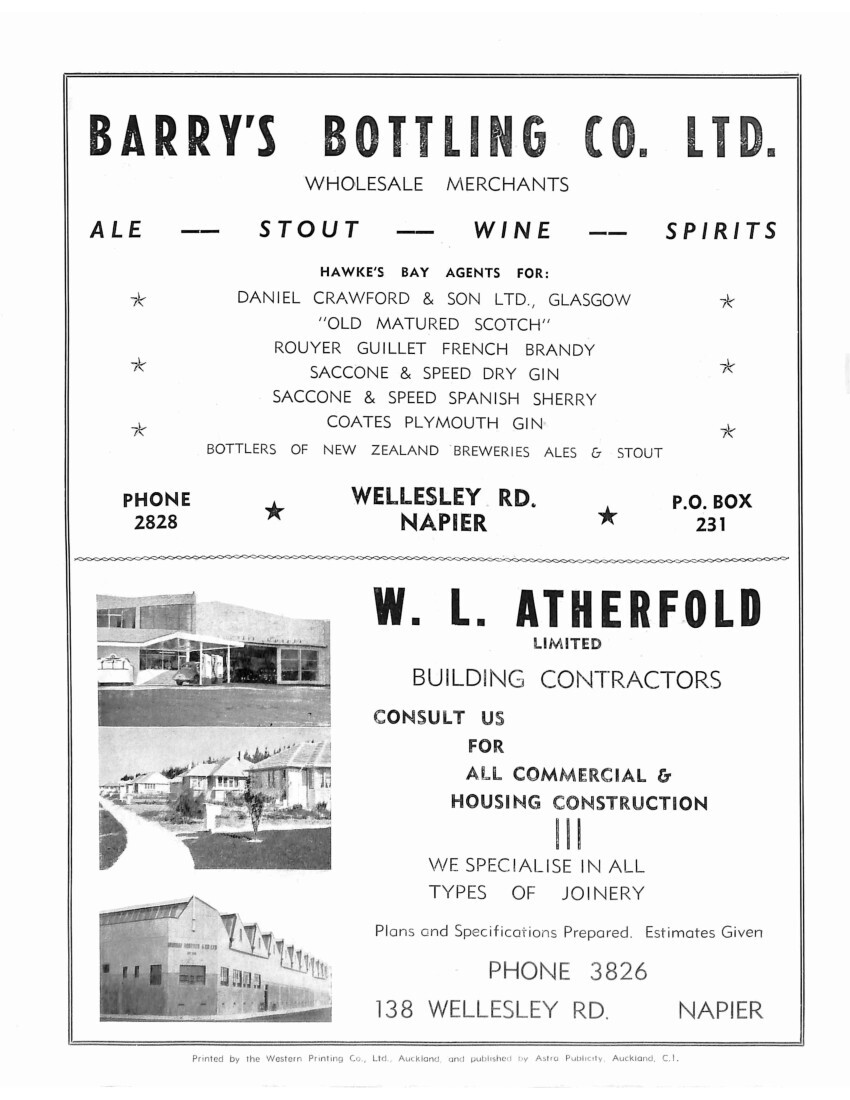
Non-commercial use

This work is licensed under a Attribution-NonCommercial 3.0 New Zealand (CC BY-NC 3.0 NZ).
Commercial Use
Please contact us for information about using this material commercially.Can you help?
The Hawke's Bay Knowledge Bank relies on donations to make this material available. Please consider making a donation towards preserving our local history.
Visit our donations page for more information.
Subjects
Format of the original
Book paperbackDate published
1952People
- Alexander Alexander
- J M Barrie
- F R Burnley
- Reverend William Colenso
- Vivian Cox
- Alfred Domett
- L J Donnelly
- Mr and Mrs A E Dunstall
- Mr and Mrs W T Harvey
- G A A Holmes
- T C Howden
- Mr and Mrs E B Jenkins
- Sir Charles Napier
- E F Nattrass
- Tom Nattrass
- N Paxie
- Roy Pilkington
- I L Prime
- "Barney" Rhodes
- Mr and Mrs Dave Ross
- Mr and Mrs Millar Scott
- E R Spriggs
- C C Willis
- Mr Barton, Campbell

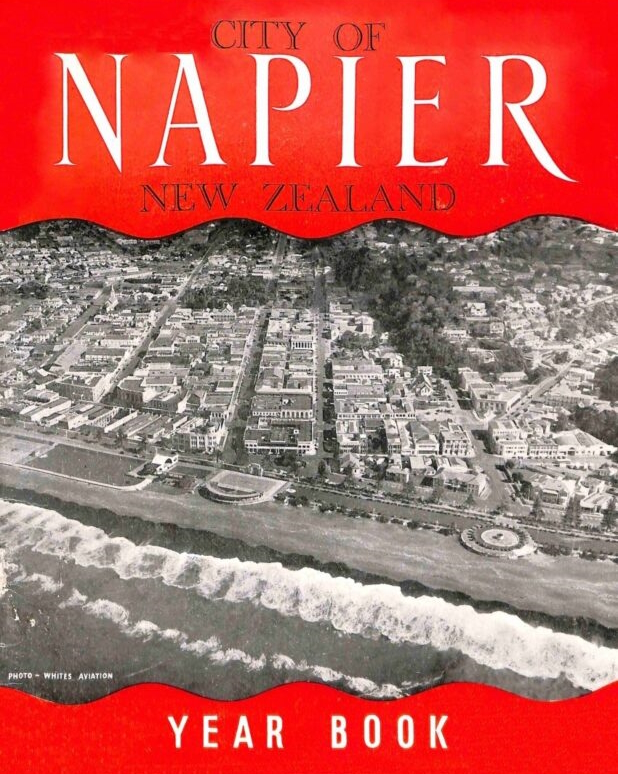
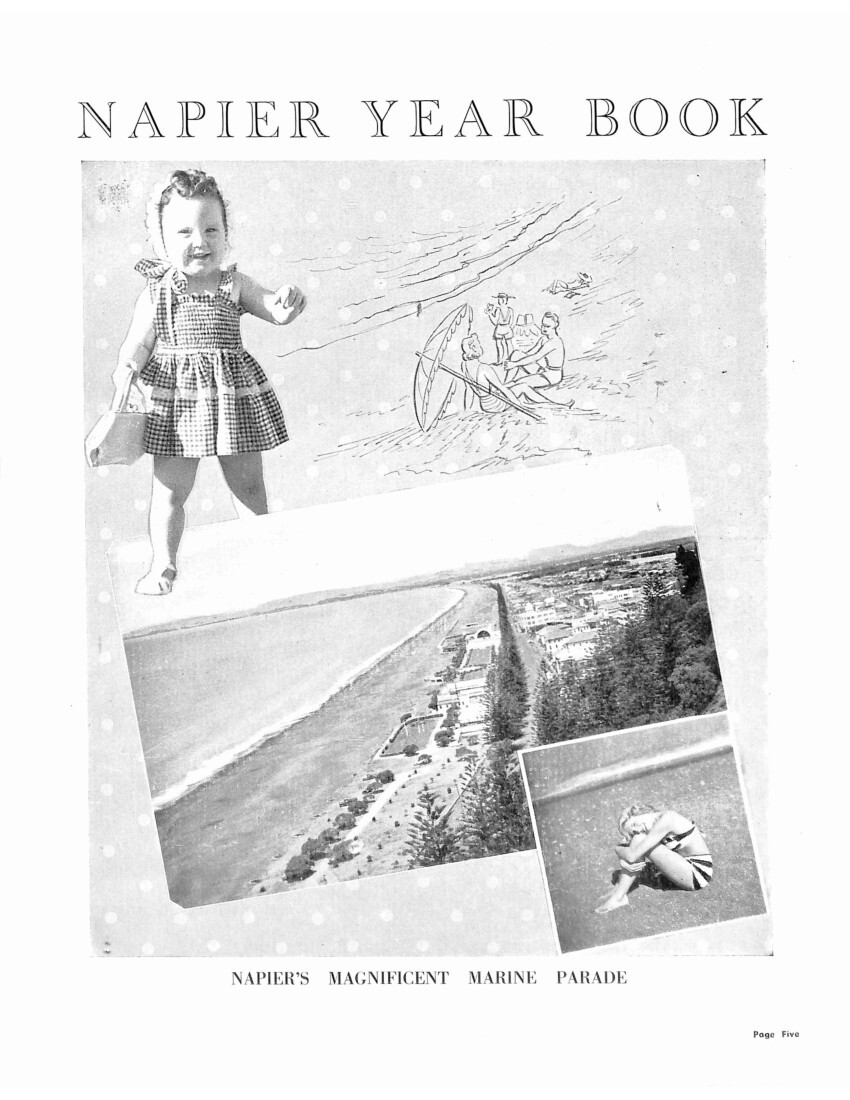
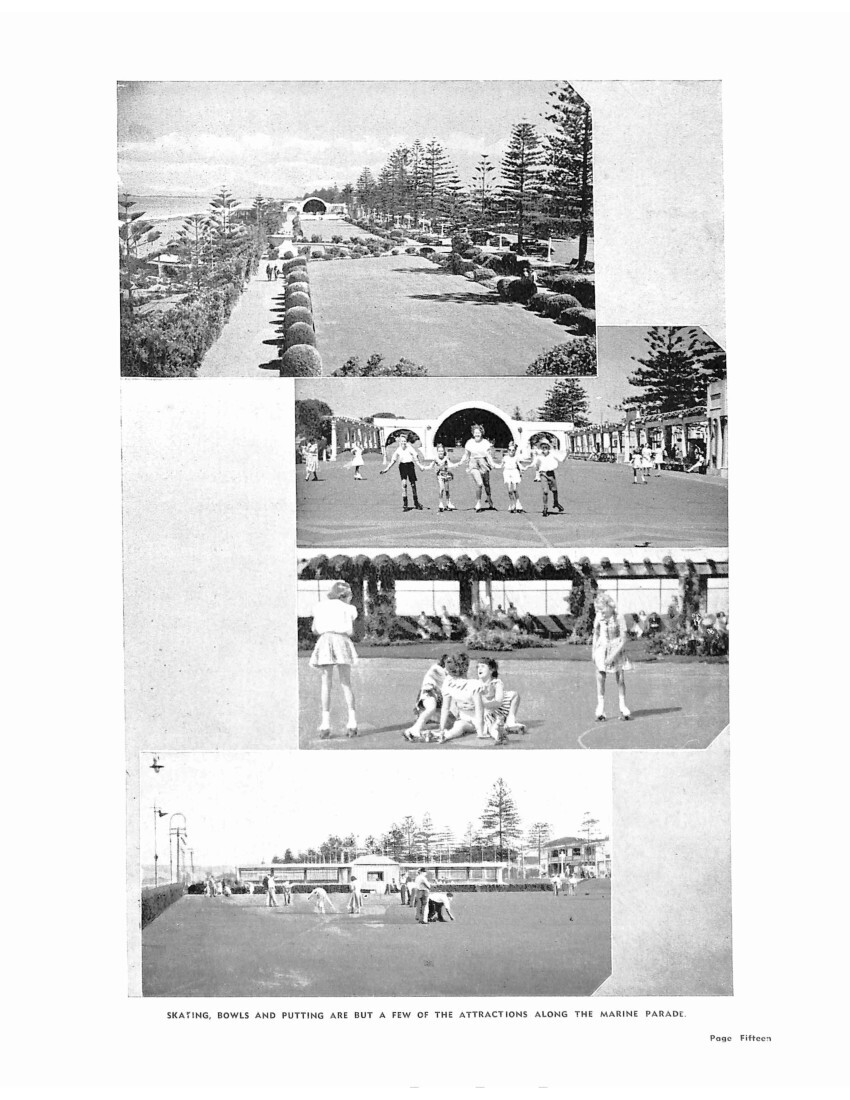
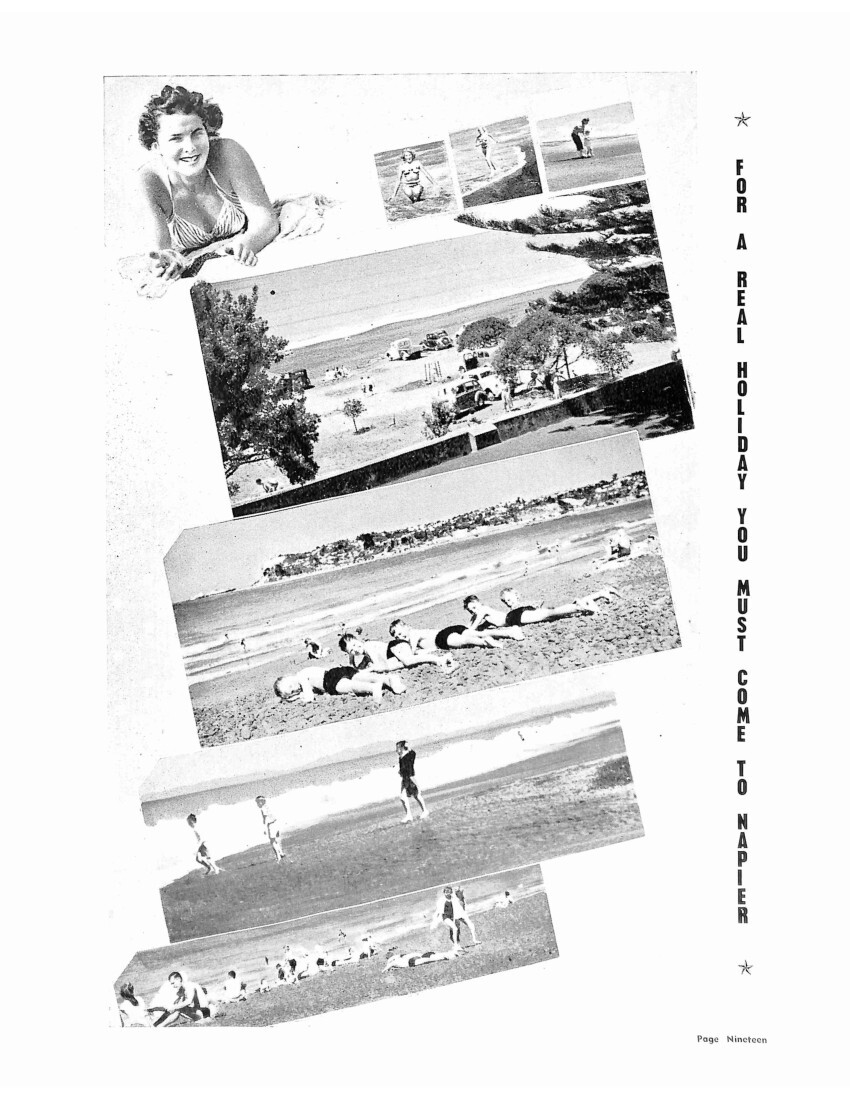
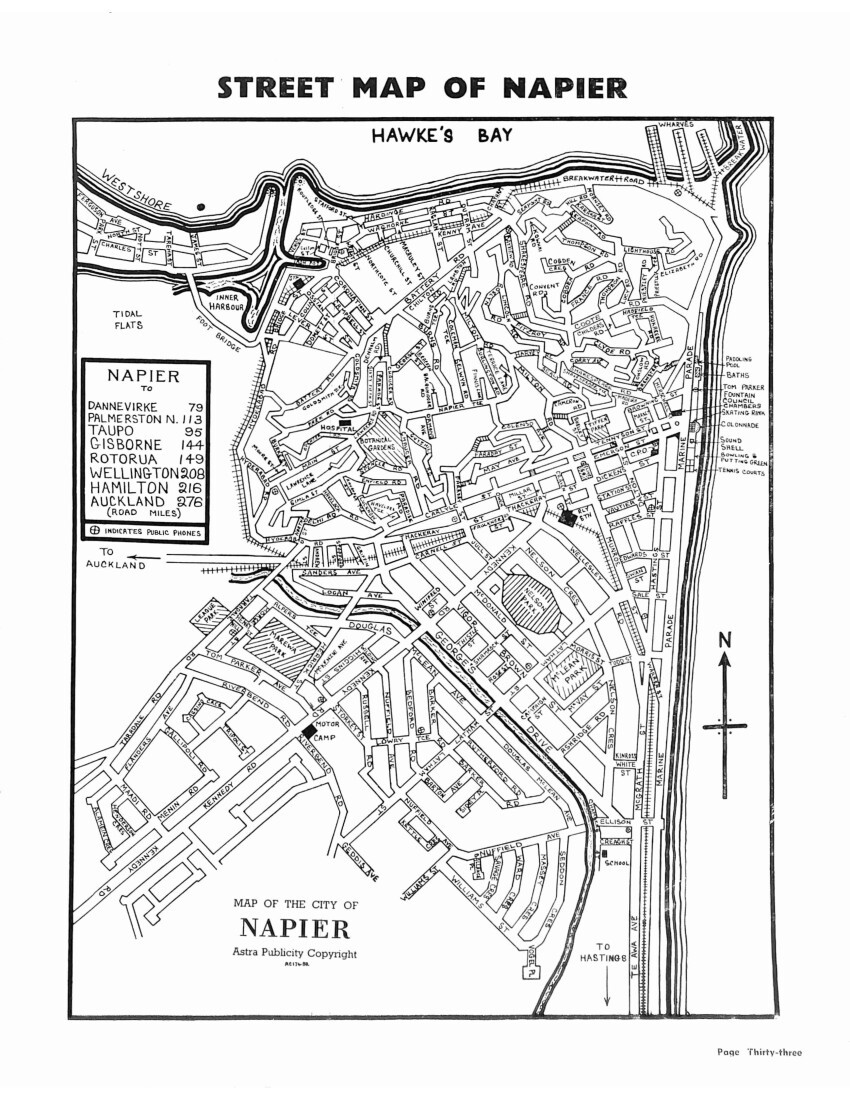
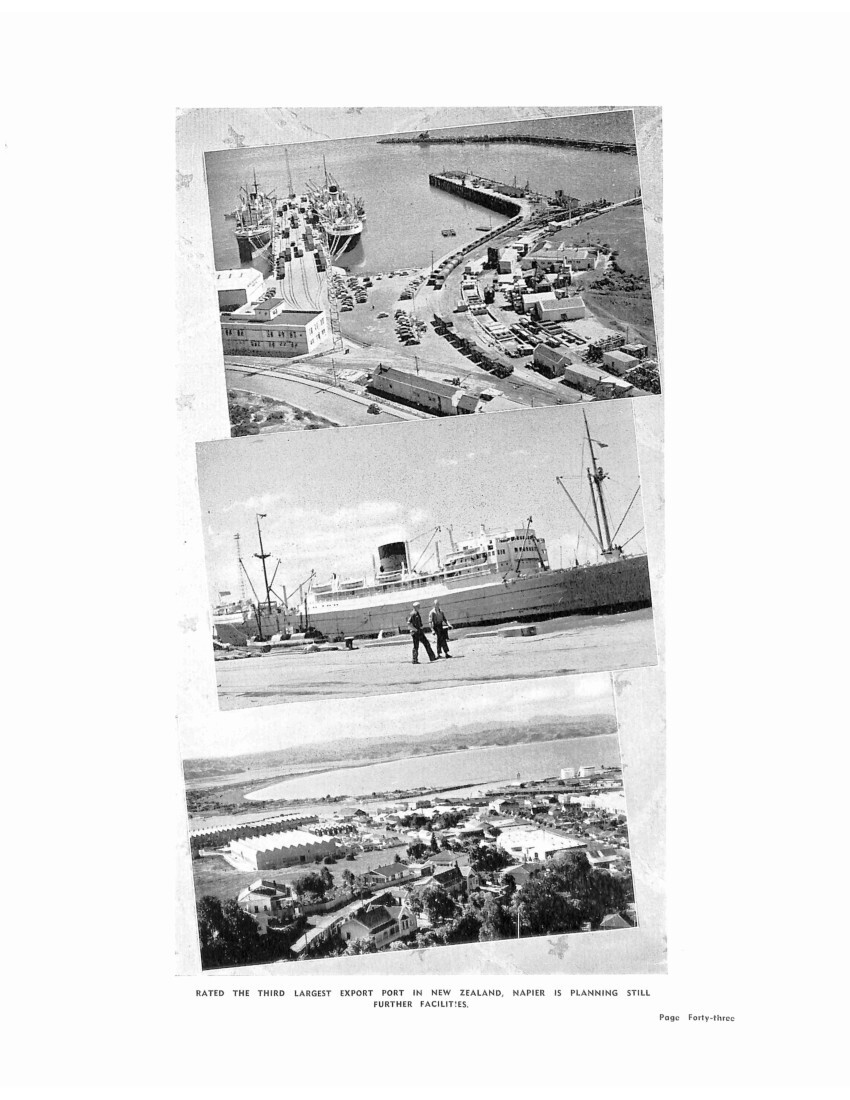
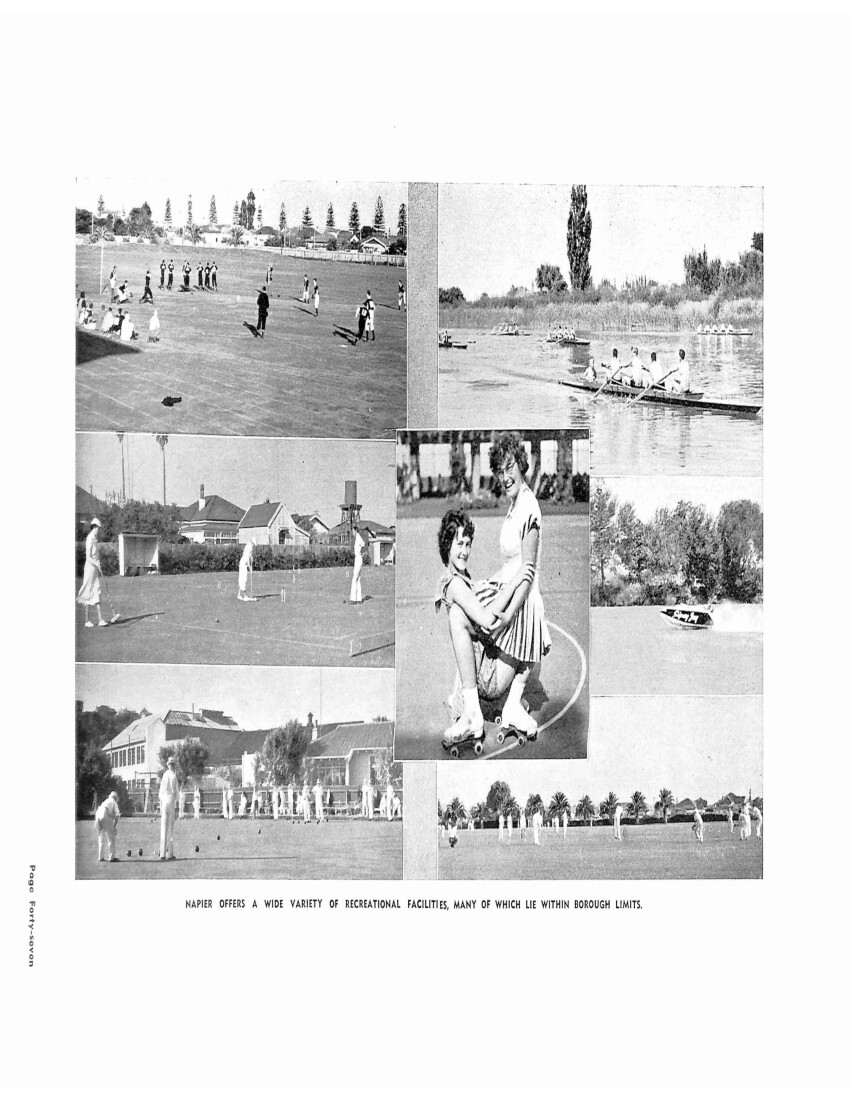

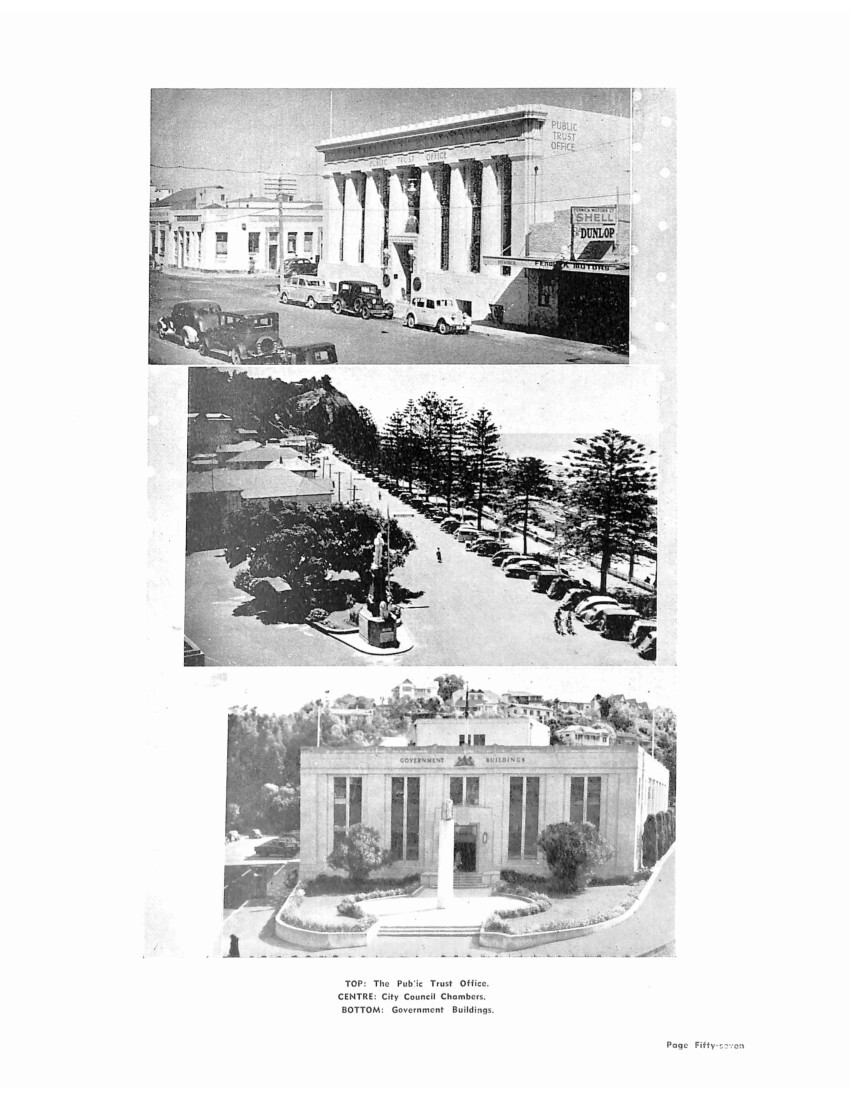
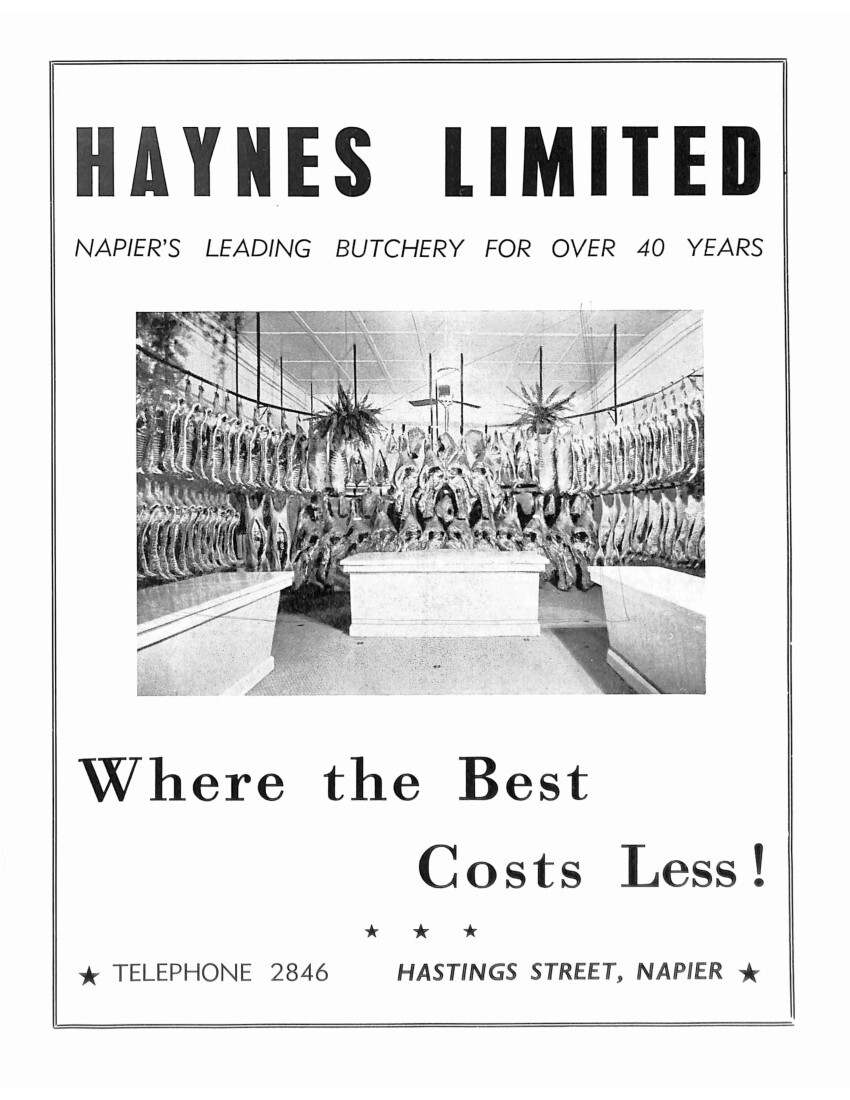
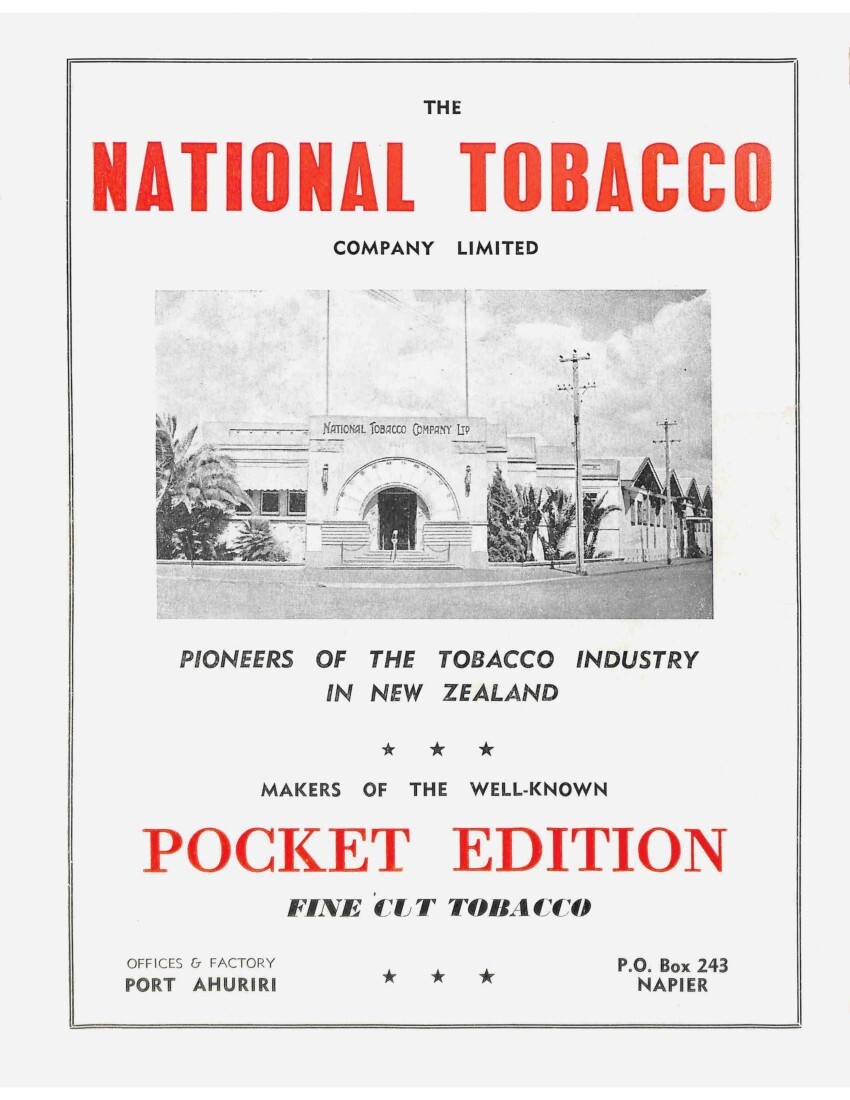









Do you know something about this record?
Please note we cannot verify the accuracy of any information posted by the community.